Trousered Skirts
Red Ribboned Braids
Bleeding Hearts
Installation (various maps of Finland, photographs of Finnish Red Guard women, several film miniatures, sound piece, booklet, trouser cut)
During my scholarship abroad in Helsinki, which was granted to me by the
Federal Ministry of Arts and Culture,
I researched the Red Guard women in the Finnish Civil War of 1918 and developed a work consisting of an installation,
two short film miniatures and a booklet with a film script that could be heard as a voiceover in the room.
History has been predominantly written from a male perspective, and this is even more true of war history. However, I’m interested in the women in
history
and women’s perspectives on history.
In the Finnish Civil War, women were involved on
both sides, as "Reds" and "Whites" – socialists, workers and intellectuals, versus the conservatives, bourgeois,
landowners, the capitalists – and some of them actively fought with weapons and in trousers.
Also, the "Red" women tied their hair and put it under caps, some of them cut it short — an affront to the “Whites”,
who saw the traditional image of women and thus the given order under attack.
Women’s guards were founded in the spring of 1918, their members took on guard duties in supply, care and administration,
but as the war progressed and the Reds suffered increasing losses, women proved their suitability for frontline service.
During my research, I came across several staged studio photographs of young women, all of them in men’s uniforms. This caught my attention,
and from there I started my research on women involved and killed in the civil war leaving hardly any traces but entries in the
War Victims of Finland database.
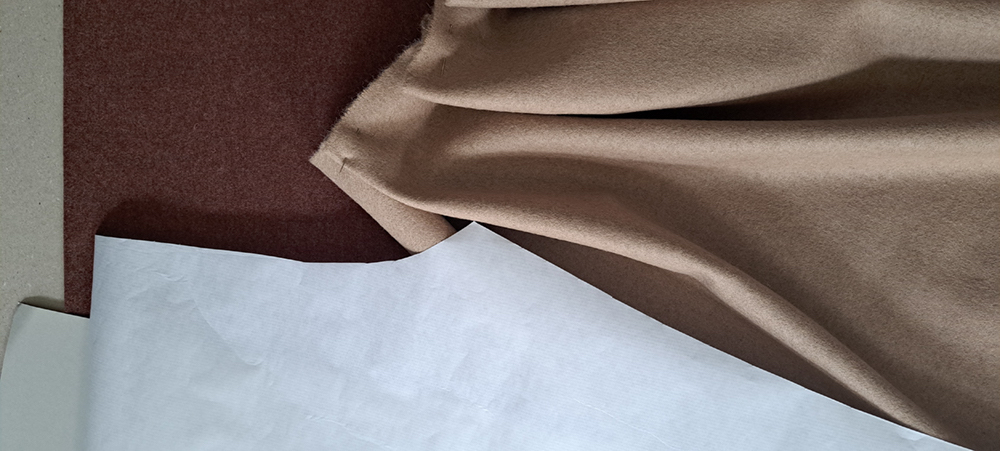
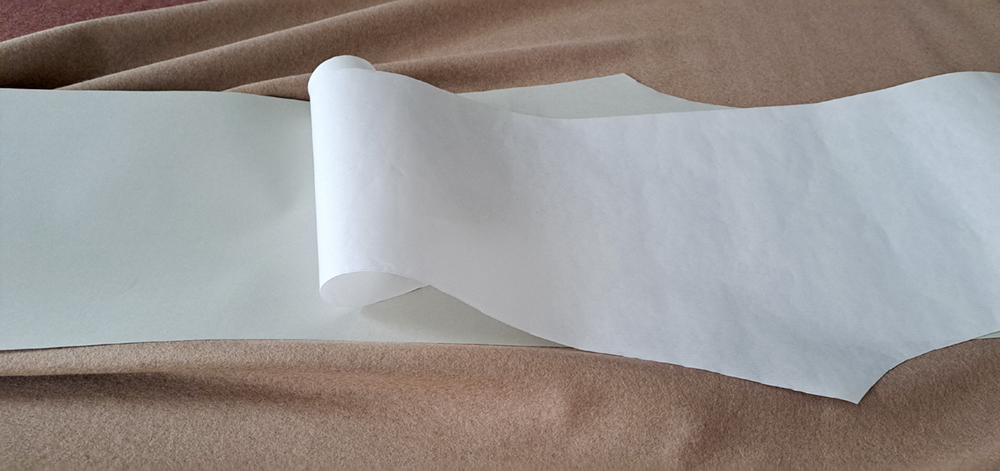
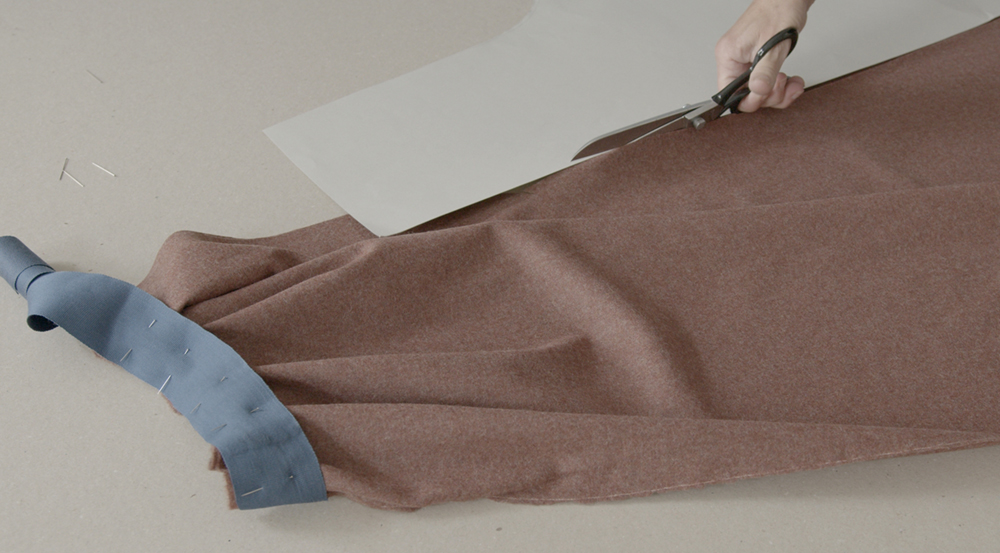
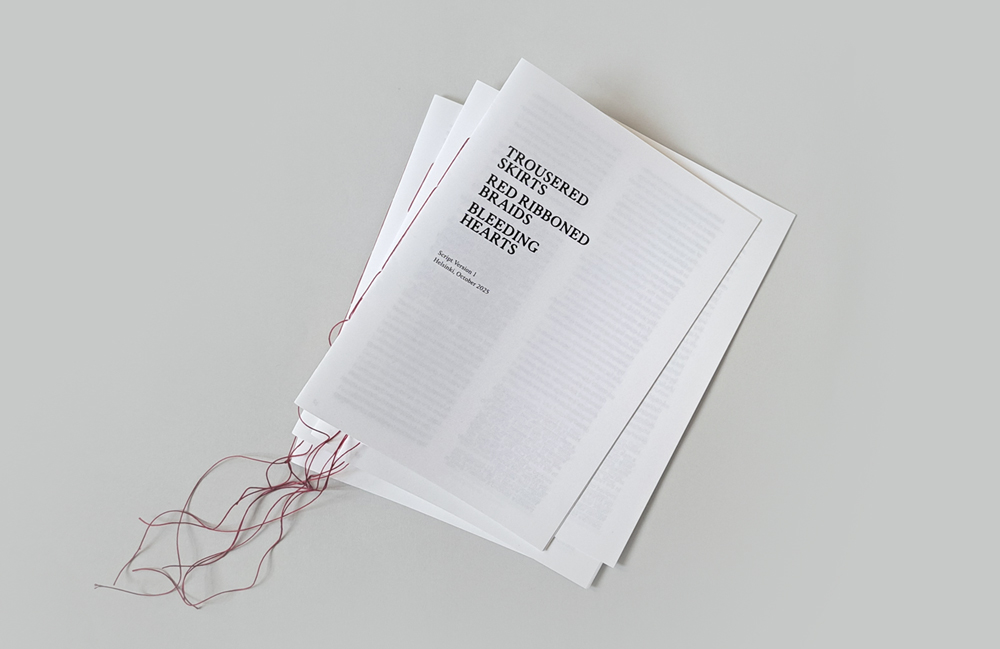
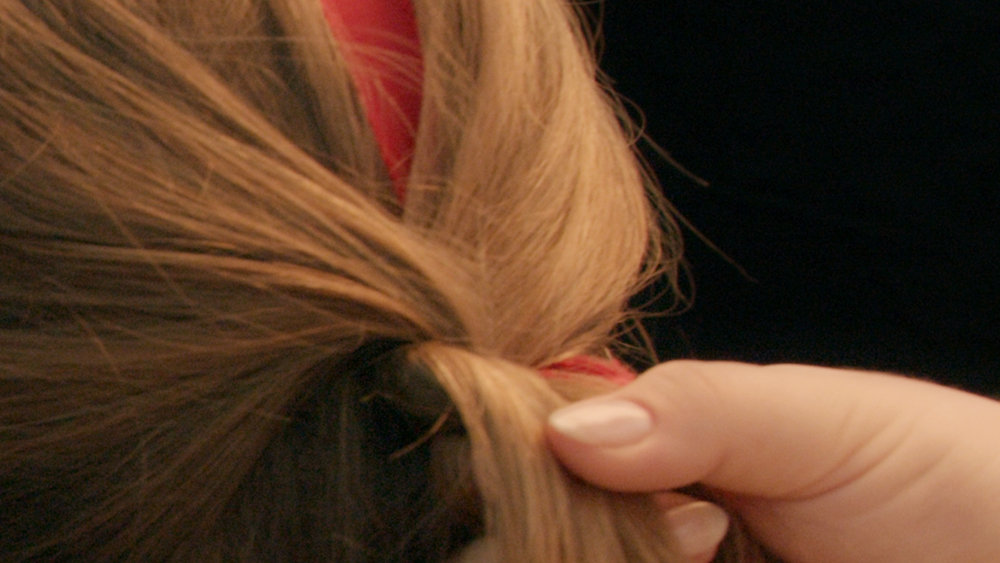
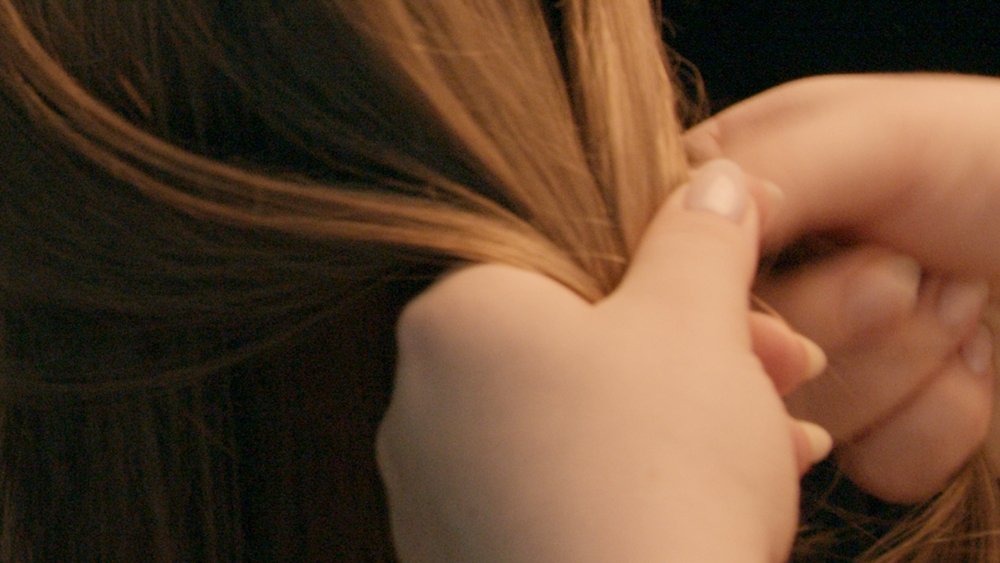
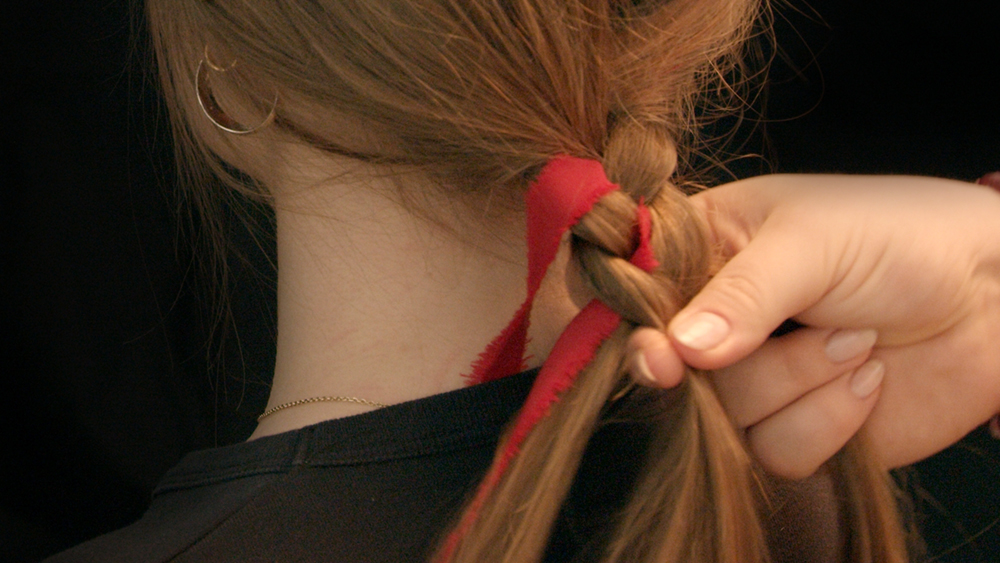 Stills from sketches for film miniatures
Stills from sketches for film miniatures
re-SISTING
(planned)
Film
As part of my planned trilogy and the follow-up to
re-VOLTE and
re-WEAVING, essay films about (queer)feminist/women artists/
activists who have been engaging with women’s and gender issues, in
re-SISTING I focus on 3 women resistance fighters in the region of Val d'Ossola in Piemont, Italy.
Cleonice Tomassetti, Gisella Floreanini, Maria Peron, three different women who joined the Partisan movement in the Swiss-Italian border region.
Two of them survived, one became the first female minister of the Repubblica Partigiana dell'Ossola, later of the Italian Republic;
the other returned to work as a nurse and later died of radiation.
re-GUÉRILLÈRES
(planned)
Installation + film
In
re-GUÉRILLÈRES I would like to adapt Wittig's
Les Guérillères into a poetic, cinematic,
choral production and examine the novel and Wittig herself from a contemporary critical perspective. To this end, I'd like to research and
collect background information that goes beyond the book.
The novel was written in 1971, and since then much has changed in the debate on sex and gender – unfortunately much has remained the same.
How should Wittig be read today? Is her approach from 50 years ago still relevant or already outdated? In an age when sex changes are no longer
uncommon and young people have already developed gender awareness, Wittig's texts sound almost outdated.
So what was progressive about her thinking? How can I translate her text poetically?
In the novel, Wittig repeatedly features different flowers, possibly as a counterpoint to the warlike strategies for seizing power by (the) women;
possibly a reaction to the positions of Ursula Le Guin or the early Donna Haraway – or even an anticipation of ecofeminist concepts.
In any case, they are to play
a kind of ‘leading role’ in my work: in the cinematic part on the visual level in various constellations and in the installation arrangements.
The Guérillères themselves are to be shifted mainly to the audio level; only their voices can be heard, speaking and singing
specific passages of text individually or as a choir, once or repeatedly, thereby developing a space-time dramaturgy.
re-WEAVING / a feminist fabric
2025 / Video installation / 6K/HD / 16:9 / colour / sound / 18 min
Video / 6K/HD / 16:9 / colour / sound / 23 min
"It’s all about weaving, everything’s fabrics, everything is linked to the textile sector. We need clothes,
we wear clothes. We distinguish ourselves through fashion codes. The industry capitalises on this. Progressive modern technical developments and
improvements, automation processes increase the production but worsen the situation of weavers and factory workers: Looms replace the workers who
are forced to 14 hours low-wage labour in textile factories, laundries, spinning mills, becoming machines themselves as well.
Women workers are struggling double" – this is the beginning of my new film project
re-WEAVING / a feminist fabric which is organised like
a warp and weft structure-wise: Political and artistic concepts alternate. The political thread includes the class struggle, the social question,
the woman question, socialist/marxist concepts and feminist liberalisation movements. What does it mean to be politically active?
What does queer/feminist anti-racist resistance, activism mean actually?
To what extent are we able to struggle, fight, to endure suffering, to bear hardship, to take risks, even deadly ones?
The film is also an exploration of my personal history of socialisation and of the influence of role models as well as the reflection on thoughts,
positions and claims of queer/feminist activists over the last century. The thread (of patience) is long / torn. We re-write our stories.
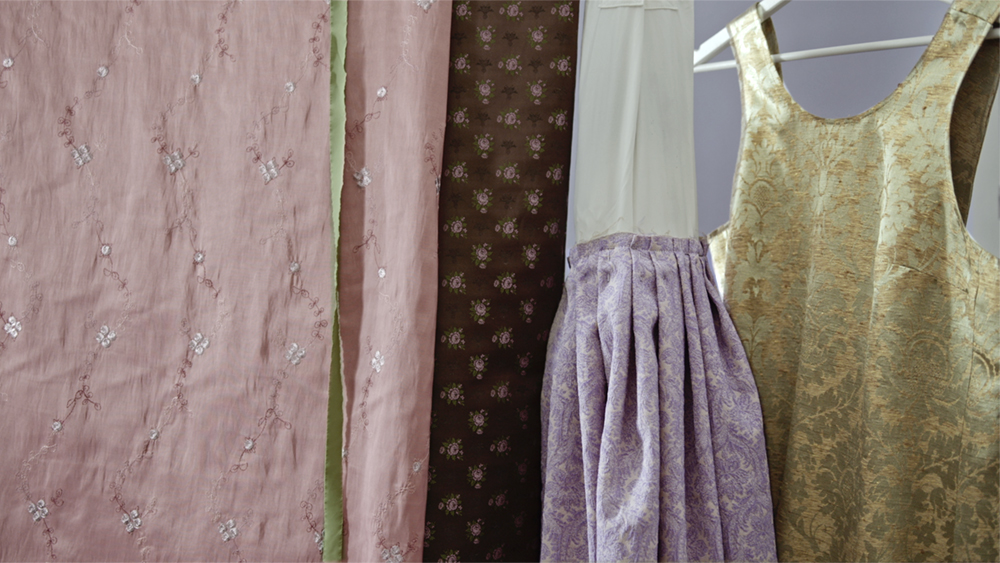
In my essayist film
re-WEAVING / a feminist fabric,
I'd like to shed light on relevant feminist positions and demands against the backdrop of developments in textile production and industry.
To this end, I relate protagonists from the fields of politics, art and activism from different periods with different attitudes and positions to
each other and develop a fabric of ideas that makes their motives, motivation and resistance comprehensible,
rendered by a narrative voice that constantly changes perspective.
Using a multi-layered narrative structure composed
of analogue and digital archive material, images of artistic works and publications, I interweave the past with the present, historical figures
and current queer/feminist positions and strategies of collectively opposing patriarchal structures.
Why not abolish the binary principle of warp and weft in favour of a anti-patriarchal, anti-capitalist, non-binary mode of production
and spark an intersectional revolution? Struggle needs collective action. That's our direction.
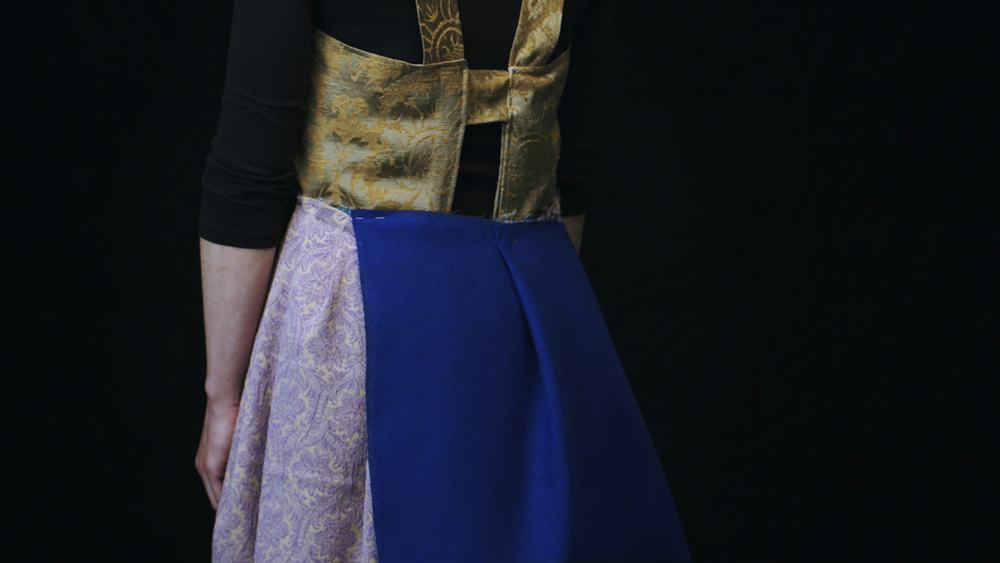
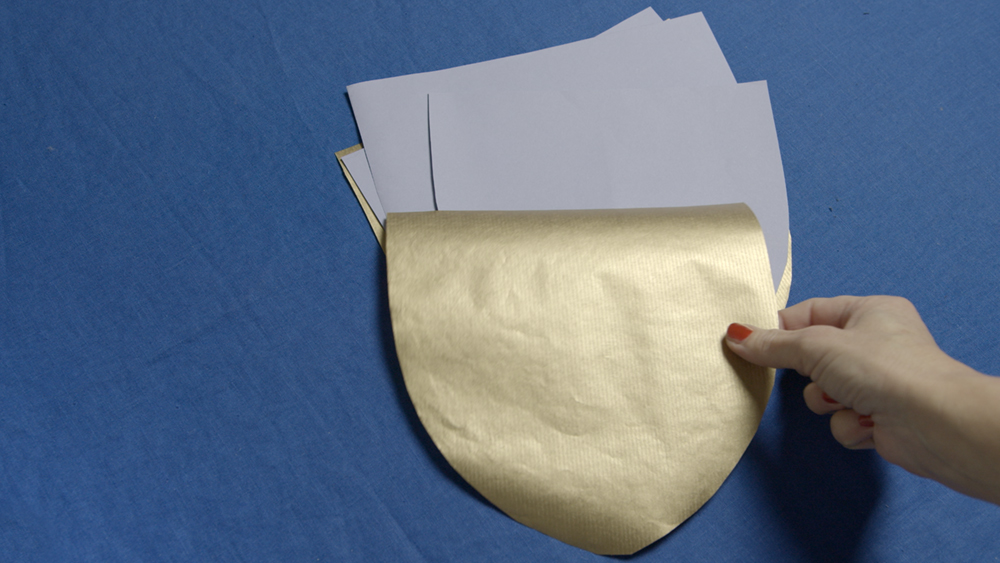
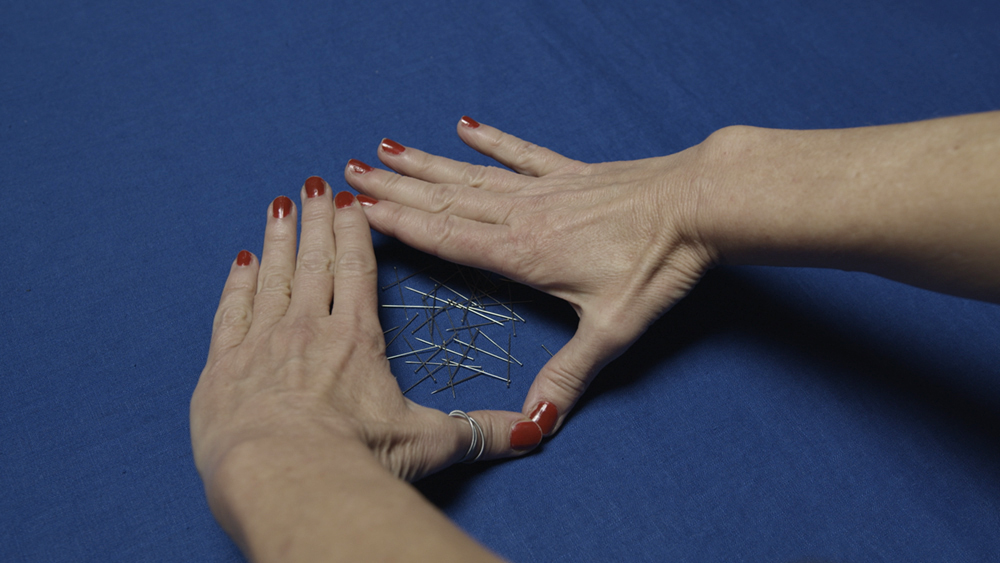
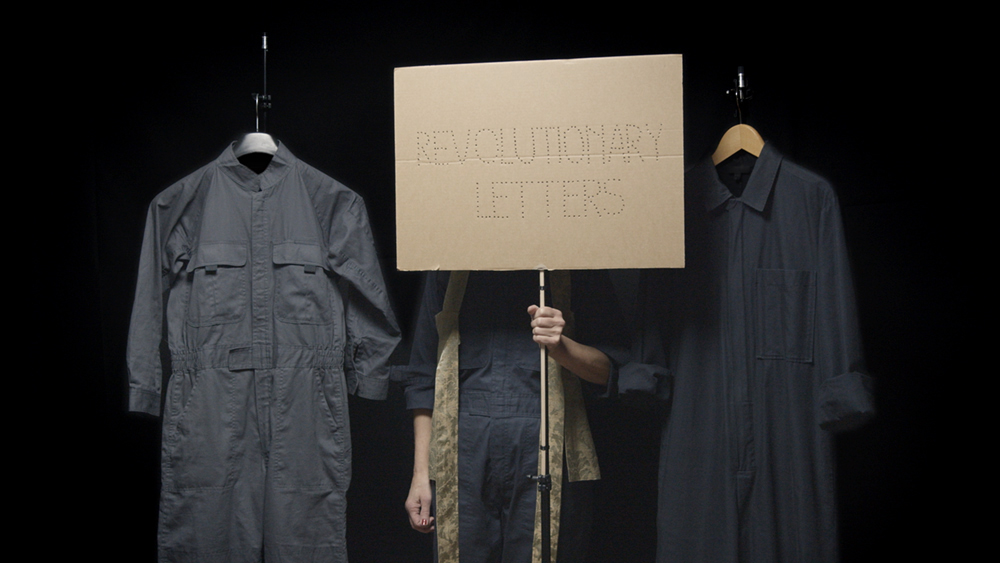
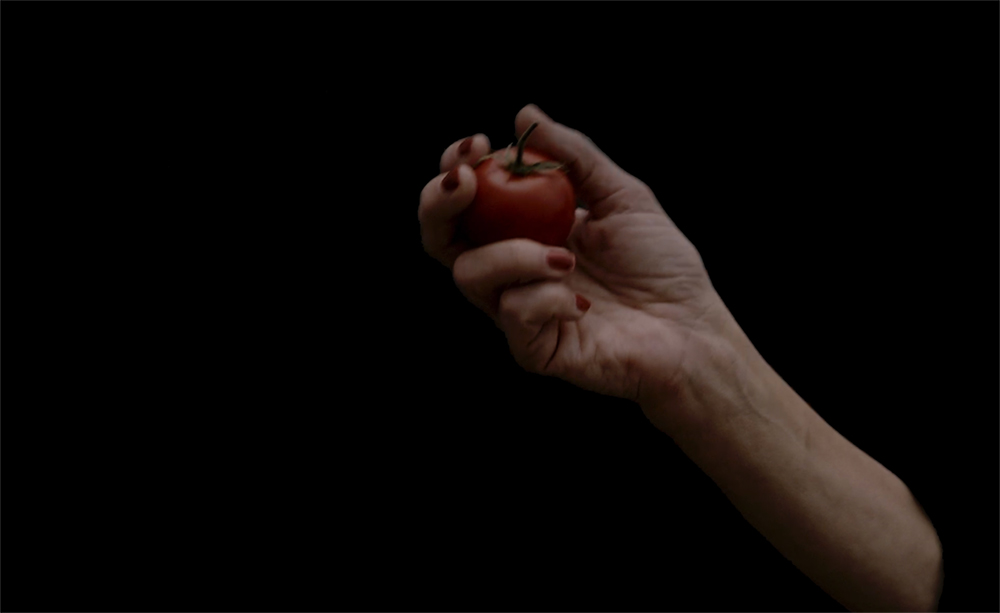
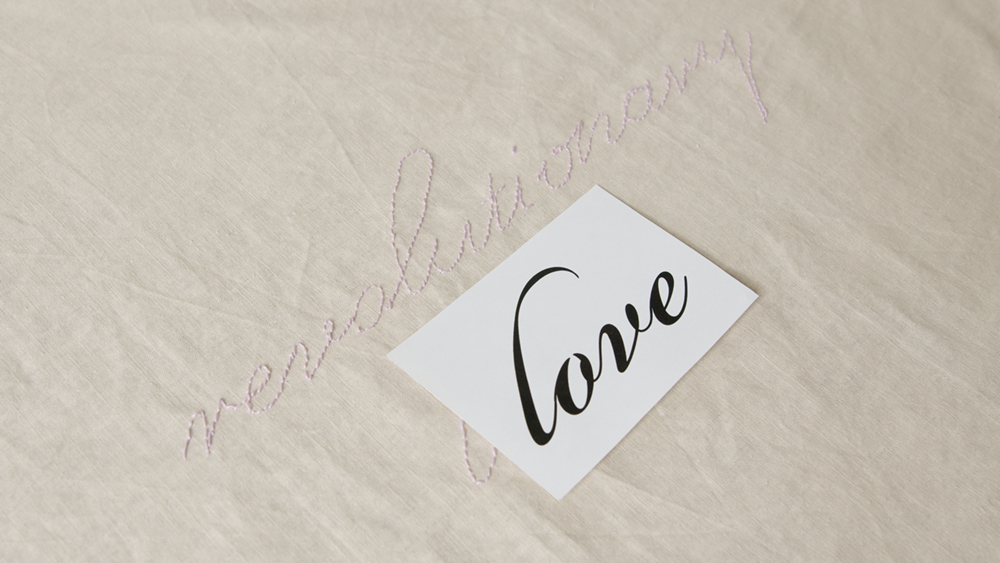
The film miniature and installation
gewebeproben at
Blickle Raum Spiegelgasse Vienna functions on several levels:
set pieces are arranged in an open installation – sketches, drafts and research material for the film
re-WEAVING / a feminist fabric.
Various aspects of the narrative form and thus of the narrative itself become recognisable by processual interweaving of the inner and the outer
structure, of content and form.

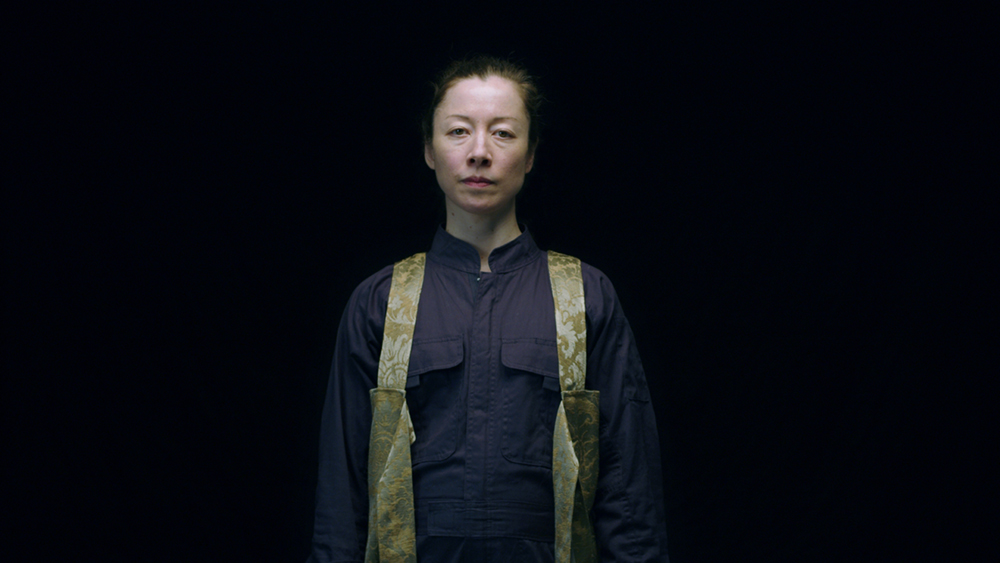
Credits:
Concept | script | set design | edit: Michaela Schwentner
Cast: Nina Fog, Michaela Schwentner
Narrating voice: Nina Fog
Camera: Martin Putz | Michaela Schwentner
Costume design: Michaela Schwentner
Golden vest: Natures of Conflict
Dressing assistant: Julia Cepp
Sound design: Nik Hummer
Supported by Stadt Wien Kultur and Ursula Blickle Stiftung
re-WEAVING / gewebeproben
2025 / Installation in a modifiable cardboard display by
Peter Sandbichler
Fabric samples, different sizes, cardboard boxes / video (6K / 16:9 / sound / colour / 7:30 min)
"Michaela Schwentner's current film work thematically revolves around the history of the textile industry.
gewebeproben is a complex intervention that resembles a sketchy snapshot of the project's creation and research process.
Similar to a work situation in a workroom, she arranges samples on a large table. She arranges, labels, indexes, dates and reveals her methodology
of artistic approach.
A sequence of thoughts on the way to the completion of the film is visualised and thus made visible to us. A selection of women politicians,
political and feminist activists as well as designers and artists stand in on the one hand as wearers and on the other as producers in a
historical narrative of textiles. At the same time, the assemblage functions as a legend of the film miniature, the projection of which can be
seen through the window in the slanted wall surface. The film's protagonist is getting dressed, fabrics are layered and pinned.
The separate room in the installation is a kind of dressing room, activities and movements follow their own immanent choreography.
The voiceover opens up another level and poetically refers to weaving and knotting, which both metaphorically and technologically
far beyond the production of raw materials for the textile industry: ‘What would our future fabric be made of?’
The costumes hanging on the opposite side of the space add another aspect to Schwentner's artistic practice: filmmaking.
The film miniature was shot at Blickle Raum Spiegelgasse before, the costume was one of the props in the production process.
The installation
gewebeproben creates a dense network of references that examines socio-economic contexts under the aspect of
feminist claims. Historical narratives are critically scrutinised and artistically transformed.
Michaela Schwentner links external socio-political and internal contexts of textile and image production in poetic sketches.
She uses Peter Sandbichler's installative cardboard work as a spatial environment. The sloping wall surface not only defines the space and
divides it into a front and a back, but is itself a sculptural body. The work table is an object of volumes and surfaces on which the artistic
positions, fabric and cardboard, begin to vibrate permeably." (Blickle Raum Spiegelgasse)
The film miniature
re-WEAVING / gewebeproben is both part of the installation and a stand-alone short film.

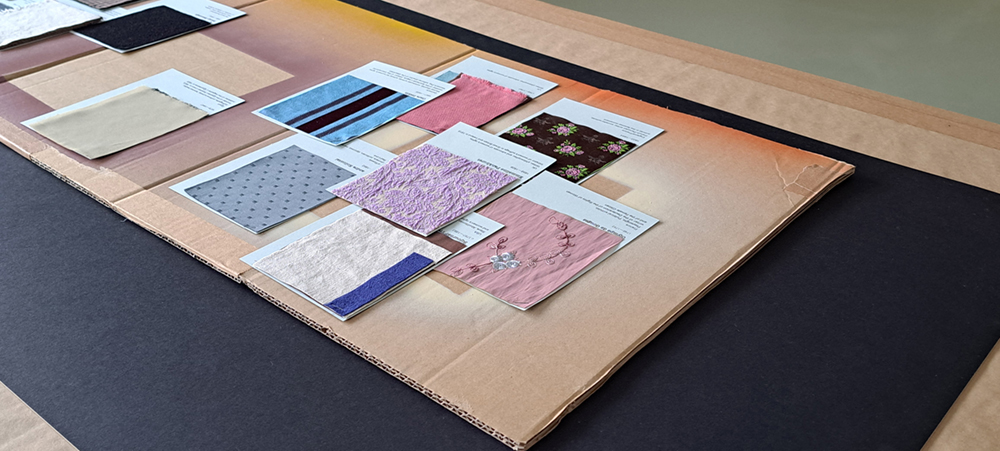
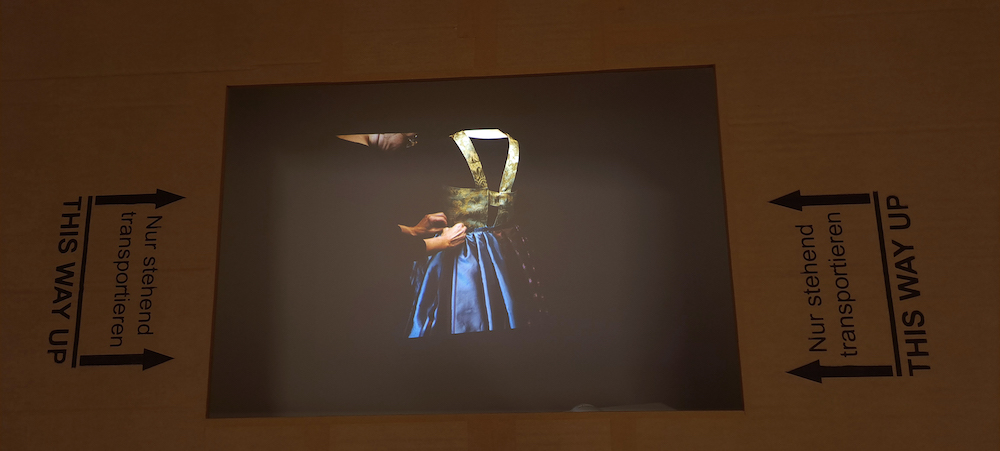
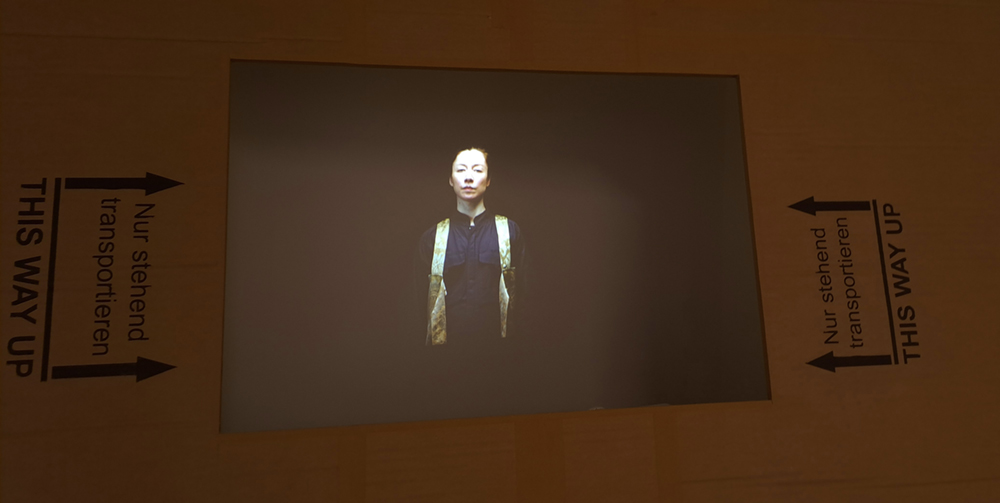 Exhibition views Blickle Raum Spiegelgasse,
Vienna; display developed together with Peter Sandbichler
Exhibition views Blickle Raum Spiegelgasse,
Vienna; display developed together with Peter Sandbichler
Credits:
Concept | script | set design | edit: Michaela Schwentner
Cast & voiceover: Nina Fog
Camera: Martin Putz
Costume design: Michaela Schwentner
Golden vest: Natures of Conflict
Dressing assistant: Julia Cepp
Sound design & mastering: Nik Hummer
Supported by Ursula Blickle Stiftung
re-treat
2024 / Installation / Landi chair replica, wooden slats, cable ties;
series of 5 Fine Art Prints, 90cm x 50cm
The Sciaredo residence is a place of retreat. In this respect, a raised hide, a high seat in the grounds
of the residence is a double retreat.
During our stay
at Casa Sciaredo in August 2024, I installed a raised hide on site together with Nik Thoenen.
re-treat is a tribute both to Georgette Klein and
Hans Coray who designed the so-called Landi chair for the 1939 Swiss National Exhibition.
Georgette bought a stack of 4 pieces for her modernist house
in Ticino, which is evidence of her confident taste
in contemporary design.
She was progressive, ambitious and yet she sought solitude, which she found in Ticino, as my film
re-GEO / rendering reconstructions of desire highlights.


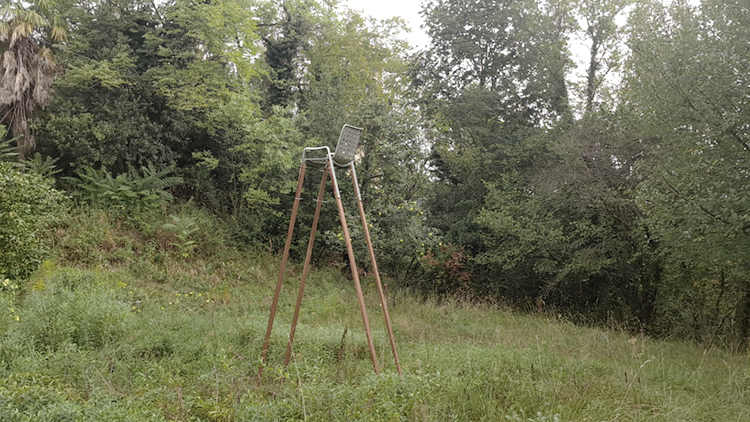
ristrutturare qualcosa
2024 / Installation / scaffold, sprinkler net, tension belts, beamer;
projection of re-GEO / rendering reconstructions of desire
Framing landscape by reconstructing memories.
A model construction, adapted reconstruction of
a building, a structure, a display.
Construction for the projection of
re-GEO /
rendering reconstructions of desire realised on site in 2021.
Our project, which we realised during our residency
at Casa Sciaredo in August/September 2024, demonstrated our approach of processual inter-
weavings of themes that we explore both together and in our solo projects. The critical questioning of modernity with all its demands and
consequences as well as the desire to restore the balance between our society and all other forms of life to which we are directly or indirectly
dependent are always important aspects. In our artistic practice we work primarily in a process and modelling way.
We develop temporary modules from set pieces of content and form, which we can re-assemble again and again.
During our stay at Casa Sciaredo, we approached
the architectural concept of the house and a characteristic of modernism via a sketch in the form of a simple frame: the right angle as a
technical inscription in a ‘natural’ environment. We transferred
it out of the building into the garden, the landscape, where it was placed performatively and poetically in this ‘natural’ space as a referential
miniature of the original, so to speak, and became a dispositive for processes of investigation and play. Appropriatively, we carried out various
interactions, constellations
and configurations on the construction, a simple rectangular frame made of scaffolding elements.
In my artistic practice in particular, the frame is a dispositive in several respects: model, space and template for action, sketch, frame.
Here, too, it worked as a framework within which we could reflect on practices that are located between technique, technology, aesthetics and
poetics. Nik Thoenen shaped the construction processually, I documented this performative intervention on film and photographically.
In addition, we projected the film about Georgette Klein and the Casa Sciaredo,
re-GEO /
rendering reconstructions of desire, which I realised largely on site in 2021, onto the construction and thus
juxtaposed the sketch, the model, the model in the model, with the Casa.
The permeability of the material used encouraged reflection on the history of the site, on the construction of the Casa and the reconstruction
and sketching of the modern building (via the right angle) and opened up a space that allows criticism of the right angle, as it were.
The in-between is what moves and interests us, the temporarily visible and invisible in equal measure, from which something more
always emerges, the poetic that reaches beyond what is perceptible at the moment - and possibly remains.
Developed together with Nik Thoenen during the artist in residence stay at Casa Sciaredo in August 2024
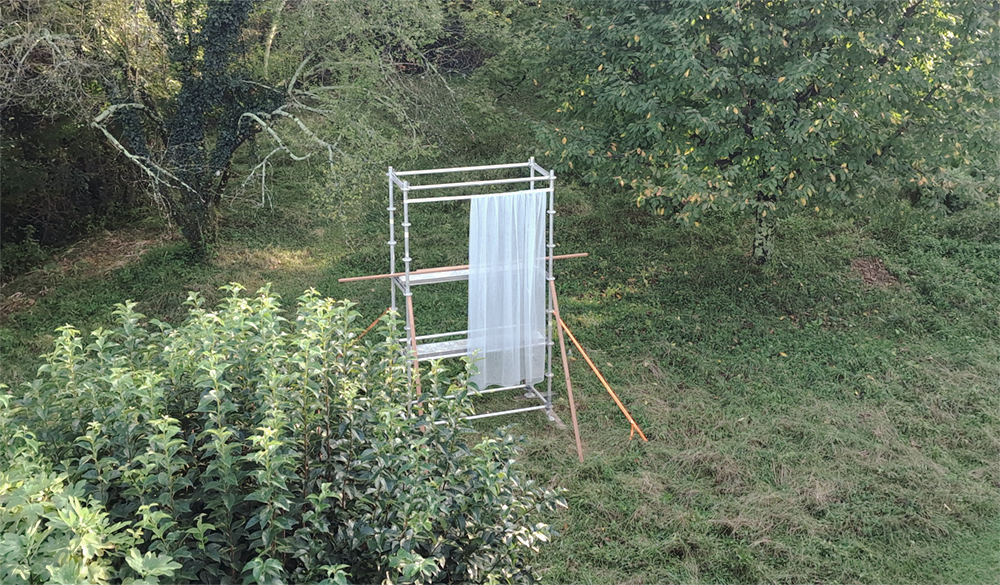
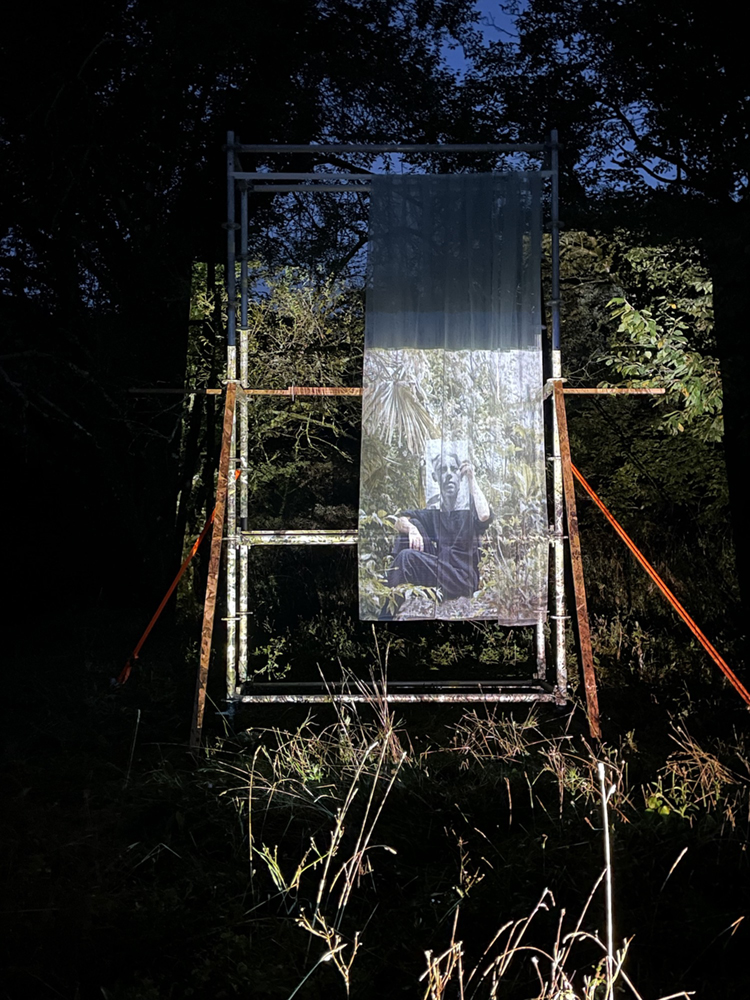
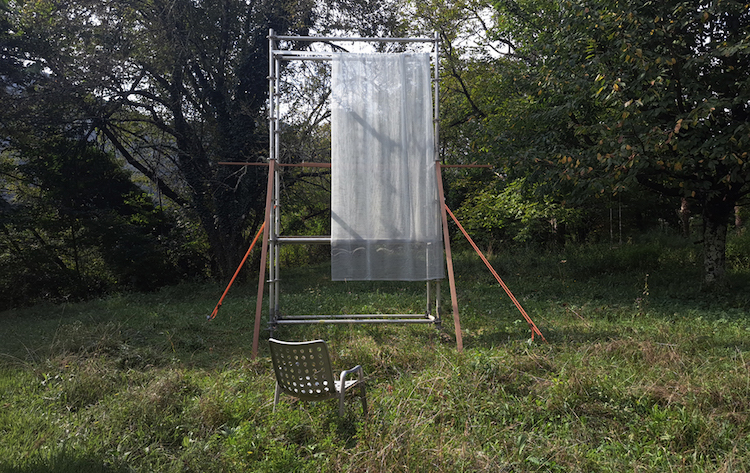
re-BIRDING
2023 / Video / 6K/HD / 16:9 / colour / sound / 26 min
This film sheds light on the current situation of songbirds in Europe through representatives
of various endangered bird species who reflect on current society, its ecological and economic structures as well as their view of the environment, and ask how far human
treatment of nature affects biodiversity and ultimately us humans again.
In the film, ecological and economic connections
and effects in connection with the alarmingly fast extinction of species are examined and
negotiated, ecological violence and alternative collective activities of reparation, recovery and restoration in terms
of a more sustainable and harmonious relationship with the surroundings, the environment, the land,
are reflected.
The bird figures are emblematic of all species that have been persecuted, displaced, destroyed and exterminated, be they indigenous peoples
displaced by colonialists, be they so-called marginalised groups that have no voice and/or are oppressed, be they
non-human organisations that fall or fell victim to capitalist and neoliberal strategies.
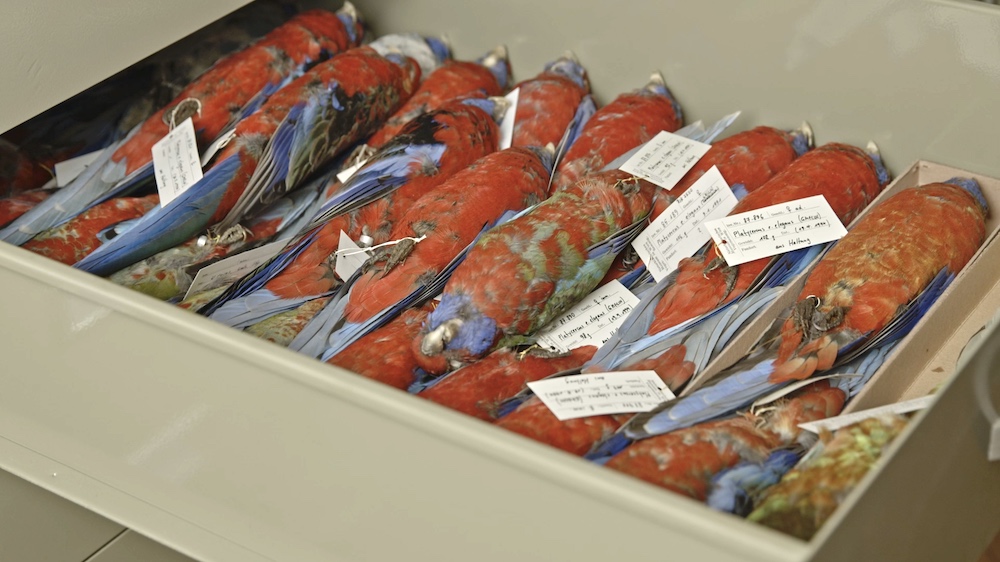
In the first part of the film, the bird figures are staged like display bellows in museum collections and at the same time
like precious portraits of rulers – their destroyers.
Later in the film, costume elements run like a thread through the historical and contemporary parts of the film
and thus are developed from the past into the present and future: Ribbons and textile elements are carried
by the protagonists from the studio space into the living space and laid out there,
interwoven, linked – a poetic translation of our actions, thoughts, reflections and shaping in terms of the collective
in a complex overall structure of the most diverse organisms.
Even more, the film is not only about collectivity, but also calls for it in an encouraging way.
Tracing a world without recording systems: The birds’ lost sounds, essential tools of communication and territorial manifestation,
are (re)constructed or invented anew by the use of artificial, instrumental sound. What might an extinct bird have sounded like?
(How) can a song be translated into a contemporary, artificial sound? Varying translations of bird
sounds are developed from collected field recordings of natural sounds and from artificial sound material.
The compositions for voices and instruments refer
to tradition, records and interviews as well as to poetic-technical translations of archived bird recordings, revisiting musical sources,
both historical and contemporary.
All sounds are simulations, invented sound objects, poetic approximations of unrecorded sounds of the past.
By reconstructing and reanimating blank spaces, lost or unknown information of the disappeared, the non-real, the no longer existing
is emphasised even more – the sonic act as (re)becoming world. Here, the vocal act is not only the reproduction or invention of sounds,
but also the expression of artistic and collective thinking. The collective is also thought of
in a political sense.
The aspect of political vocalisation as an expression
of a social fabric is met when the bird voices appear in chorus in order to equally
emphasise and demand the collectiveness in every social context. Furthermore, the (re)construction of the voice also enables its presence,
in the political, in the social and in the historiographical sense.
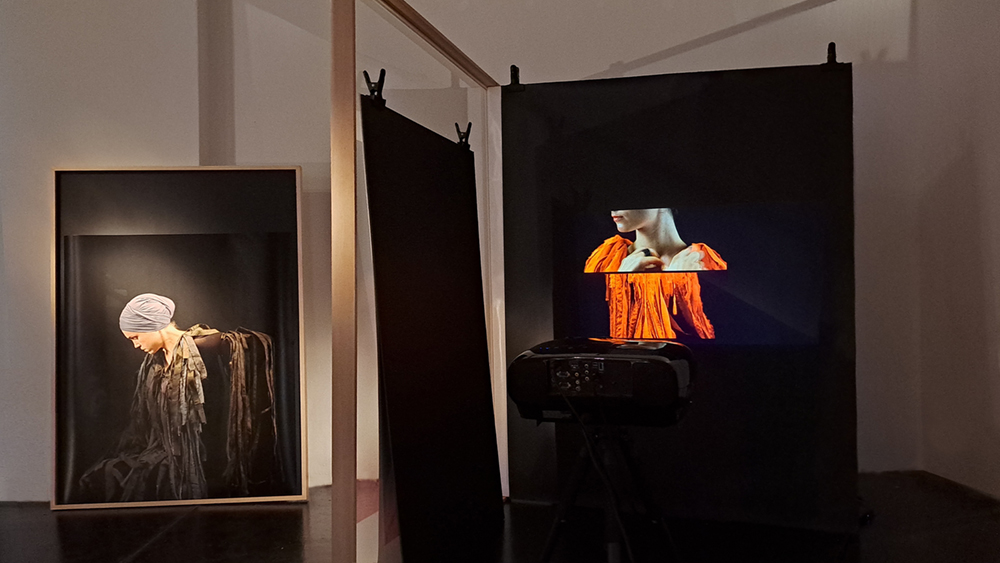
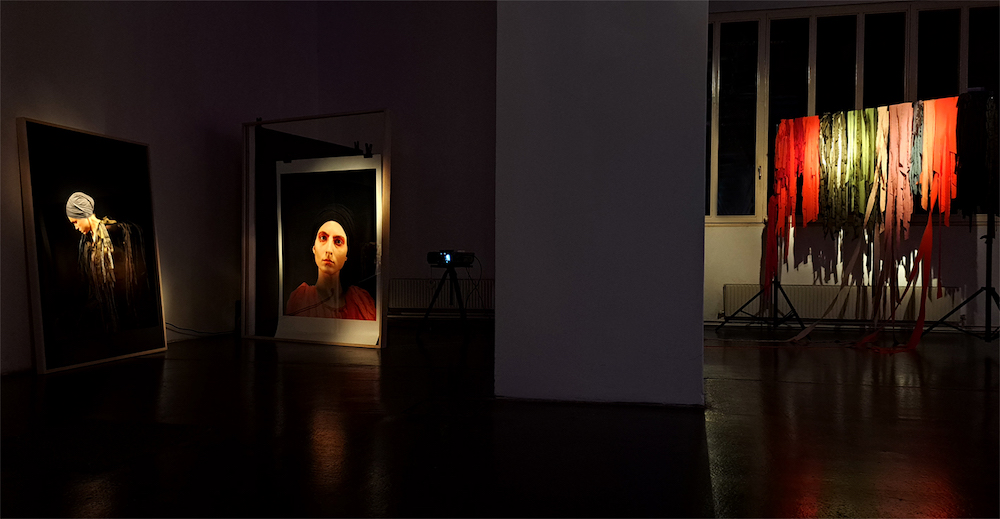 Exhibition views Tanz um die Sorge, Soho Studios, Vienna
Exhibition views Tanz um die Sorge, Soho Studios, Vienna
Colonialism destabilised:
In the installation, the bird figures are depicted like those in power: monarchs, regents, sovereigns — in representative paintings.
In this way, the connotation, the attribution is overturned: the bird figures are staged like the representatives —
conquerors, explorers, robbers, murderers, colonisers, colonialists — but their position is misaligned and questioned.
The arrangement of the pictures does not follow a stately/representative form; the prints are either unframed and lean against
a loose panel in an open frame, or they are framed but the picture seems to have slipped, it stands up at the bottom of the frame,
and the picture is not hung but leans against the wall.
So the installation, the arrangement, seems very temporary, as if it were not yet finished. but it is precisely this unfinished quality
that is my working and presentation principle, which is also intended to show that history, the past, is never something closed,
but always open, also in order to go back into it later and retell it anew, in order to learn and to do much better today and in the future.
The open installation also shows the fragility of life,
of society, of narratives. The damage caused by colonialism is conveyed by the fragile form of the installation.
The liveliness of organisms, organic forms, networks, weavings is given by flexibility of forms and formations,
which are in mutual interaction and also mutually dependent. If one element breaks, others also fall.
The factuality of the space: the chosen location, a dance studio and rehearsal room, a temporarily used space,
enables and reinforces the model character
of my setting and at the same time opens up an extended scope for interpretation, in that nothing is
predetermined, ascribed or visible and thus counter-
acts the horizon of experience.
Credits:
Concept | script | set design | edit: Michaela Schwentner
Birds: Aurelia Burckhardt, Christine Gnigler, Juli Müllner, Maja Osojnik, Karolina Preuschl
Narrating voice: Anat Stainberg
Angel of History/questioning voice: Elisa Martinot
Camera: Martin Putz | Michaela Schwentner
Music | Sound design: Maja Osojnik
Choir: Christine Gnigler, Maja Osojnik, Karo Preuschl, Sara Zlanabitnig
Flute players: Christine Gnigler, Maja Osojnik, Sara Zlanabitnig
Recordings | mix | mastering: Nik Hummer
Set design: Michaela Schwentner
Costume design: Julia Cepp, Michaela Schwentner
Make up: Miyu Haydn
Assistance: Nik Thoenen
Supported by BMKOES and Stadt Wien Kultur
re-alpsegen /
after the Alpine Blessing
2022 / Performance + video / 6K/HD / 16:9 / colour / sound / 10 min
The Alpine Blessing, a protective prayer chant, was and is still a ritual in Catholic parts of the Alps: every evening,
the alpine herdsman and dairyman appeals saints to ask for protection for his alp and cattle.
The Alpine Blessing is practised in the Swiss cantons of Uri, Schwyz, Obwalden and Nidwalden, Appenzell Innerrhoden,
in Sarganserland, the Pilatus region, Upper Valais and Surselva (Grisons).
As part of SARN to conference 2022 in the Gotthard region of Uri, we carried out the protection call in the Urseren transit valley,
which is connected to Ticino via the Gotthard Pass, to Grisons via Oberalp Pass and to Valais via Furka Pass.
Our idea was to examine the possibility, effect and influence of a contemporary call based on traditional versions, performed
by a female caller towards the valley, to us, the people, to our society. With the means of transformation, we question this intangible cultural heritage about its current relevance:
To what extent does the ritual of calling for protection, which was originally a purely male domain, still reflect the social structure
today, in particular that in the Alpine region?
Which lines could a prayer call contain in times global warming, macroeconomic changes and developments, what problems are
inhabitants and managers of the Alpine region confronted with? Which authority could be called today, who is responsible?
The Catholic tradition, which has used the apportionment of guilt as an instrument for executing and demonstrating power, delegates
protective measures to superior (supernatural) instances.
We suspended the delegation and directed the call towards the valley, to urban structures, densely populated regions, where the majority
of society and capitalist structures are located, to take responsibility together with and in society on one hand and on the other to
demand it from current superordinate forms and instances, such as supra-regional to supra-national associations, (climate responsible)
politicians, the inhabitants of the Alpine region of the affected cantons, of Switzerland, of the earth - in other words, society as a
whole. We addressed both society in the sense of a social structure, the sum of all people, and society as a corporate form, which should
pursue the implementation of the interests of different groups in harmony with nature and all people equally.
The project was realised together with Nik Thoenen in the frame of
SARN to conference 2022: Traversing Topologies.
Performance:
Vera Baumann
 After the Alpine Blessing: re-alpsegen, performance documentation still
After the Alpine Blessing: re-alpsegen, performance documentation still
re-Construct, She Said
2022 / Installation / honeycomb boards, backdrop, poster A0+, puzzle, prints, different sizes, video 4K, 16:9, colour, sound
The installation
re-Construct, She Said is the translation of a filmic work into a spatial installation.
The essayistic documentary film
re-GEO / rendering reconstructions of desire is unfolded and disassembled into individual components
to enable a different form of narrative.
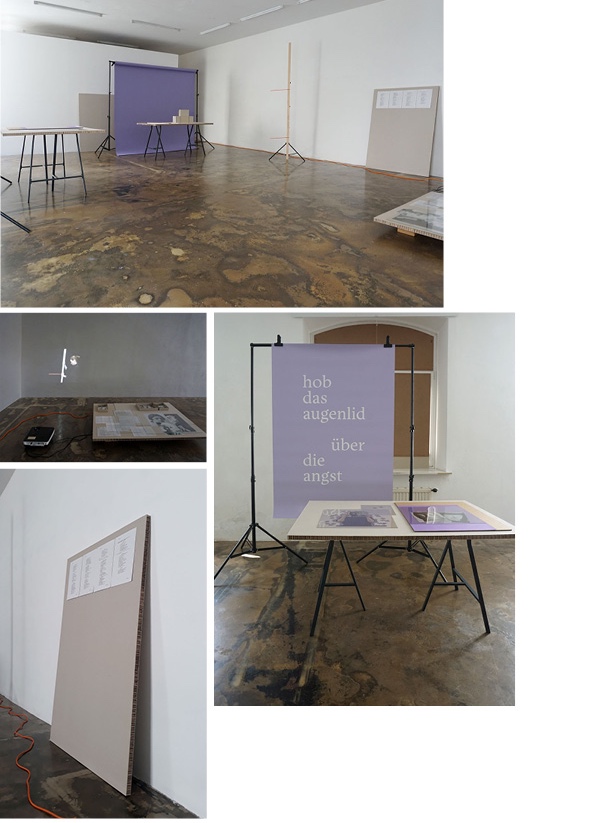
 re-Construct, She Said installation views. Sehsaal, Vienna, 2022
re-Construct, She Said installation views. Sehsaal, Vienna, 2022
re-GEO /
rendering reconstructions of desire
2021 / Video / 6K/HD / 16:9 / colour / sound / 33 min
re-GEO / rendering reconstructions of desire is a documentary about Georgette Klein
(1893-1963),
a Swiss artist and philologist originating from Winterthur, and her self-designed house, the Casa Sciaredo,
first private modernist building in Ticino, which she set up together with her husband in 1932.
The film casts light on Georgette's life and her ambivalent personality and builds a bridge to the present and the conditions women
artists are confronted with today. It is a poetic approach through the reconstruction of her house as a model and the adaptation of her numerous
diaries, notes and letters.
In the film, I set out on the trail of the loner, artist and convinced socialist Georgette Klein, primarily from the aspect
of construction and the constructed image. Who was this woman who was sceptical about marriage, because it could harm her artistic work,
who then fell out with her family precisely because of her improper marriage, who was a mediocre but persistent sculptor,
whose way of life and thinking was self-confident and modernly oriented, and who never-
theless could not completely free herself from established social structures, who, as a doctor of German studies, not of architecture,
tailored a house for herself and made dresses for friends and acquaintances until the 1950s, always realising her conceptual vision of freedom,
and who placed this architectural jewel in the landscape of the Swiss Ticino?
Why have neither Georgette Klein nor Casa Sciaredo received greater attention?
Because the house was designed and built by a woman? Neither Georgette nor the building are known outside Switzerland.
The film examines the constant intertwining of reality and projection: Georgette’s lifelong longing for intellectual exchange which she
couldn’t find in Ticino, also for an admired fellow student from her student days in Zurich, with whom she maintained a long
correspondence, left a gap that only her artistic work and that in the property she designed, including the park and vegetable garden,
could fill.
My cinematic works are "frameworks" that enable me to look at and negotiate an idea, a theme, more closely and objectively.
Other terms for frame are framework, scaffolding, structure, staging and performance — they all outline very well my
approach to cinematic reflection and realisation through fragmentary approximation and poetic image production.
Thus, this is not an architectural film, but a fusion of personality, idea and housing.
The film consists of poetic images within an overall image, which corresponds to my fundamental approach and the way I deal with questions and
narrative forms in a cinematic context. The approach and orientation of my work can be defined
by these two thematic fields of re-paradise and re-staging: re-paradise comprises investigations of places and spaces that allow,
evoke or reflect desire, longing, ideas, fantasy, hope, dreams, etc.; it is about constructions of heterotopic places,
reconstructions of paradisiacal places and constructs and about the repair of destroyed paradises,
formerly untouched places that have been almost or completely irretrievably lost through human intrusion.
In the re-staging projects, I investigate and develop forms of retelling existing narratives from the collective memory
(which becomes pop-cultural, mimetic, collectively experienced, remembered material) in the form of re-enactments or reconstructions.
As in earlier filmic works, each consisting of a single shot, a single space or a single existing image,
the focus in re-GEO / rendering reconstructions of desire is also on the reduction of images and at the same time on the visualisation of an idea,
a theoretical question, in this case that of construction — the construction of a building, which is negotiated in a reconstruction,
like a constructed image, an image within an image. The frame here is not only a figure of thought, a frame, but a literal subject —
in the form of the construction in the image, the construction of the idea, the image (of the casa), Georgette’s concept of life, her self-perception.
The construction is also a re-construction: reconstruction of an idea, of Georgette’s reflections on the Casa and the building as a sketched model,
also in the sense of a vehicle in approaching the development history of the Casa.
Georgette’s disruption gave birth to a house that was like a skin for her, a shell that protected her – from the world, from herself,
from the compulsion to function in the system.
Credits:
Concept | script | set design | edit: Michaela Schwentner
Narration/reflection/Georgette: Aurelia Burckhardt
Narration/reflection/GEO: Vivien Löschner
Construction: Lisa Hinterreithner
Camera: Martin Putz, Michaela Schwentner
Drone: Nik Thoenen
Music: Julia Purgina
Sound design | mastering: Nik Hummer
Supported by BMKOES and Stadt Wien Kultur
Wien Modern Trailer 2021
2021 / Video 4K / 16:9 / b/w / sound / 40 sec
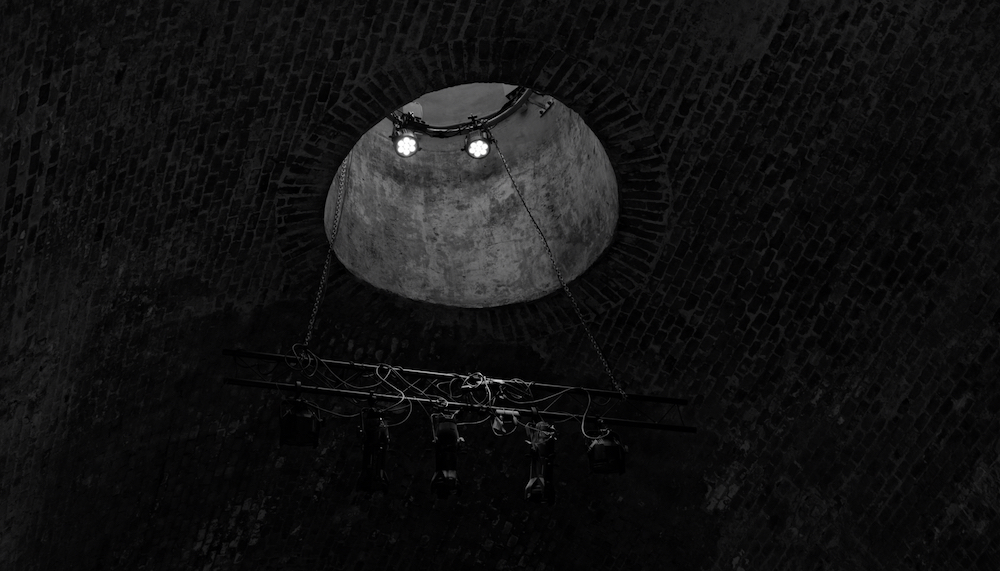 Wien Modern trailer still
Wien Modern trailer still
Wechselwirkung
Experimental music theatre
2020-2021 / Video / 6K/HD / 16:9 / colour / sound / 60 min
Video documentation of the experimental music theatre piece
Wechselwirkung (Mutual Reaction)
by Pia Palme which was supposed to premiere in
the frame of Wien Modern 2020.
Bodies moving, in space.
She sings, wheezes, breathes –
standing, turning –
she kneels, lies, rolls before my feet,
her high voice walks along,
I can hear it down to my soles.
Get lost in these tense bodies
crawling all over the dance floor.
Trembling.
So close to these people.
Don’t stop singing now!
She remembers: Loneliness.
She wants to be alone and doesn’t.
The sound of the words fascinates her,
she listens inward, reading:
Lasciatemi mori,
then and now.
She sighs:
How to rehearse,
how to compose,
and please,
how to successfully plan
a music theatre performance
during this pandemic?
She thinks and writes:
How to build a bridge to the other shore,
which twists,
can’t be measured out
in the fog?
This transdisciplinary collaboration consists of composer Pia Palme, dancer/choreographer Paola Bianchi, singer Juliet Fraser,
dramaticist Irene Lehmann and musicologist Christina Lessiak. Since 2019 they have been working on the art-research project
Wechselwirkung (Mutual Reaction) and other projects in Graz and Vienna. This growing collaborative structure surrounding
Pia Palme has developed from earlier projects with Juliet Fraser and Paola Bianchi.
The group's experimental approach is rooted in the reciprocal influence of the individual actors and the interconnectedness of their
different practices and pools of knowledge. (Pia Palme)
FWF PEEK Project
On the fragility of Sounds AR 537, supported by the University of Music and Performing Arts Graz,
Wien Modern coproduction 2020.
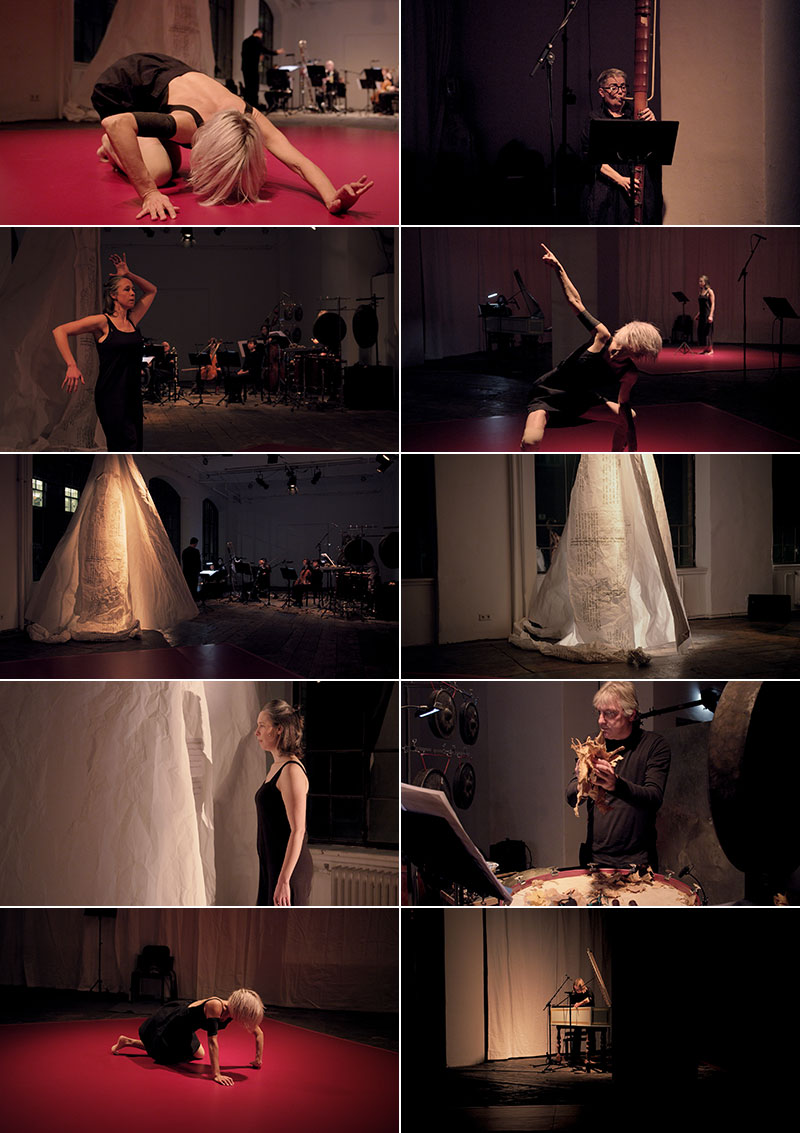 Wechselwirkung video stills
Wechselwirkung video stills
Credits:
Concept | edit: Michaela Schwentner
Performers: Pia Palme, Paola Bianchi, Juliet Fraser, Ensemble PHACE, Molly McDolan, Sonja Leipold
Musical direction: Lars Mlekusch
Camera: Martin Putz
Sound editing: Martin Siewert
re-ASSEMBLY
2020 / Performance, installation, video (6K/HD), 16:9, colour, sound, 30 min;
photographic series of 9 C-prints, 60cm x 40cm
Historical, political, and social mechanisms are subject to a process of constant transformation.
If you look at the details, certain movement patterns in society come to the fore. The performative installation re-ASSEMBLY by Michaela Schwentner
investigates how these processes can be translated in the exhibition space and become tangible. To this end, the artist employs materials and everyday
objects found on site to (re-)format Kunstraum Lakeside over the course of several days, interpreting the semantic potentials of the term “assembly” as
gathering, accumulation, and composition.
The main element in this project is the high number of available chairs, which are time and again repositioned in the space as Michaela Schwentner searches
for a balanced state. In re-ASSEMBLY the artist’s interventions leave traces in the exhibition space, creating both an expansive installation and a permanently
changing sculpture. The assemblages that emerge in the production process are documented as spatial constructs throughout the various stages of their development
until the tentative end. It remains open, however, whether the camera is a part of the performance or if it only serves as a documentary medium for the
performative setting.
The choreography and progression of the performance are based on the subject of and the search for the absent and its affect: the longing for balance, equality,
desire, utopia. Historical and contemporary political and social mechanisms along with their movement patterns and processes are revealed; social and political
powers continuously build up in new and different ways. The reconfigurations of the spatial and infrastructural conditions of the exhibition space generated
during the performative setting can be retraced on the basis of film sequences. But the question remains: Will the respective constellations of elements
(as metaphors for all possible powers and mechanisms within society) ever arrive at a final arrangement?
(Kunstraum Lakeside exhibition text, 2020)
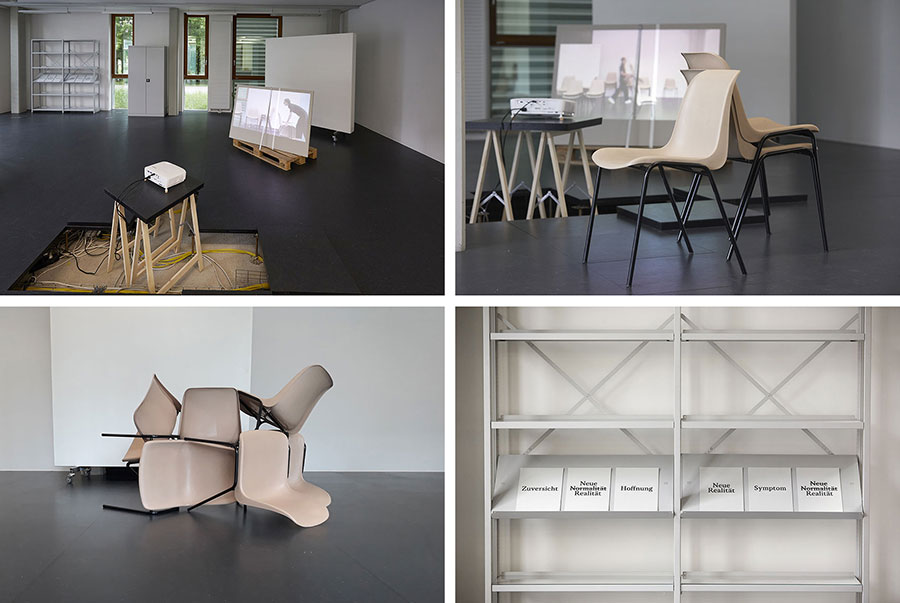 re-ASSEMBLY. Statement#09, Kunstraum Lakeside installation views @ Johannes Puch (except #5)
re-ASSEMBLY. Statement#09, Kunstraum Lakeside installation views @ Johannes Puch (except #5)
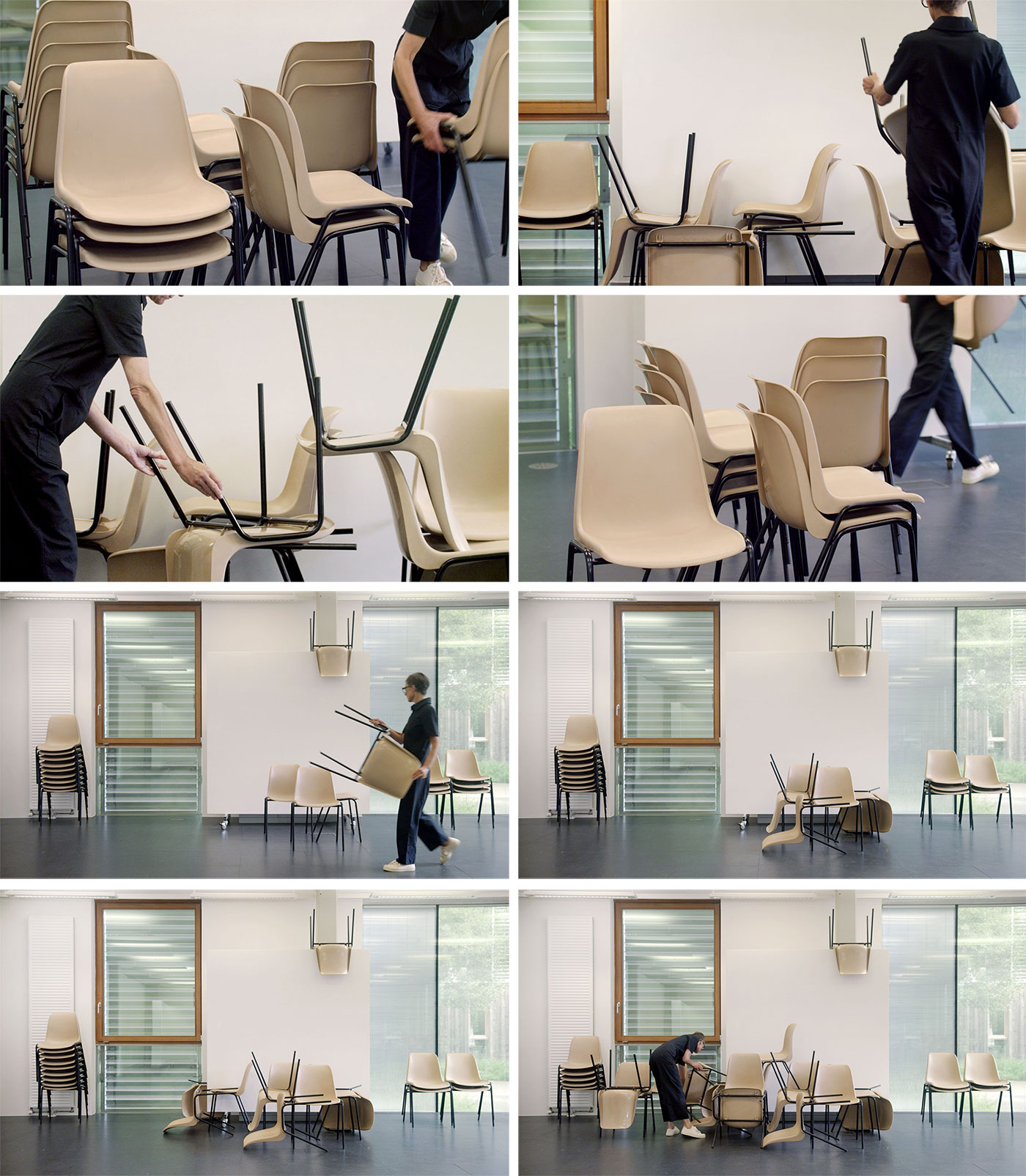
re-ASSEMBLY video stills. Statement#09, Kunstraum Lakeside 2020
Credits:
Concept | choreography | edit | sound design: Michaela Schwentner
Performer: Michaela Schwentner
Camera: Martin Putz
European standards /
Miranda's disappointment
2020 / Installation / Mirror foil, wooden pallet, comb cardboard,
orange and blue belt, sound mono 7:36 min
Europe / EU: construction, projection, framework, idea ... ?
What is the idea of a united Europe today? What does it mean in times of agent's wars, migration as consequence, over-population, growth, neoliberalism,
climate change? What was the promise? Where are we now? What are these so-called European values?
The unjustifiably named refugee crisis never ever was a crisis caused by refugees but rather a crisis caused by cynical morale,
democratic failure and unwillingness in terms of taking action of the political system of the Western world, in particular the EU.
Miranda from Shakespeare‘s
Tempest, stranded and isolated, is surprised by the sight of people on the island who turn out to be rescuers in a way.
Today, there's only little hope for salvage of people facing a similar fate. European migration politics has failed completely.
In a poetic setting the void and shallowness of this
so-called community of (shared) values as well as the lack of will of EU-politics are revealed by
displaying a makeshift construction of assembled debris, held together by belts.
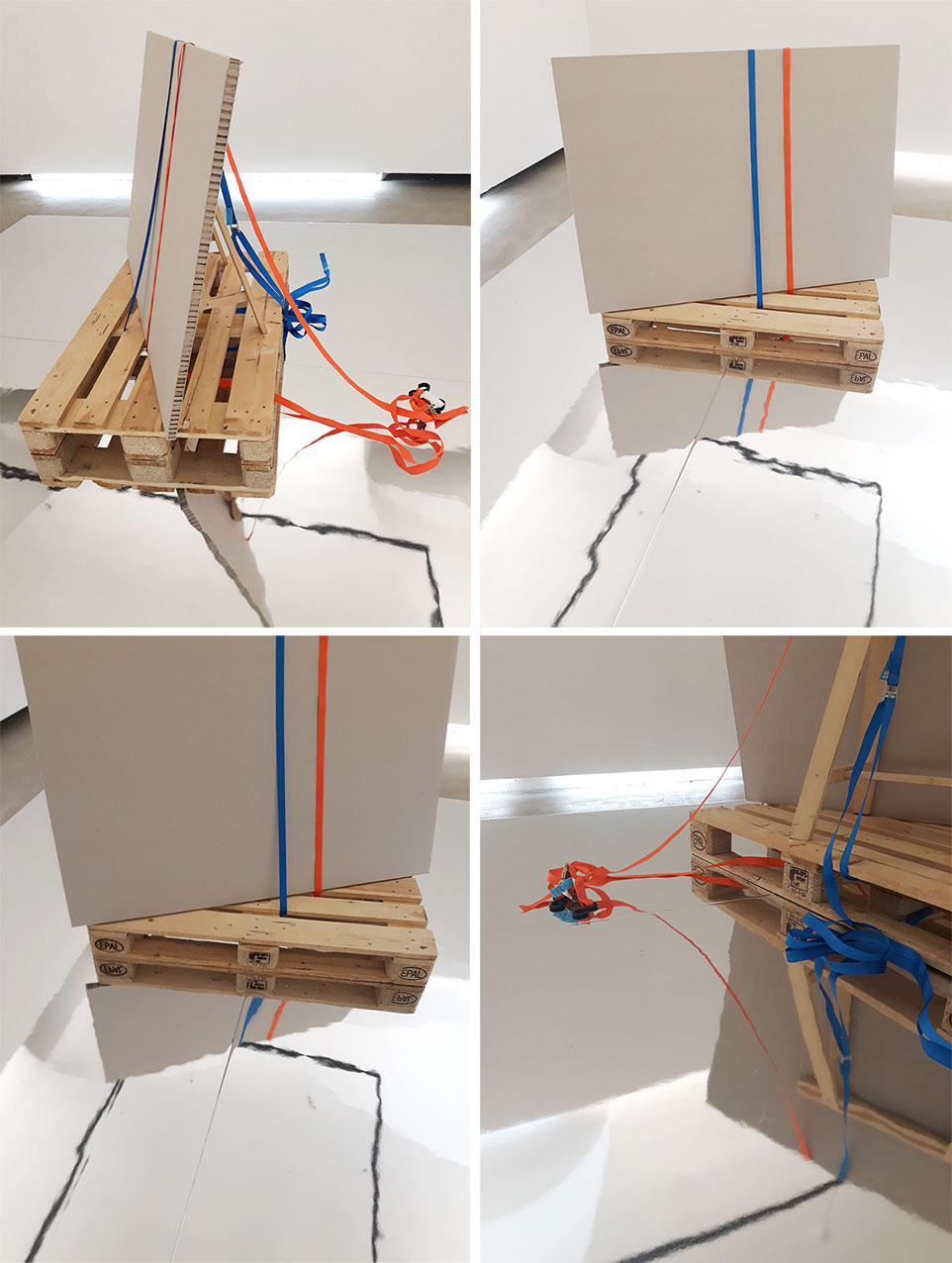 Miranda's disappointment, installation views
Miranda's disappointment, installation views
re-FORM [again!]
2020 / Solo exhibition / Tiroler Künstlerschaft, Neue Galerie, Innsbruck (A)
re-FORM
[again!] is both a film and an installation – the title is already a director's instruction.
The text and image material used in its sketched form refer to the absent and its impact: to longing, desire, utopia – here,
in the shape of reflections on the development of the Europe that we know, which has inscribed itself into our cultural and economic consciousness,
exerting its influence, and to which we still refer. The experimental arrangement consists in negating the filmic structure or opening it out.
The scenic does not follow a certain hierarchical order: here, the backdrop, scene, choir, action do not determine each other,
they are installed with equal status and rights.
The film-historical and theoretical reference material used in the model-like staging of a film production, as well as the ensuing material,
serves as a starting point for her essayistic yet poetic visual language, which she presents on various stages within the gallery space.
She weaves diverse narratives into the dramaturgy, including the great narratives of Shakespeare's dramas and Godard's political-critical films as well as
sociopolitical themes.
The model of the film set is fragmented, inscribed and expanded into the space to equal extents. The individual elements refer to basic principles of scenic
production or adaptation (rehearsal, recitation, direction and action instructions, chorus).
Possibilities, therefore, open up the space for different reflections on various levels, culminating in the last room: the instruction and invitation to re-form.
(Excerpt from the exhibition booklet)
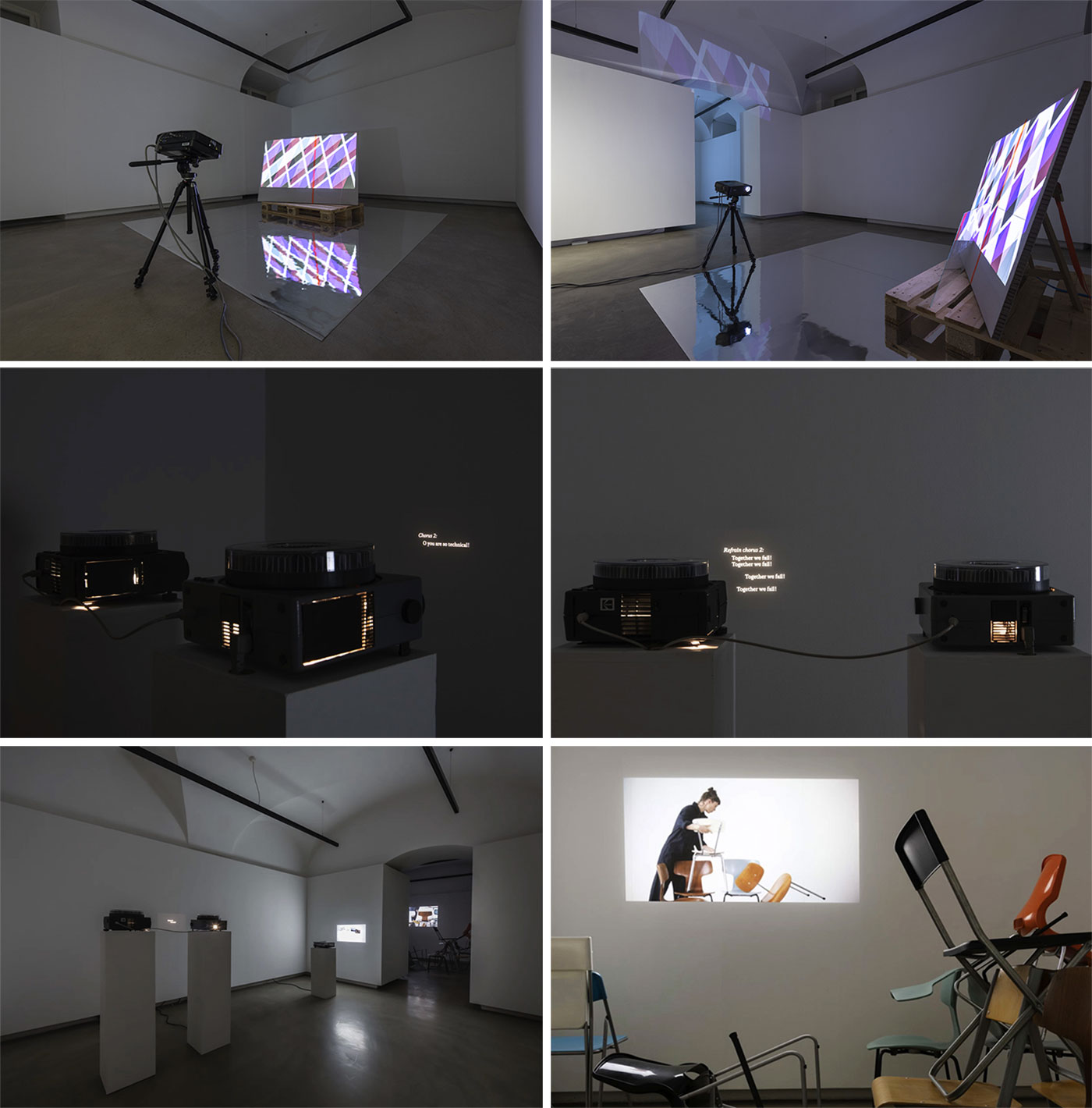 Exhibition views Neue Galerie, Innsbruck. © Daniel Jarosch
Exhibition views Neue Galerie, Innsbruck. © Daniel Jarosch
Masking [ISO 216 (DIN) AO]
2020 / Performance and pigmented inkjet prints / 100cm x 140cm
Masking
[ISO 216 (DIN) AO] is a project which negotiates forms of representation of desire,
the absent, and with forms of human traces, imprint of man, particularly in nature, in landscapes.
We inscribe ourselves whereever we go, act, live, over-write,
cover, and thus leave marks. What does the vestige of our paths, actions and patterns look like?
The photographic series is the attempt of a poetic, condensed depiction of current reflections on the Anthropocene and what kind of marks humans leave on earth.
In the frame of a performative act a white rectangular sheet of cloth or paper sized DIN A0 is positioned in a natural environment – deliberately in a
non-cultivated landscape –, held in front of the camera by a performer and by that, covers a field, a specific segment of the world. At the same time this action is an inscription into
a spatial setting: The performer behind the mask is not seen but still leaves traces.
ISO 216, A series: A0 is an internationally standardised paper format which has become a technical convention and therefore is in a way universal.
A0 refers on the one hand to the letter A, the first one in the alphabet of our cultural environment (in Arabic: alif, in Hebrew: aleph),
the beginning in general, the beginning of our cultural history, on the other hand to the sign 0, Zero, Null, Nothing: blank, projection surface – screen.
Masks are man-made and thus constitute a distinct opposite to nature – even if some masks definitely show mimetic features and attempt to imitate nature –;
the mask: the screen, the sheet (of cloth, paper, etc) — the square angle is placed in the natural setting of landscape in a poetic form and asks what is
possibly hidden behind, what is covered, or if it‘s the condensed rectangular evidence or sign of the Anthropocene, a Heideggerian Geviert (though I don‘t
advocate Heidegger‘s thinking and opinions, still I find the term Geviert as ontological description mentionable in this context), too, a visualised way
of thinking. Even the human body in this setting is masked, covered – only hands and feet can be seen — the performer is reduced to a carrier or supporter,
an upholder.
White surfaces, often rectangular, are used in photography, like sheets for white balance or (white) reflector panels. With the applicaton of white
rectangles in my photgraphic series I decidedly want to refer to specific processes within image production. Displaying work processes,
conditions and mechanisms are recurrent principles of my artistic practice.
 Masking [ISO 216 (DIN) AO], test performance, Casa Sciaredo, Barbengo (CH)
Masking [ISO 216 (DIN) AO], test performance, Casa Sciaredo, Barbengo (CH)
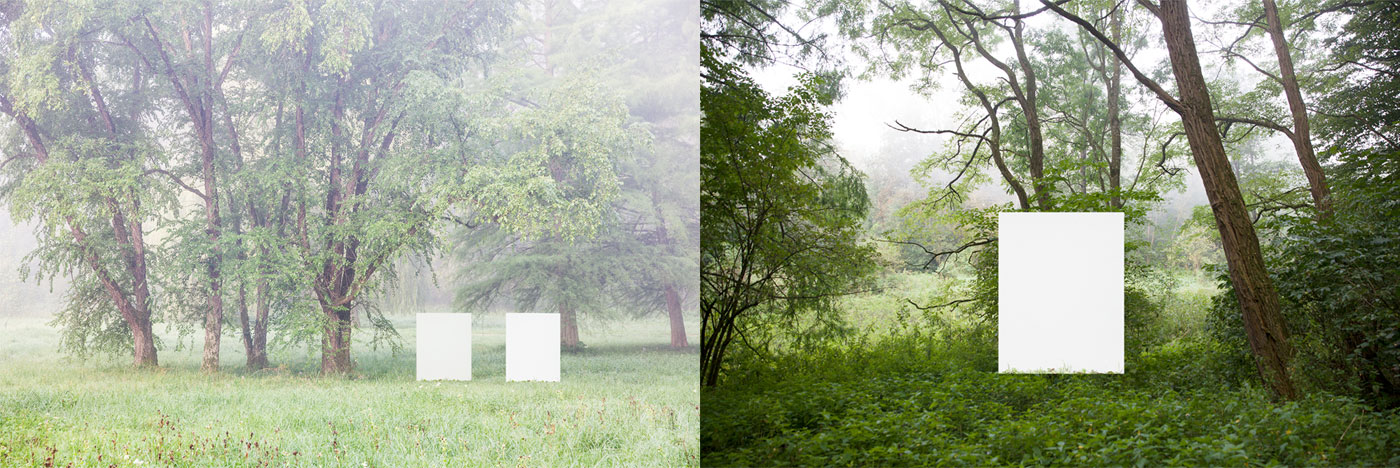 Masking [ISO 216 (DIN) AO], intervention Bad Hall (A)
Masking [ISO 216 (DIN) AO], intervention Bad Hall (A)
ASSEMBLY
2019-2020 / Performance + installation, 4K / 16:9 / colour / sound, 20 min
Chairs or seats are parts of social settings: we always find arrangements of chairs/seats
to organise collectives in communication, socially or politically participation, perception, education or administration processes or situations.
In this performance two performers assemble a variable, but rather large number of chairs of various forms and materials representing any kind of collective
(such as audience, choir, socio-political forces, the people – society in general) configure and arrange them in different ways, re-configure and re-form
these chair-assemblages in diverse ways trying to create an equilibrium. Since the two performers may have a different sense of balance, their individual
arrangements would always be different.
The dialogue/interaction might be radical, trying, discoursive, diplomatic or gentle – the challenge is to achieve a state agreeable for both performers:
If we want to change discomforting states or situations, we ourselves must act.
In the act of re-arranging, re-configuring, re-forming political and social mechanisms and their moving patterns are revealed. Social and political
forces manifest themselves in new and diverse ways, some of dem repeated: it’s reproduction of history, mechanics and mechanisms, political measures and
actions, social interactions, etc.
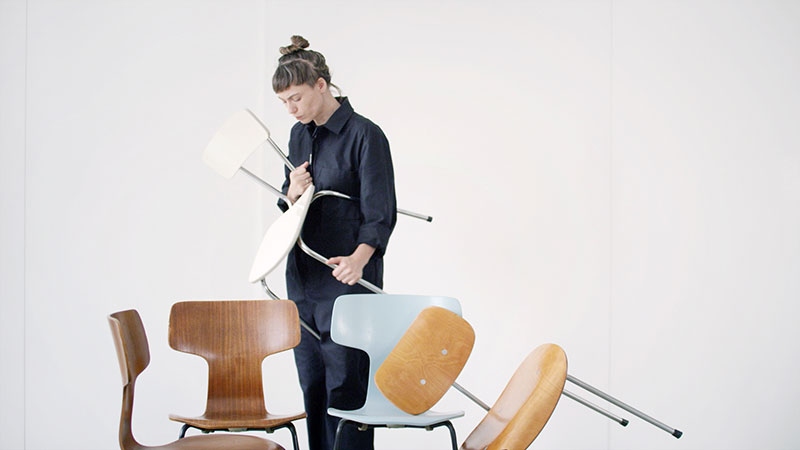
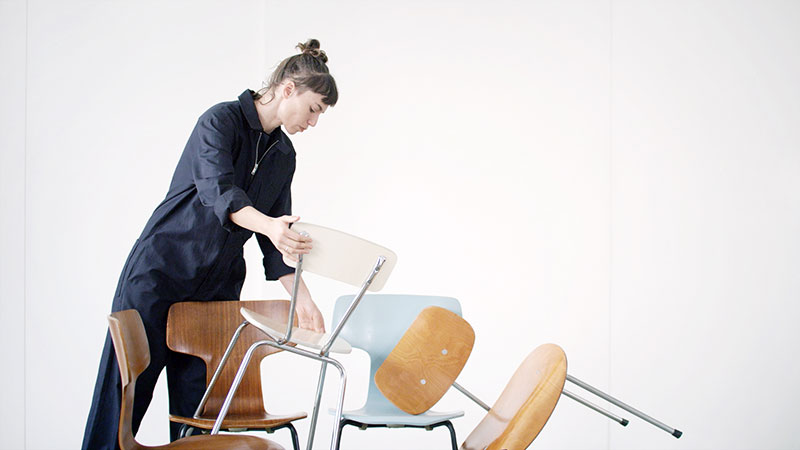
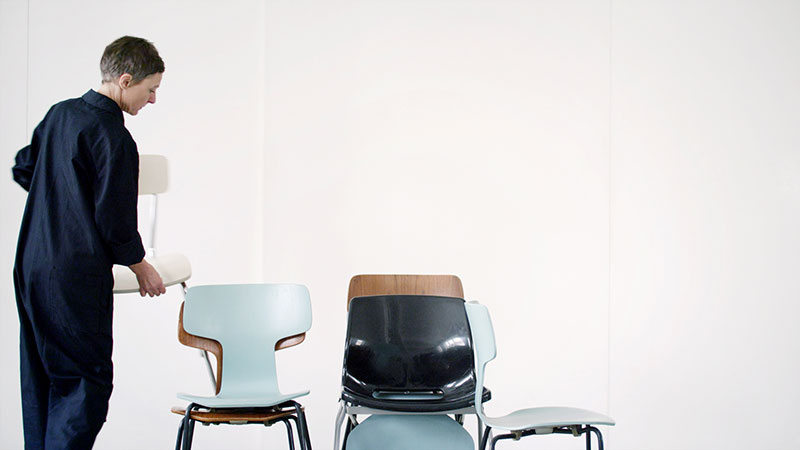 ASSEMBLY, performance, video stills
ASSEMBLY, performance, video stills
Credits:
Concept | choreography | edit | sound design: Michaela Schwentner
Performers: Nina Vobruba, Michaela Schwentner
Camera: Martin Putz
zwischen mir und der welt /
aufräumen
A 2020 / Video 4K / 16:9 / colour / sound / 24 min
Hands in rubber gloves steadily re-arrange building blocks into new patterns. On the voice over are testimonials from people on the Autism spectrum.
Profound self-reflection makes it impossible to draw the line between normality and behaviour disorder, inviting a critical rethinking of systemic
conditions and social power structures. (Michelle Koch, Diagonale catalogue, 2020)
The playful impression disappears quickly. The wooden blocks are, indeed, luminous and colourful as bonbons, but the hands that constantly rearrange the objects
for the camera are in rubber gloves. The incessant piling and arranging, twisting, turning, and moving is reminiscent of a restless search for the “right”
constellation.
“But what is normal, anyway?” asks the voice superimposed over this arranging in
zwischen mir und der welt / aufräumen. In the film, Michaela Schwentner
gives people who have been diagnosed as being on the autism spectrum, more specifically, with Asperger syndrome, the chance to speak. They offer profound
reflections on what isolates them from the so-called world out there, how their social handicap and the difficulties in communicating with others lead them to
experience the disturbance as a prison. The limitations as well as the compulsion are reflected and intensified at the visual level: the organising of the
geometric structures becomes a Sisyphean struggle; it is a symbol of the inability to grasp the structure of a social situation.
zwischen mir und der welt / aufräumen goes beyond the mere documentary element. When those affected by being stigmatised as “unnatural” or lacking
empathy talk about hiding their “difference” and about Hans Asperger’s involvement in the eugenics of the Nazis at Spiegelgrund in Vienna, a flash of defiance
emerges again and again, which casts doubt on the normalcy of dominant social systems. (Anne Katrin Feßler, sixpackfilm catalogue; translation: Lisa Rosenblatt)
Nominated for the International Critics Prize (FIPRESCI Prize), partner prize at DOK Leipzig 2020
Credits:
Script | camera | edit: Michaela Schwentner
Voice: Ulrike Zachhuber
Sound design: Nik Hummer
Supported by:
Kulturabteilung der Stadt Wien
BKA / innovative film
Distributed by:
sixpackfilm
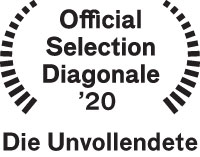
what remains
2015-2019 / Installation / 2 water sprinklers or fog machines filled with differently coloured liquid
In this poetic-technical installation setting of text-to-speech transference, excerpts from John R. Searle's
The Logical Status of Fictional Discourse and Jacques Derrida's reply
Signature Event Context which again was answered by Searle with
Reiterating the Differences: A Reply to Derrida.
By text to speech to sound translation and dynamic interactive process the emitted smoke of 2 fog machines positioned opposite each other was controlled to a
certain degree. The differently coloured clouds of smoke would merge and take on new forms before they diffuse, dissolve and finally disappear.
This illustrates aspects of construction and deconstruction, presence and absence, visible and invisible at the same time. Furthermore, in this process aspects
of unpredictability, randomness, and stochastic interplay are visualised.
Memories are fiction:
Medial machines always reflect needs, motifs and phantasms and change us: by the use of, through échne the world is constituted,
we construct the world in the particular contemporary way which contains the directorial, the imaginary and the poetic. This means, this work is both technical
and poetic transference (of the visualisation) of a dialogue and its dissolution or displacement – the spoken word disappears. Why does the content not disappear,
too? And if something remains, what exactly remains, what is it: ghost (in the meaning of phantom) or spirit? Nothing – in the sense of John Cage's no thing in
his Zen Buddhism inspired
Lecture on Nothing, but also in the sense of the ostensible dichotomy of absence / presence. Human spirit manifest itself
through speech and writing. If the formal element, the sign, the signifier disappears, what remains? All those signs can be intertwined to what we call
memory or memories. And what are memories, if not ghosts?
 What remains, documentation still
What remains, documentation still
Credits:
Concept | text | edit: Michaela Schwentner
Camera: Martin Murer
Supported by:
Kulturabteilung der Stadt Wien
subnetAIR Salzburg in cooperation with Center for HCI Salzburg
Transform She Said
2019 / Curated film programme / Blickle Kino, Belvedere 21, Vienna
In four episodes this film programme traces psychograms of female experiences and self assertion
alternating with environment and world as well as their filmic representation.
Films by VALIE EXPORT, Marianna Simnett, Martha Rosler, Lynn Hershman Leeson, Ana Hoffner, Ulrike Müller, Laure Prouvost, Michaela Schwentner
Curated together with Claudia Slanar
 Giuliana 64:03, video still
Giuliana 64:03, video still
Choreography of the Frame
2018 / Group exhibition / Kunsthalle Exnergasse, Vienna
The exhibition
Choreography of the Frame investigates and negotiates positions and strategies of image production – through conceptual or
technical frameworks and shifts in the context of photography and moving image, images and statements are redefined and recontextualised.
The dissolution of established genre ascriptions, borders, and frameworks by individual artistic practices and strategies calls for a
re-examination of the image.
Be it an enlarged photograph that takes on the dimensions of a wall or a space, a photograph that is folded into a sculpture, a photographic
or filmic work that expands the mise-en-cadre to include or thematise the underlying conditions of image production – in all of the exhibited
works the conventions are suspended, while the production process itself and its mechanisms, logics, and conditions are brought into focus.
Participating artists: Marwa Arsanios,
Gwenneth Boelens,
Maia Gusberti,
Yasmina Haddad,
Herbert Hofer,
Tatiana Lecomte,
Gabriela Löffel,
Claudia Märzendorfer,
Uriel Orlow,
Petignat und Scholz, Michaela Schwentner,
Lina Selander,
Sophie Thun.
 Exhibition views © Wolfgang Thaler 2018
Exhibition views © Wolfgang Thaler 2018
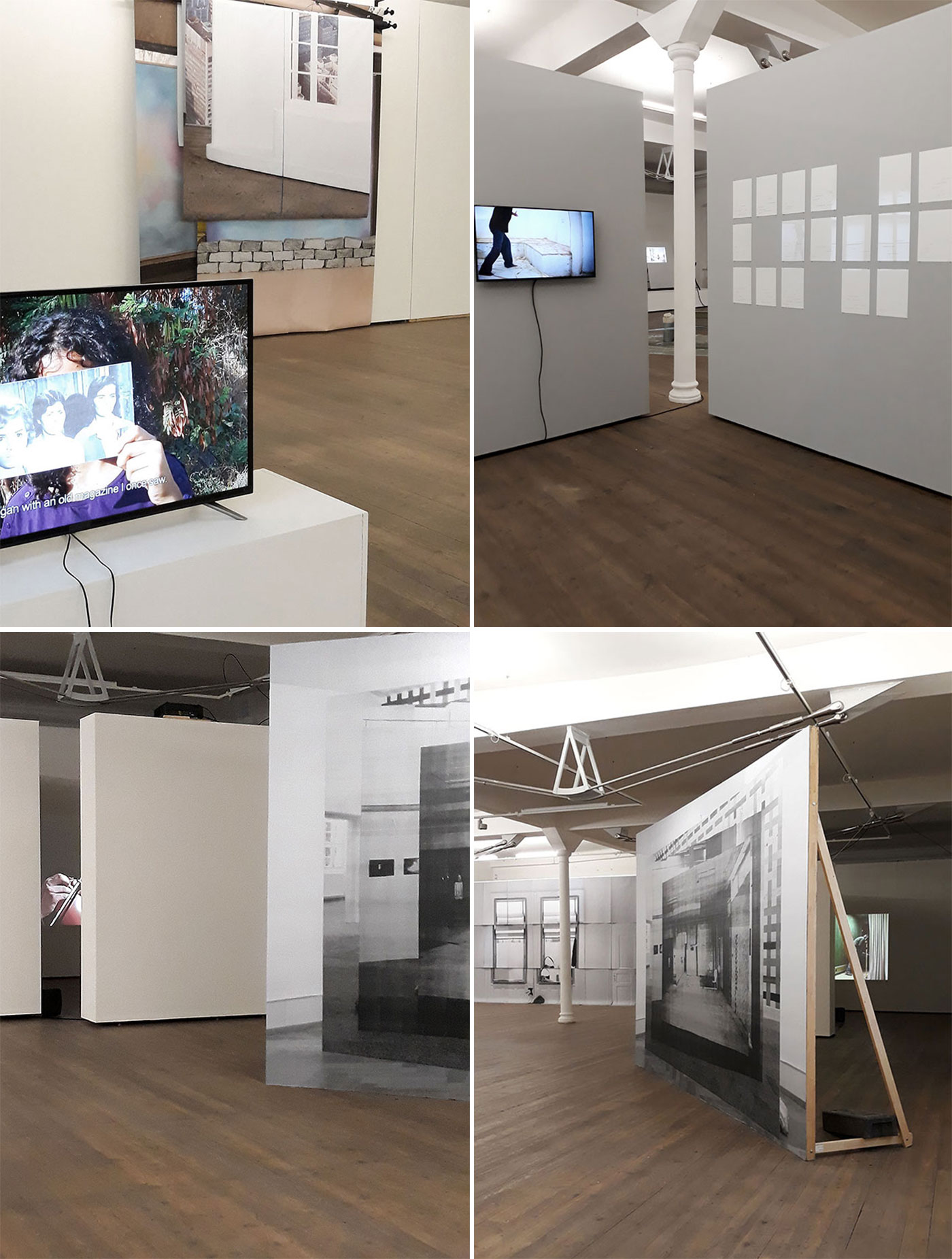 Exhibition views © Michaela Schwentner 2018
Exhibition views © Michaela Schwentner 2018
PLAY pt. 1
The Rehearsal /
of William Shakespeare’s
Midsummer Night’s
Dream
A 2018 / Video 4K / 16:9 / colour / 2:08 min
The video
PLAY pt 1. The Rehearsal shows the staging of a text source and refers to one of the great narrations in the history of
theatre in its subtitle. Here the organic-mechanic principle of repetition is replaced by the technical loop.
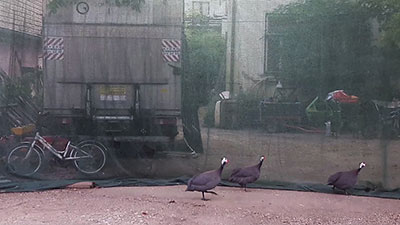 The Rehearsal, video still
The Rehearsal, video still
PLAY pt. 2
L’absence est présente
(prototype version)
A 2018 / Video 4K / 16:9 / colour / 2:08 min
In
PLAY pt 2. L’absence est présente a puzzle, after being put together, displays the text “L’absence est
presente”. It’s the playful attempt to make the absent, the still invisible, the non-perceptible present by the generation of text.
The 2 video works
PLAY pt 1. The Rehearsal and
PLAY pt 2. L’absence est présente negotiate the philosophical aspect
of absence and how it comes into presence by artistic interpretation, particularly by staging a play or a film.
Both works question how absence can be glimpsed or displayed.
A play has specific structures and rules. Inbetween those structures — in the interplay of repetition — we can glimpse absence.
In this flickering between presence and absence a space unfolds which enables the emergence of
poiesis in a hermeneutic
sense.
In my artistic practice I examine structures, mechanics and mechanisms of art and image production itself, mainly the frame
conditions and production processes. In this context for me the central aspect is the rehearsal as basic element of the
realisation of (mostly) text interpretations with their relevant issues and decision-making processes regarding possible forms
of staging.
The artistic rehearsal is repeatable. This repeatability is enabled by the repeatability of once present experience in and by
remembering — in the play the absent is always revealed and negotiated: the absence of death, of endlessness in the repeated or
repeatable imagination (idea/eidos) or in our memory.
PLAY pt 1 + PLAY pt 2 were realised in the frame of
ORTung Hintersee 2018.
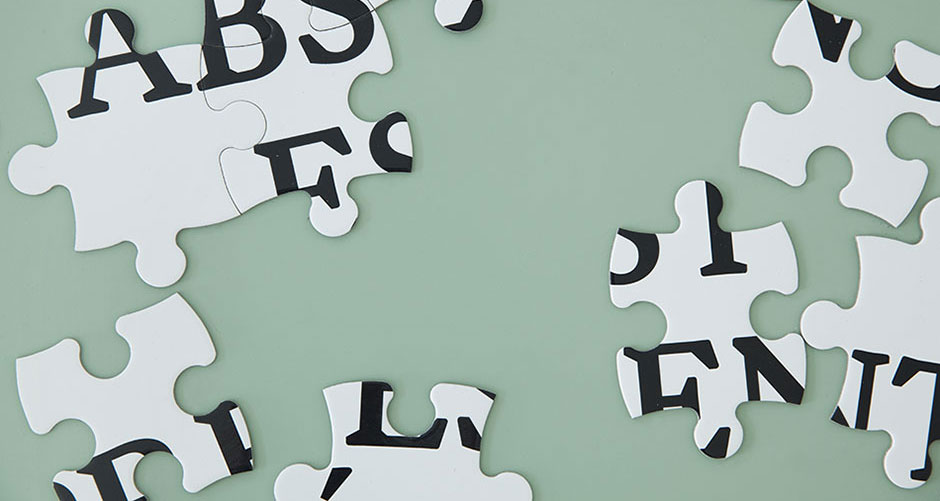 L’absence est présente (prototype version), video still
L’absence est présente (prototype version), video still
chorprobe
CH 2017 / Video / 16:9 / colour / sound / 2:41 min
In the frame of the residency project
Was Anderes? I conceived a small piece for a choir.
The reenactment of this choir practice was both choreography and social interaction as well as performance and rehearsal.
This scenic fragment was the attempt to connect and combine our various approaches responding to the introducing question in a playful performative way,
addressing communality, community and the collective itself. We performed and filmed the reenactment on site in Vairano.
The result is the film fragment
chorprobe.
Facing the current populist developments in Western politics and society, it seemed to be useful and relevant to examine and revise popular and
established terms in relation to their social and philosophical meaning.
In order to grasp the notions of our time, we wanted to dispute these developments from an artistic perspective. In an experimental setting,
by collecting and developing methods of re-appropriating,
re-connecting, re-understanding and embodying terms we investigated the experience of meaning of (socio)political terms.
Despite our diverse, individual ways of investigating and questioning we were collectively and continuously collaborating on instructions for
an appropriate choreography within our social frame and on the depictions of personal strategies of social (inter)action. We were consistently
searching, creating and collecting notions, vocabulary and ideas for our adaptive alphabet using new possibilities of perception, connotation,
contextualisation and interpretation. An essential experimental stage of our reflections and investigations was learning and understanding by
doing or acting: by taking action technical or social processes can be reconstructed, tracked or reenacted.
Zusammen (:) was anderes (!)
After 4 weeks of searching, collecting, comprehending and developing a new vocabulary, (self) investigations and developments of
action strategies, we would be able to start the filling our abédédaire – C for Choir,
Z for Zusammen, …
The Sasso residency collective in July/August 2017 consisted of performer Nicolas Galeazzi, artist Maia Gusberti, graphic designer Miriam Hempel,
typographer and graphic designer Nik Thoenen and Michaela Schwentner.
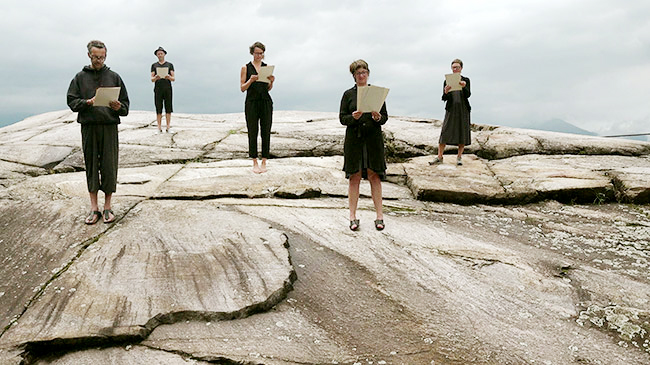 Chorprobe / Choir practice, video still
Chorprobe / Choir practice, video still
personne
A 2016 / 4K / 16:9 / colour / sound / 9:35 min
This short film is a miniature about gazes and perception, about the experience of
observing and being observed. It consists of just one long, tableau-like shot including a quarter circle pan shot.
The narrative structure's vagueness suspends and questions
the boundaries of reality and illusion.
What do we see, when we look? What do we see, when we watch? What do we learn, what do we know then? Can we rely on our perception,
since it is just a partial aspect, one perspective of reality?
The vague and intimate staging creates a surreal, oneiric atmosphere accompanied by a mysterious effect which generates a confusing
feeling – we are exposed to the act of observing and thus forced to be voyeurs.
The film is a kind of a "gestell" – a framework for reflections on the essentials and mechanics of film as well as on film
production itself. In this sense, the make up scene reveals the actress's transformation into the film figure. Thus, it also refers to
Eleanor Antin's video performance
Representational Painting from 1971 in which the act of putting
on make-up as a traditional mode of self-expression was explored and staged, amplifying the observational aspect.
Also, connections to Ingmar Bergman and Alfred Hitchcock are at hand when it comes to the concept of the figure(s): both figure and idea refer to
Bergman’s
Persona on the level of the internal conception, on the level of external conception to Hitchcock’s
Rear Window.
The cinematic action that follows a prescribed plot was shot over the course of a day. Like in rehearsals,
by repeating again and again iteratively the ideal take was worked out. Basically it‘s impossible to do exactly congruent repetitions, so every take within the scope
of action is slightly different than others — even by the change of daylight throughout the day a different atmosphere and light
situation was created.
The installation
personne 1—7 negotiates aspects of film production itself (acting as work, rehearing, decision finding
processes) as well as the construction or the backside of presentation. The frame (german: Gestell), the construction of the installation is partly
exposed and by becoming visible turns into a part of
the concept. 7 selected takes shown one after the other give an insight into the procedures of this particular film shooting.
Thus, film production as well as acting or performing become the narrative subject and let us comprehend the realisation of the cinematic image.
The fragmented form of my film essays, which always means reflecting on film and its production in fragments, is mirrored in the
installation.
Watch an excerpt
here
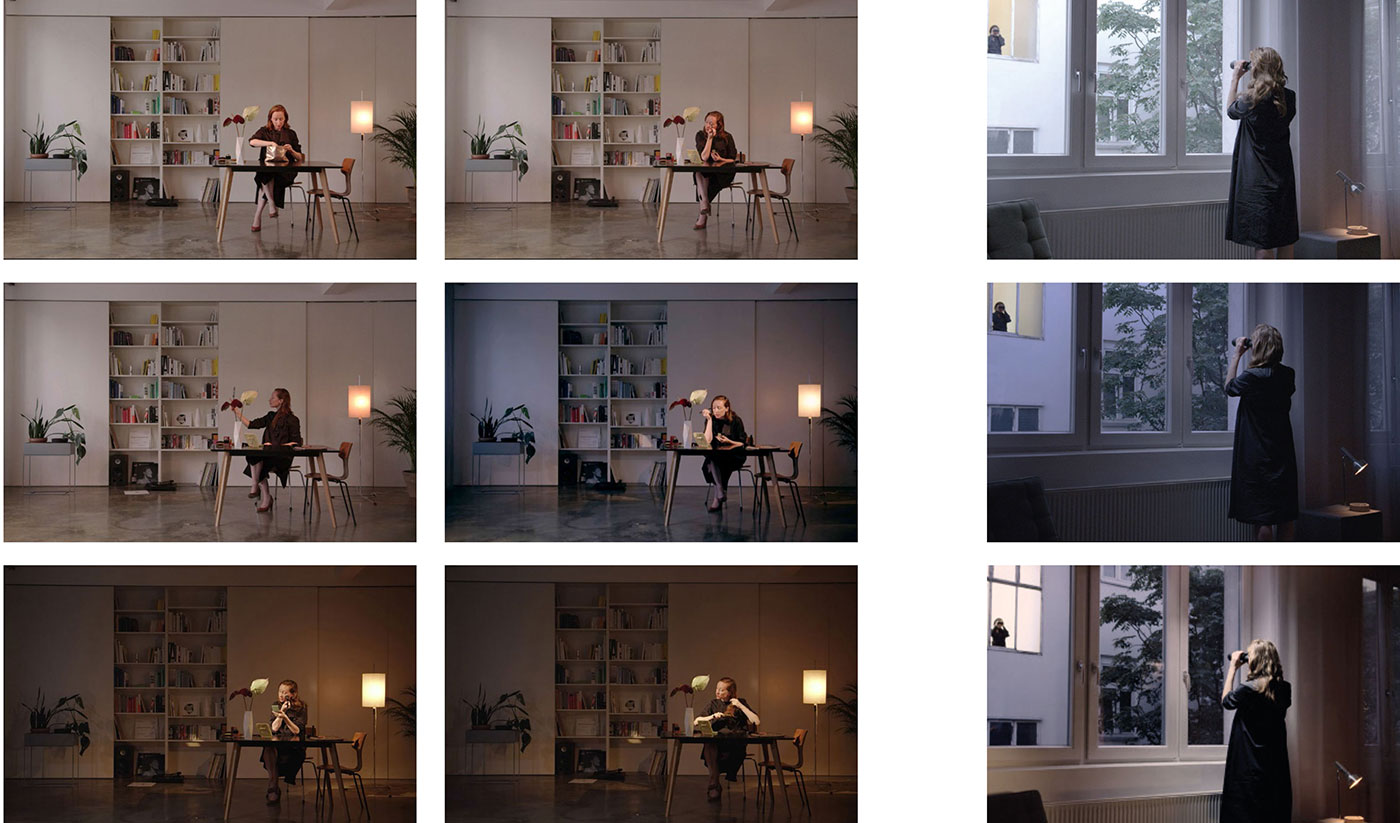 Personne, video stills
Personne, video stills
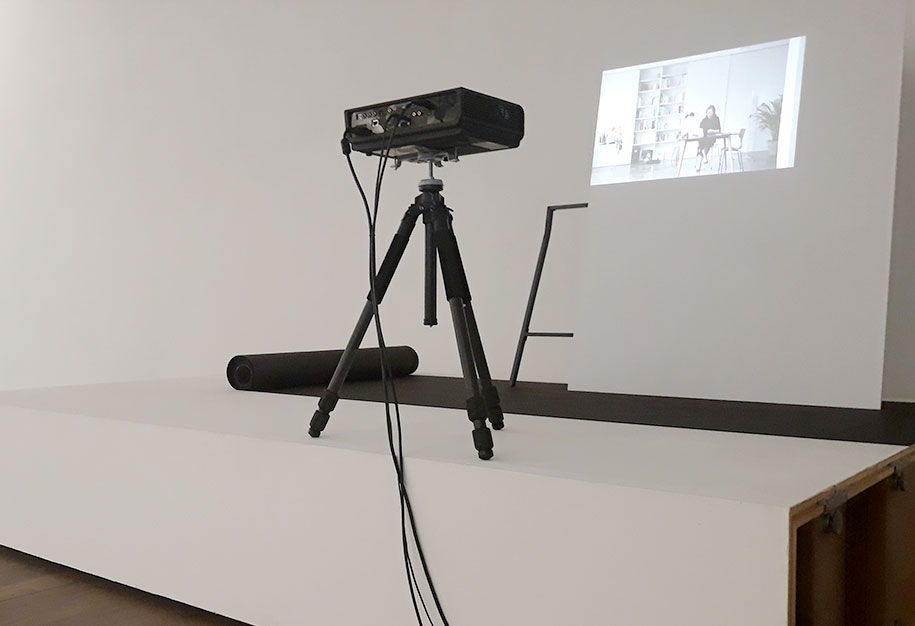
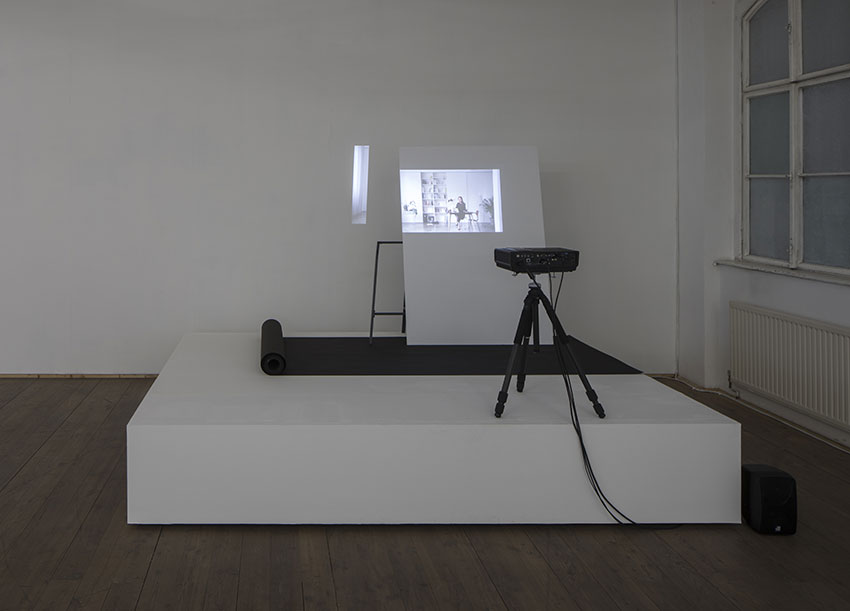 Installation views: kunsthalle exnergasse 2018 © Wolfgang Thaler
Installation views: kunsthalle exnergasse 2018 © Wolfgang Thaler
Credits:
Concept | edit: Michaela Schwentner
Camera: Martin Putz
Sound recordings | sound design | mastering: Nik Hummer
Performer: Stephanie Cumming
Colour correction: Bernhard Schlick
Supported by:
BKA / innovative film
Kulturabteilung der Stadt Wien
reorient.manifest /
a model for a film
A 2016 / Video installation / 16:9 / colour / sound / 4:00 min
scenery: Mediterrenean, Italian or Greek territory, coastal area
stage direction: chorus 1 [behind the curtain]
where are we now?
instruction: chorus 2 [off-stage]
is this Europe?
instruction: chorus 1 [entering stage]
what is Europe?
myth?
spectre?
instruction: chorus 2 [entering stage]
democracy is protected order
a law of silence
security
security?
[randomly repeating]
control
censorship
instruction:
------------- pause
instruction: chorus 1 [normal voice]
this is an act of treason
Europe sells herself
instruction: chorus 2 [whispering]
our protest is silent
silent
instruction: chorus 1
what colour has protest?
instruction: chorus 2 [whispering]
our protest is black&white silence
instruction: chorus 1 [desirous, repeating]
o you are so technical!
instruction [voice lowered]
again!
chorus 1 [sighing]
o you are so technical!
instruction [voice tempered]
again!
chorus 1 [attempting]
o you are so technical!
instruction [expectant]
try again!
chorus 1 [distinct]
o you are so technical!
instruction: chorus 2 [repeating] ------- [critique]
what are we without technology?
what are we without technology?
text insert:
what would Shakespeare say today?
instruction: refrain chorus 1 [repeating]
together we fail
together we fail
together we fail
together we fail
instruction: play song
instruction: refrain chorus 2
enter enter
everything depends on how you enter
enter enter
instruction: chorus 1
listen!
reorient ---------------
instruction: chorus 1 & chorus 2 [together]
act!
[reenact]
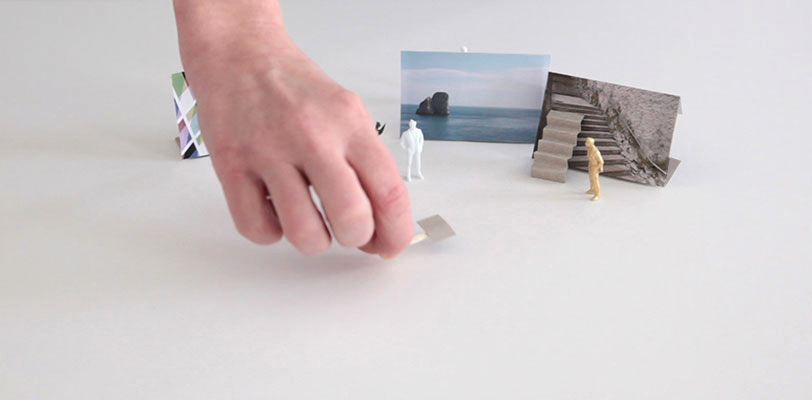
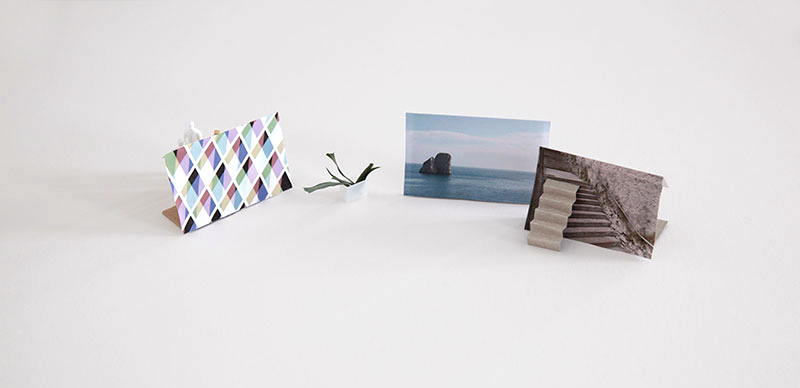
A model for a film. The set design is an assemblage
of several small scenes.
The scenery includes some rather iconic images which refer to a sophisticated Europe and its highly developed state of civilisation with its
apparently democratic, political and critical consciousness.
Since a sellout of European cultural values is to be feared, we as European citizens have to question this so-called system
of values and even a lot more of our ideas and achievements.
This model film is supposed to be transformed into a musical performance with 2 chorus ensembles interpreting the dialogues.
Credits:
Concept | camera | edit | sound design:
Michaela Schwentner
Supported by Kulturabteilung der Stadt Wien
Figures /
Women under influence
2016 / Photographic series / pigmented inkjet prints / variable sizes
The cinematic (action) image as a spatial object, providing a new perception
and interpretation of mechanisms and structures of film production
(like staging, acting, etc.): Cinematic images of iconic films featuring modern women under
a certain kind
of influence, though, are transferred into sculptures created of working and household tools.
By transference and the shifting of frames new reflections on aspects of work and conditions of artistic working processes may be initiated.
The asssemblages are named after the female leads
of those particular films: Camille (
Le mépris, J.-L. Godard, 1963), Martha (
Martha,
R. W. Fassbinder, 1974), Myrtle (
Opening Night, John Cassavetes, 1977), Catherine (
Jules et Jim, François Truffaut, 1962) and Giuliana
(
Il deserto rosso, Michelangelo Antonioni, 1964).
The depictions of the arrangements don‘t provide possibilities of identification; the female film figures are not recognisable as such; instead these assemblages
are complex images: the film concept, the tension of the plot and of the key scene as well as entire distances and motion sequences the protagonists cover are
incorporated, condensed in a way. Thus, the meaning of body is questioned: How much knowledge informs a body, makes it tangible, experiencable, comprehensible,
recognisable? A body is not just a physical sensation, a physical appearance, but also storage for all kinds of information (which over time is inscribed in
the body). How much knowledge informs a body, makes it tangible, experiencable, comprehensible, recognisable?
 fig. 1-5: Camille, Myrtle, Martha, Giuliana, Catherine (from top left to bottom left)
fig. 1-5: Camille, Myrtle, Martha, Giuliana, Catherine (from top left to bottom left)
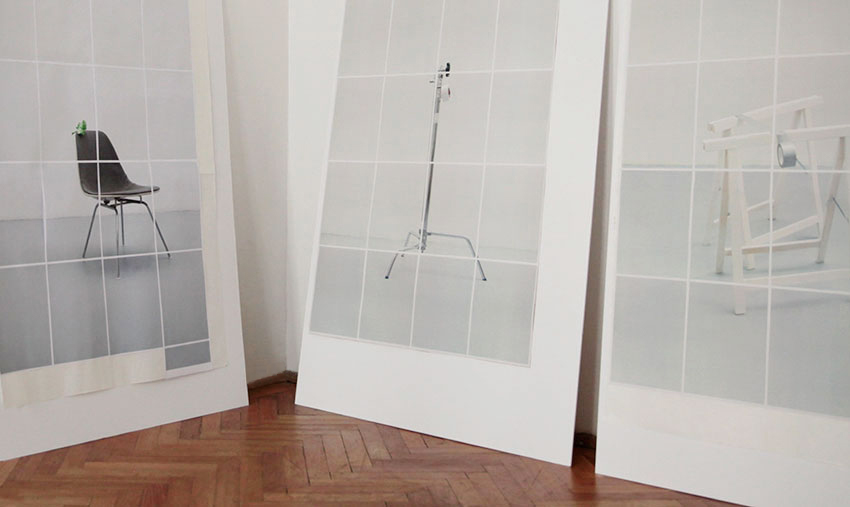 GRUPPENBILD I
GRUPPENBILD I
Camille 1–3
A 2015 / Video installation / 16:9 / colour / 4 min
What makes a cinematic figure? Why is it that not any actress or performer is able to play every role or character?
The short film essay Camille 1—3 is a demonstration of variations of performance (in the sense of acting but also in the sense of efficiency).
It offers the possibility to watch 3 performers playing the same role repeatedly, filmed in different takes and to compare them. How much contributes
the particular performer herself, how much is stage direction?
In Camille 1—3 the being-outside-the-role is essential component of the concept; only when one of the performers wears the bathrobe she is playing (the role).
This piece is at the same time reenactment of a film shooting, and hence the reenactment of Camille‘s role,
a reenactment of an actress‘ acting abilities, a reenactment of Brigitte Bardot‘s performance and furthermore a demonstration of variations of acting.
Furthermore, content-related it is the performed act of Camille‘s emancipation, extracted and isolated, and repeated over and over again..
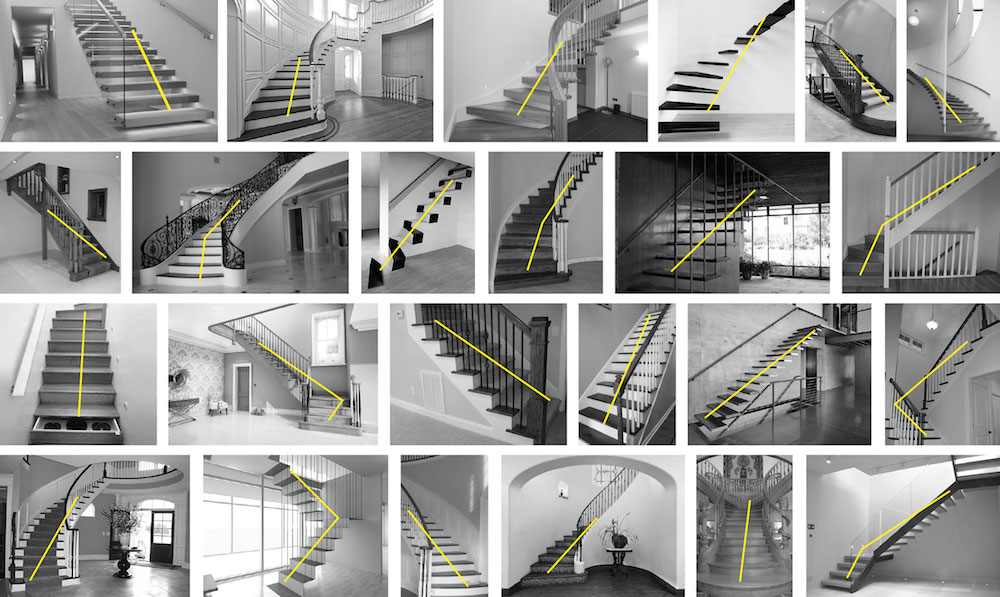 Traces of Camille, sketches
Traces of Camille, sketches
playing Martha
A 2017 / Performance + multi-channel video installation / colour / appr. 10 min
Fragmentary reenactment of the renowned 720º scene from
Martha by Rainer Werner Fassbinder,
shot by his cinematographer Michael Ballhaus.
The camera shot is transformed into an installative performance with a variable amount of performers and each of their particular interpretation and enactment of
Martha, actually their individual mode of slipping into a role by putting on a specific figure's costume.
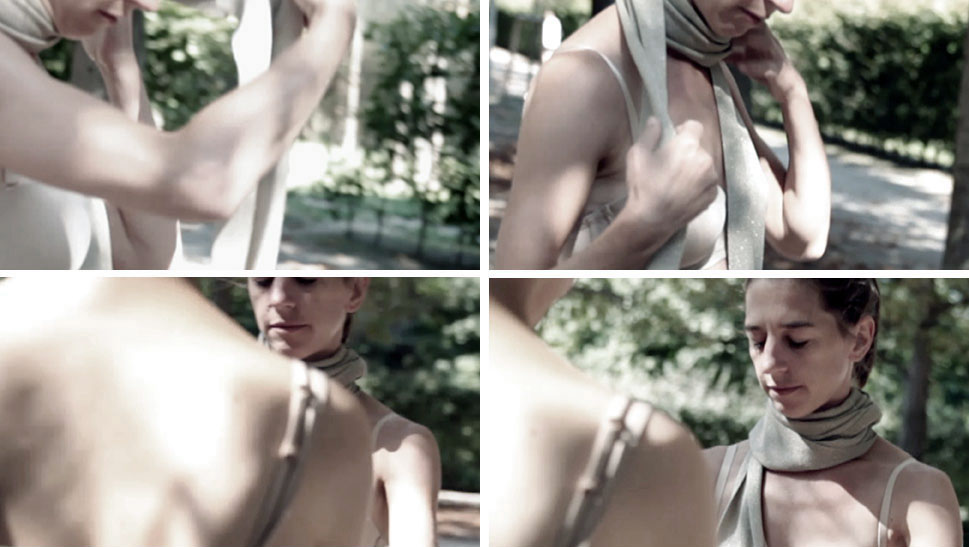 Playing Martha, performance documentation, video stills
Playing Martha, performance documentation, video stills
Credits:
Script | Direction | Camera | Edit | Colour correction: Michaela Schwentner
Sound | Sound design: Michaela Schwentner
Performing artists: Aurelia Burckhardt, Inge Gappmaier, Anna Güssinger, Katharina von Harsdorf, Flavia Meterez, Birgit Unger
IMAfiction portrait #08 Electric Indigo
A/D 2015 / Video / 16:9 / colour / sound / 22:00 min
Video portrait of electronic music dj and composer
Electric Indigo.
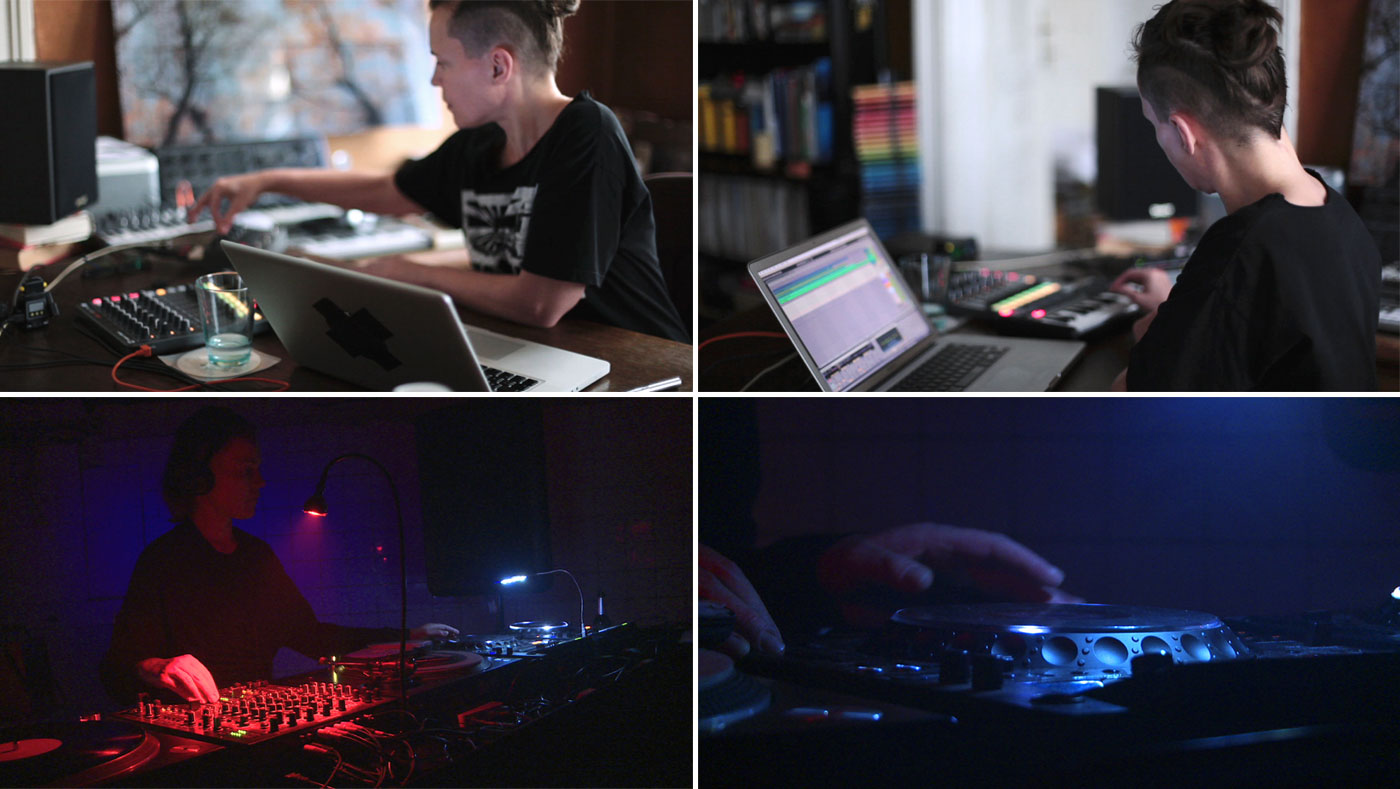 IMAfiction portrait #08, video stills
IMAfiction portrait #08, video stills
Credits:
Concept | edit: Michaela Schwentner
Camera: Andreas Gockel, Michaela Schwentner
Sound | mastering: IMA Institute of Media Archeology
Commissioned by
IMA Institute of Media Archeology
descending a staircase / in shifts
A 2015 / Performance + video installation / 16:9 / colour / sound / 33:36 min
A woman in a yellow bathrobe is descending a staircase - over and over again.
This image of action refers to the film scene from
Le mépris (Jean-Luc Godard, 1963).
The main "character" is in fact the significant prop of the scene, the yellow bathrobe.
The scene is performed by 3 different performers over the course of a day.
The piece is at the same time the reenactment of a film shooting, and hence the
reenactment of Camille's role, a reenactment of an actress' work, a reenactment of
Brigitte Bardot's performance and furthermore a demonstration of variations of acting.
It is the reenactment of the work of an actress, a spatial intervention, a performance,
the actual work of the performers and the video installation in public space.
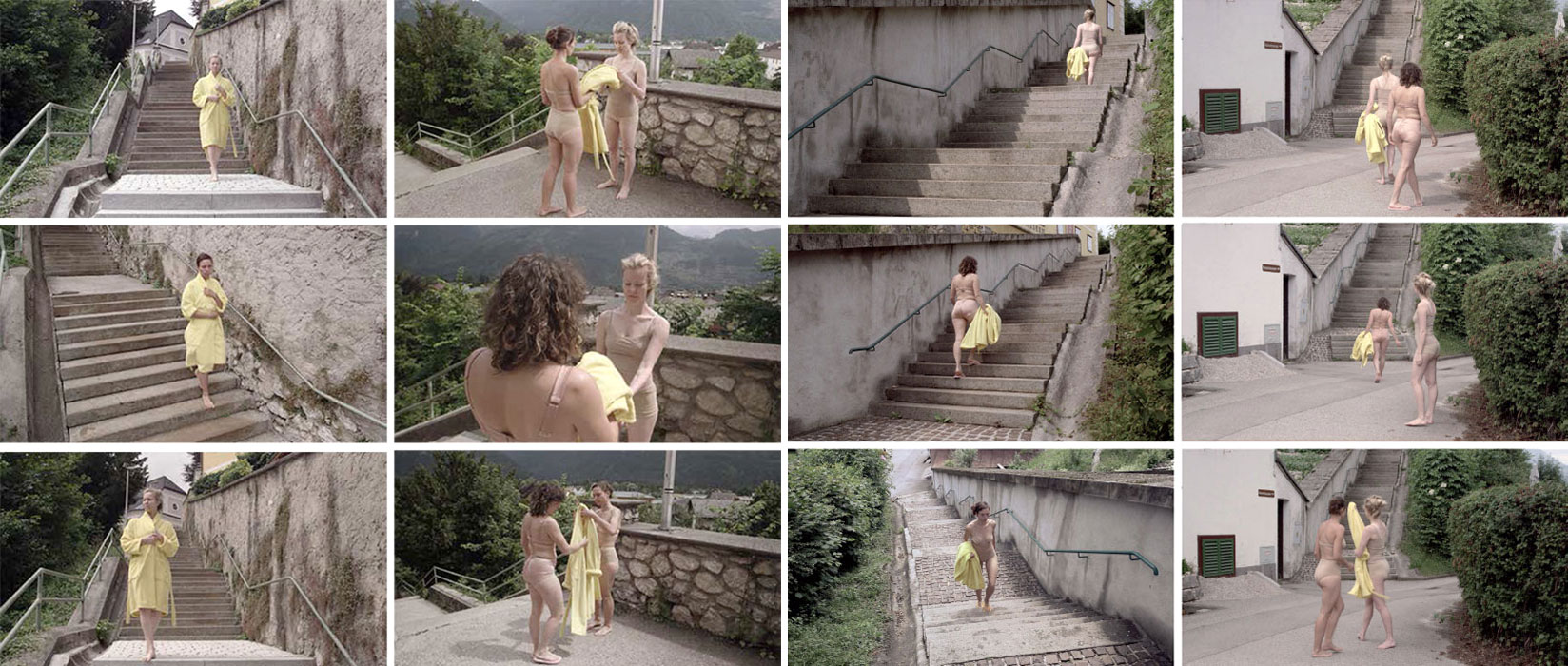 Descending a staircase / in shifts, video stills
Descending a staircase / in shifts, video stills
 From left to right: Making of © Julia Vogt, Making of © dorftv, Installation view © Norbert Artner
From left to right: Making of © Julia Vogt, Making of © dorftv, Installation view © Norbert Artner
Credits:
Concept | edit: Michaela Schwentner
Camera: Martin Putz
Sound | mastering: Michaela Schwentner
Performer: Nina Vobruba, Laia Fabre, Cornelia Böhnisch
Commissioned by Festival der Regionen
Penelope /
in the scenery /
reflecting /
relations
A 2015 / Video / 16:9 / colour / sound / 18:45 min
Penelope (Camille (Brigitte (Anna))):
Everything happened in the dizziness of a high
Our love was so vast
Everything was new and exciting
[break]
It was so good.
Direction:
Again!
Penelope (Camille (Brigitte (Anna))):
Everything happened in the dizziness of a high
Our love was so vast!
Everything was new and exciting
[sigh]
It was so good!
Direction:
Again!
The film shows two women sitting in the scenery of a theatre or in the backdrop of a film set.
It's not clear whether they
are already acting or waiting for their scene, trying to kill time by telling stories and reflecting on film-immanent matters.
Are they outside their role, outside the film set or are they acting in a film which is about two women playing in a play or a film,
waiting for their scene and telling stories which (seemingly) have nothing to do with the situation they are in? Are they rehearsing?
Text inserts are displayed which show stage directions but also questions addressing the lead figure Penelope,
asked by an invisible audience or other film figures as well as her reactions on them.
Some scenes are repeated several times, but still it is not a rehearsal, but instead a film that uses montage of image and sound
to transfer figures from one context into another or a new one and by that question the previous one and furthermore question the production
per se and its aesthetic realisation.
This film is on the one hand about Penelope, told from a contemporary and emancipated perspective, and on the other hand about storytelling,
staging and playing itself: Penelope is knotting and interweaving fragments of her personal love stories, while she is also reflecting on film,
acting and narration per se by retelling stories and by reenacting several iconic film scenes.
Fragments of stories are interlinked and interwoven to assemblages. These fragmented and re-arranged narrative threads which refer
to different contexts create a new narration-image. The level of narrative partly follows the principle of the mise en abîme.
The formal level also follows this principle and consists of fragmented images and reflections. The reflection on narration and on
projection has its equivalent on the formal level in the sense of mirroring.
The film can also be read as a passionate tribute to film and film-making, as a reflection on film-making,
the interest in modernism and its reproductive technicality. It also shows by recontectualising several iconic film scenes that film production
is always connected with the time present.
Watch an excerpt
here
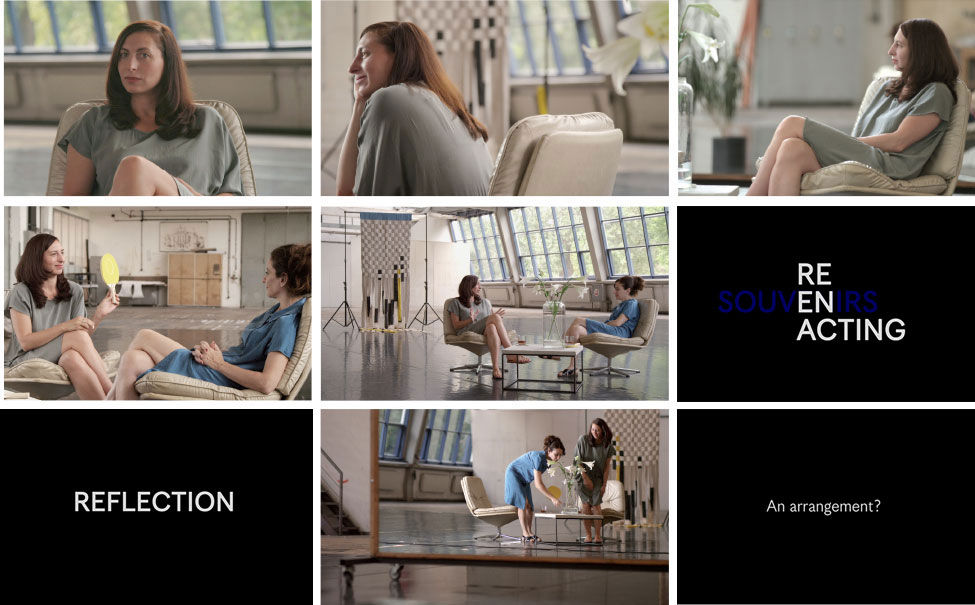 Penelope, video stills
Penelope, video stills
Credits:
Concept | edit: Michaela Schwentner
Camera: Martin Putz
Sound | sound design | mastering: Nik Hummer
Performers: Anna Mendelssohn, Irene Coticchio
Supported by:
BKA / innovative film
Kulturabteilung der Stadt Wien
the contest
A 2015 / Video / 16:9 / colour / sound / 16 min
This film is both cinematic reconstruction and staging and refers to a pop-cultural moment of 20th century history.
I was interested in the intersection of historic moments and aesthetical practices and in the examination of our relationship to collective
historic and visual experience. In a sequence of about five minutes
The Contest shows two young female performers in a gymnastic
performance situation. The minimalistic setting of the scene filmed in a real but still staged studio unfolds in static shots and shows the performers primarily
in long shots by considering the symmetry of the image.
The performers' movements equal real practising movements of figures skaters, still the reduced image composition lets the choreography appear
somehow artificial.
The formal aesthetic approach to the historic event which is grounded in the collective memory and visual archive on one hand and to the
presentation of subjective experience on the other hand result in a stylised image which is supposed to merge into a timeless form.
It was not my intention though, to dissolve the historic event in the aesthetic, but to objectify it by reducing all narrative moments.
The negotiated historic event was a spectacular case in the history of US-American figure skating: during a decider preparation for a championship
one of two rivals was attacked and incapacitated; the other athlete got linked with the attack and was subsequently suspended from all further
championships.
 The Contest, video stills
The Contest, video stills
Credits:
Concept | edit: Michaela Schwentner
Camera: Martin Putz
Sound | sound design | mastering: Nik Hummer
Performer: Verena Renner, Melissa Imamovic
Supported by:
BKA / innovative film
Kulturabteilung der Stadt Wien
A STONE /
A WORD /
ACTIVATED /
BY
ABDUL SHARIF BARUWA // EVA BODNAR // HERBERT DE COLLE // PLAMEN DEJANOFF // HEINRICH DUNST // MARINA FAUST // VERONIKA HAUER // GERHARD HIMMER // SIGGI HOFER // NICOLAS JASMIN // DANIEL KNORR //
ELKE SILVIA KRYSTUFEK // SONIA LEIMER // JOHANN LURF // CHRISTIAN MAYER // ALBERT MAYR //JOSH MÜLLER // MICHAEL PART // ELISABETH PENKER // ROMAN PFEFFER // JOSEF RAMASEDER // BERNHARD RAPPOLD //
FRANZ SCHUBERT // CONSTANZE SCHWEIGER // MICHAELA SCHWENTNER // AXEL STOCKBURGER // CHRISTIAN STOCK
2014 / Frottage, Blickle Raum, Vienna
re-PARADISE /
reconstruction of botanical archives
by reenacting representative complexities
in history
2014-2016 / Baryte prints / series of 7 images / 80cm x 128cm
Paradise: a state, a place, a garden, a greenhouse, a gift, a souvenir, colonised land, uprooted life?
This photographic work is based on botanical gardens in the Western world, mainly in Europe.
I was interested in the plants themselves and their existence as mute witnesses of (historical) political conquest.
The prefix
re- in the work title refers to the reconstruction of an idea, an image, to the technical reproduction of the photographic material,
on the other hand it is associated with the term repair which is linked to Walter Benjamin’s
Angel of History.
Repair is to be understood in a cultural, political or natural sense, but also as a socio-cultural, gender-geometric concept.
All depicted plants (monstera deliciosa, ficus elastica, dypsis lutescens, livingstonia rotundifolia, banana) originate from regions which have been —
and partly still are — colonised and exploited by the Western world. Thus, these plants found their ways to botanical gardens for research and
educational reasons or to our living spaces for decorative purposes and simple pleasure.
Walter Benjamin wrote, history only can be reconstructed when presence is manifest within. Thus, the botanical garden as an archive is useful for
research and to comprehend the complexities of representation and to reconstruct history. Conflicts from the past can’t be rectified ex post facto,
but our approach to history can be changed by contemporary reflection which might include reappropriation and repair.
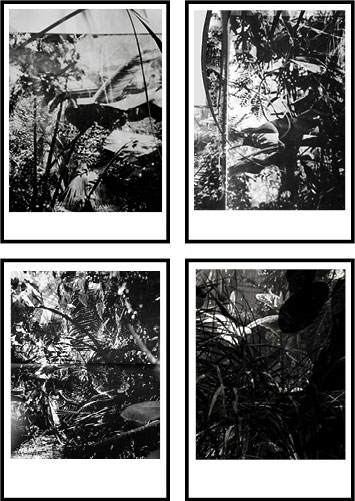 re-PARADISE / reconstructing botanical archives by representative complexities in history into moments of desire N°6-N°9.
N°6 acquired by Sammlung Wien Museum (2019)
re-PARADISE / reconstructing botanical archives by representative complexities in history into moments of desire N°6-N°9.
N°6 acquired by Sammlung Wien Museum (2019)
re-PARADISE
2022 / Installation / Baryte print 63cm x 112cm, honeycomb cardboards,
glass panel, video (16:9, b/w, sound, 33:30 min, loop), puzzle 1000 pieces
The installation
re-PARADISE combines selected text
and sound layers of my film
prospects, the Baryte print
reconstruction of botanical archives by reenacting representative complexities in history #01 and an unfinished jigsaw puzzle
for which the same motif of the baryte print served as a model.
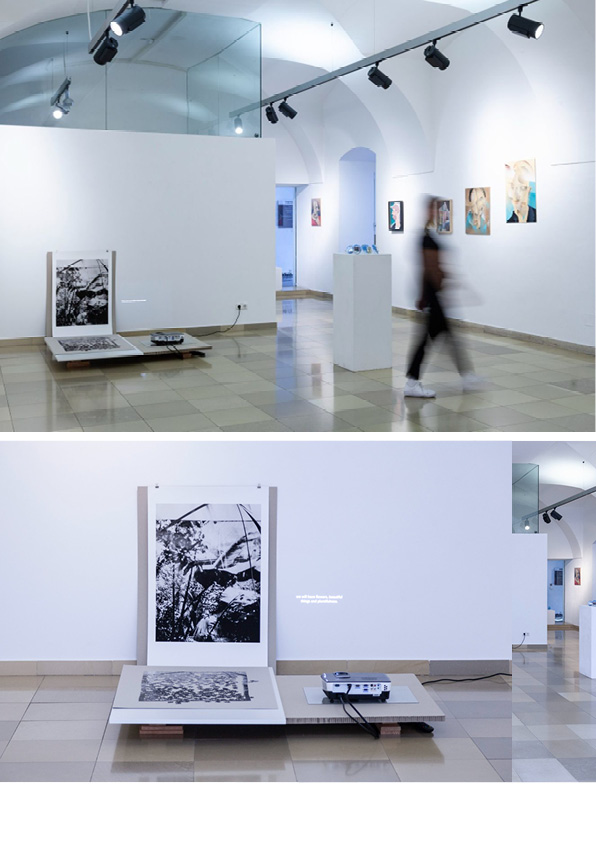 Everlonging installation views. Galerie der Kunstschaffenden Linz, 2022
Everlonging installation views. Galerie der Kunstschaffenden Linz, 2022
re-PARADISE /
reconstructing archives
by rendering representative complexities
into moments of desire
2018 / Installation + performance / B/W prints / 17 images / different sizes / transmission oil
In this installation photographed content of botanical archives is transferred into actual
context. In addition to digital prints "archived" techniques, technologies and materials are used, like transmission oil, a petroleum distillate,
and developing trays.
Oil seals material and timeliness like film. Film, the coat, transparent and impermeable like varnish, fixates and secures a painting,
carries and transports (moving) images - film.
The pictures which were made in botanical gardens refer - like a botanical garden itself – to something absent or past: plants as witnesses of colonial conquest, diplomatic, political, representative strategies.
The wish to fill a gap, to turn the significate into the sign itself, to manifest the referential; to fulfil the desire for transferring the absent
or the past into something representative shifted, is the idea of this poetic-technical arrangement.
Representative complexities create projection spaces and consist of superpositions, layerings, fragmentations and ambiguities in a social, historic,
theoretic or interpretative sense. The assembled prints in the exhibition are layered images, originally taken in various botanical archives, which want
to create a space of longing in this specific display.
Yet, the question of the intention of collecting must be asked, for archives are never innocent.
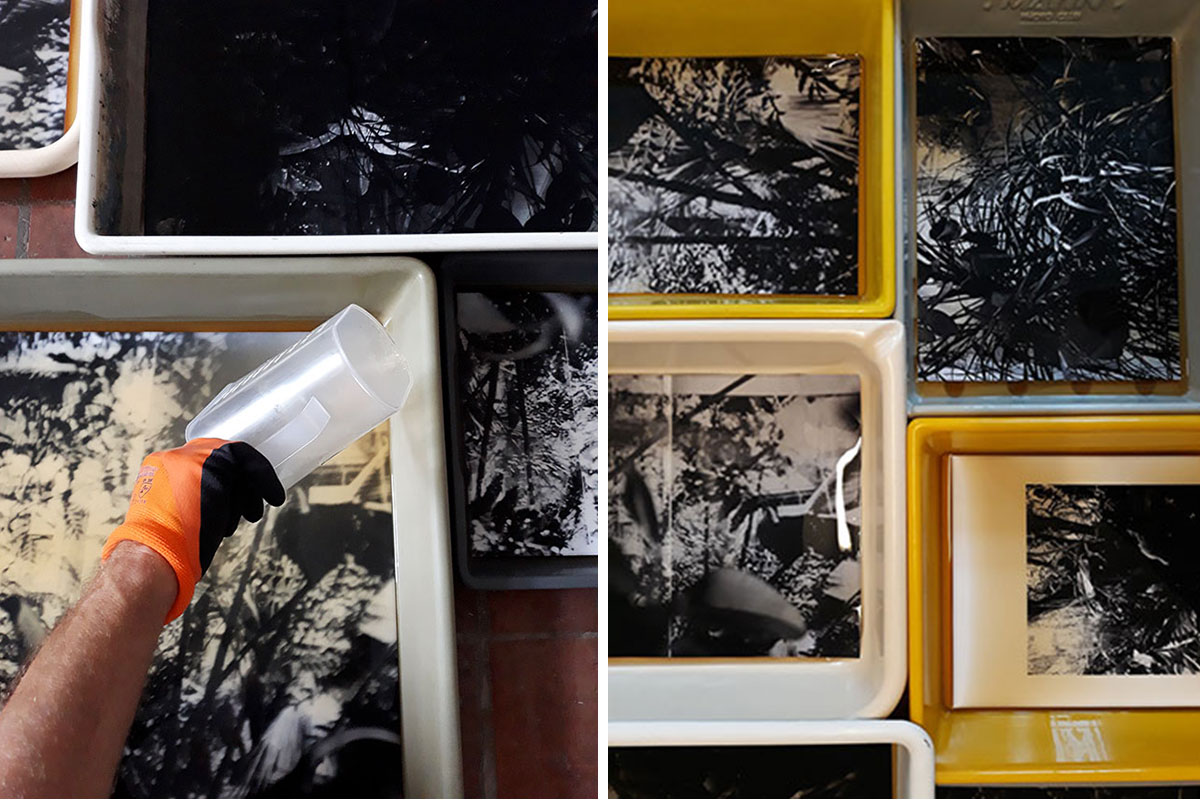 Installation view and performance documentation details. ANNA offspace, Vienna, 2018
Installation view and performance documentation details. ANNA offspace, Vienna, 2018
un divertissement d'amour
A 2012 / video installation / 16:9 / colour / sound / 11 min
This film is a kind of rearrangement of Plato's
Symposion based on philosophic essays on love and it is also inspired by the
Surrealists'
Recherches sur la sexualité.
The film structure refers specifically to Sergej M. Eisenstein's definition of the mise en cadre and concentrates precisely on the
possibilities of revealing or hiding substantial film-immanent information.
Watch an excerpt
here
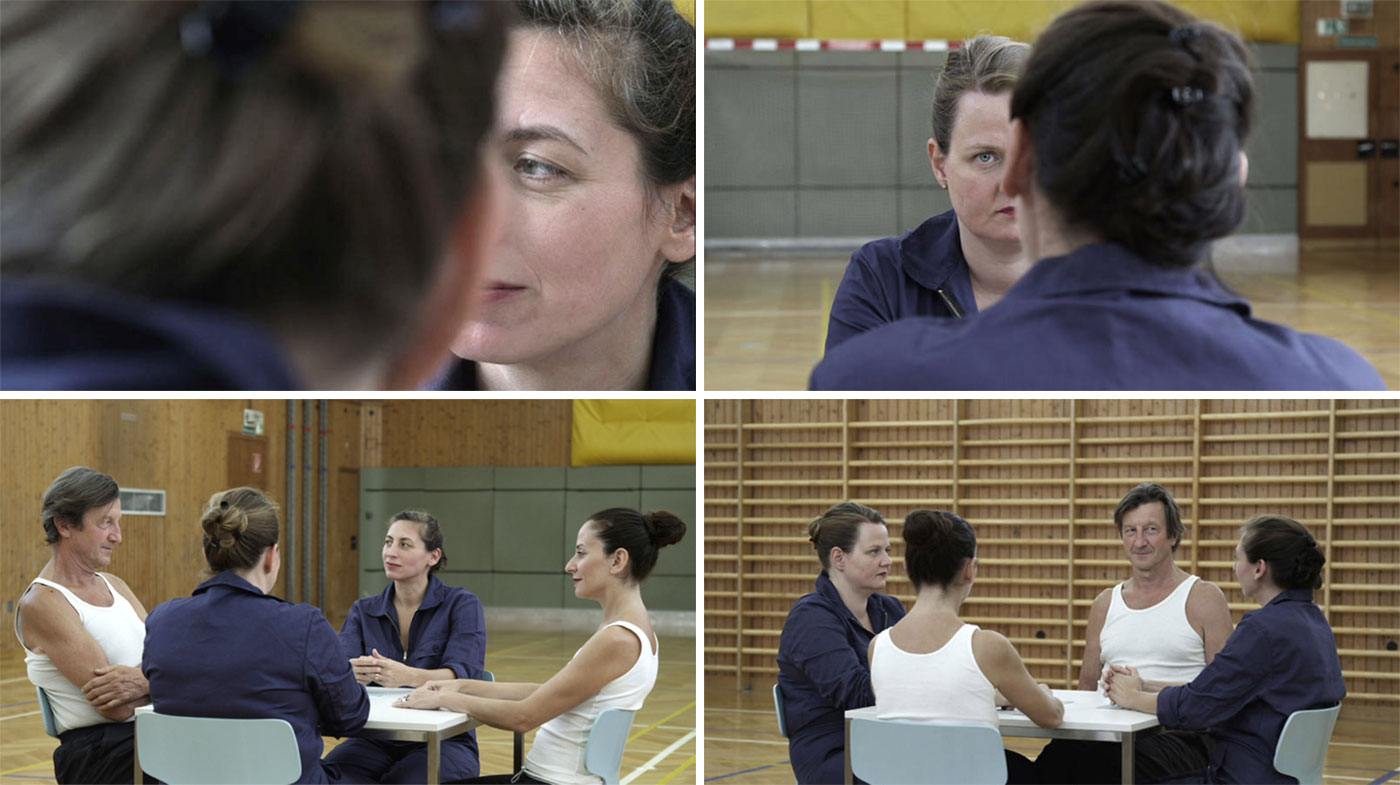 Un divertissement d'amour, video stills
Un divertissement d'amour, video stills
Credits:
Concept | edit: Michaela Schwentner
Camera: Martin Putz
Sound | sound design | mastering: Nik Hummer
Performer: Anna Mendelssohn, Irene Coticchio, Liese Lyon, Hubsi Kramar
Supported by:
BKA / innovative film
Kulturabteilung der Stadt Wien
Land Oberösterreich
26 days
2012 / Video installation / 16:9 / colour / 1 min
This work was created during my residency at a remote place near Rome.
It emerged from the situation I was in there for the period of four weeks.
The work was an examination of experiencing time and transience and its impact on me.
Installation: imPORT, Studio PORT, Vienna 2012
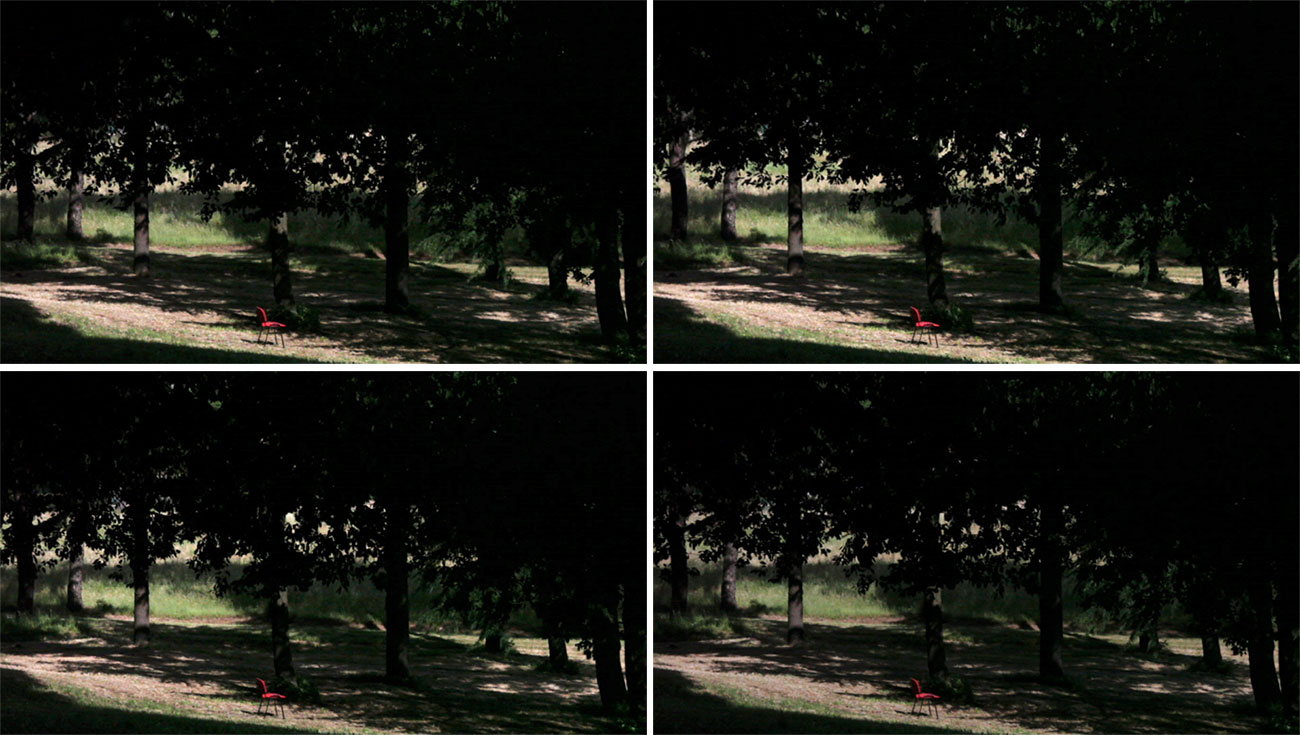
re-PARADISE /
The Camp
2012 / Installation / 30-40 diffent plants in pots, tent construction with transparent plastic sheets
30-40 plants of different sizes and proveniences in pots (palm trees, ficus elastica, marginatas, fejkas, figue trees,
bananas, etc.) are arranged in a rectangle under a tent made of transparent plastic planes to protect them from heavy rainfalls.
The plants stand close with only little space between them. So it’s not really possible or easy
for people to move between the plants, apart from the aspect of inconvenience there’s also the aspect of respect (risk of damaging the plants) and restriction (what does it mean
to be not allowed to enter a space, even if it’s "just" plants?). How do plants grow under new, unknown conditions?

re-PARADISE /
prospects modifiés
2012 / Multi-channel video installation / 16:9 / colour / sound / 8 min
Modified version of the film essay
prospects (2011).
The term prospect is used in a more condensed way, in the way of a promise,
in the way travel agencies use it for their holiday offers. For this work interviews
from the essay have been reduced to simple, catchy slogans.
Installation: RHIZ SCREENS,
rhiz, Vienna 2012
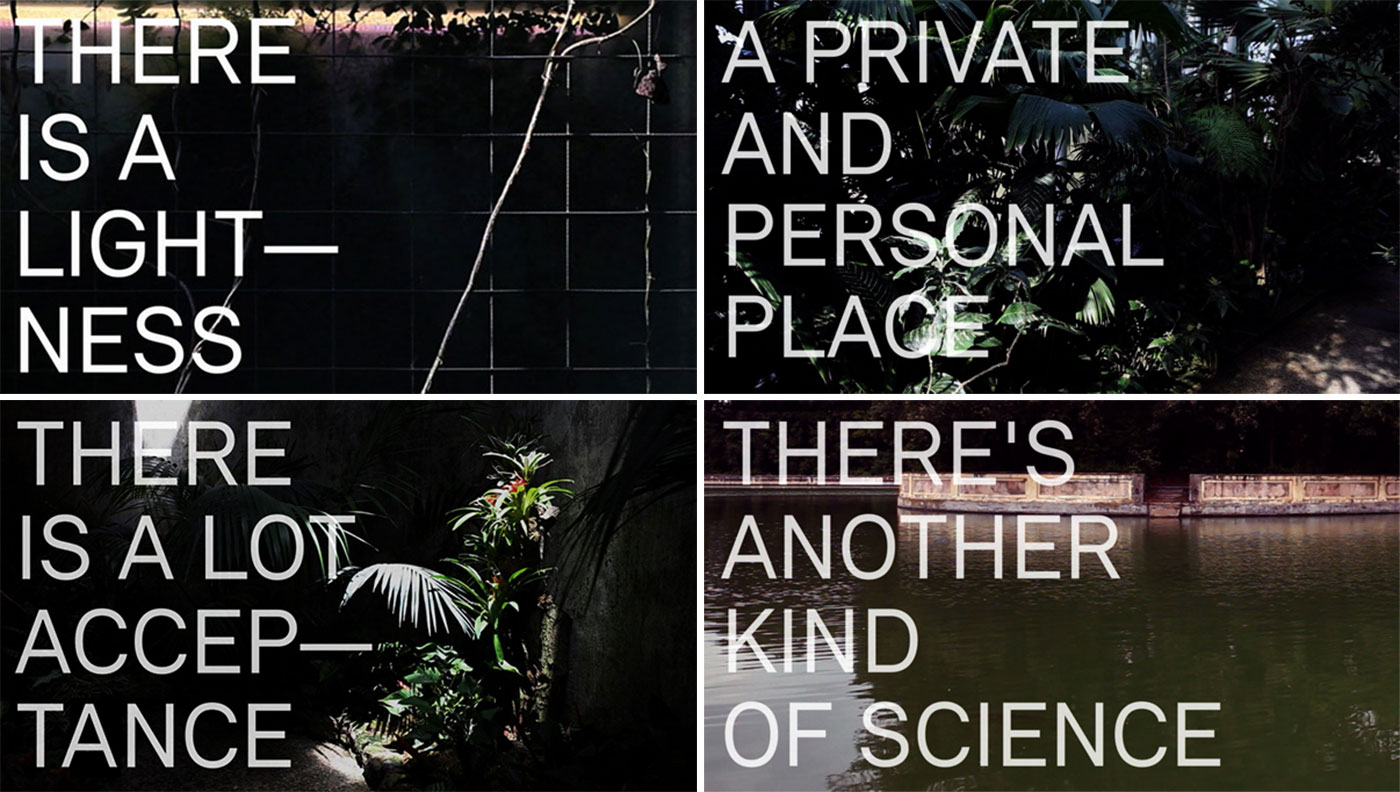
re-PARADISE /
prospects.split
F/I/AL/GR/TR/EG/MA/IL/A 2011 / Video installation / 16:9 / colour / sound /
32 min
A film essay about women in the Mediterranean and their concepts of paradise.
It consists of interviews with women from this area and images of paradise places like public parks, private gardens,
botanic gardens.
The video is an assemblage of these images and the interviews and it is accompanied by field recordings and subtle sound pieces which have been composed particularly for this work.
Installation: GRENZWELTEN / LEERE LINIEN,
Kulturbrücke Fratres 2013

Installation view Kulturbrücke Fratres [A/CZ]
re-PARADISE /
La route du paradis
2011 / Fixing pins on cardboard, framed. 34 cm x 22 cm
Side project of
Prospects. The map of fixing pins shows the cities in the Mediterranean area I visited for my research and interview
work.
SAUNA, brut Konzerthaus, Vienna 2010
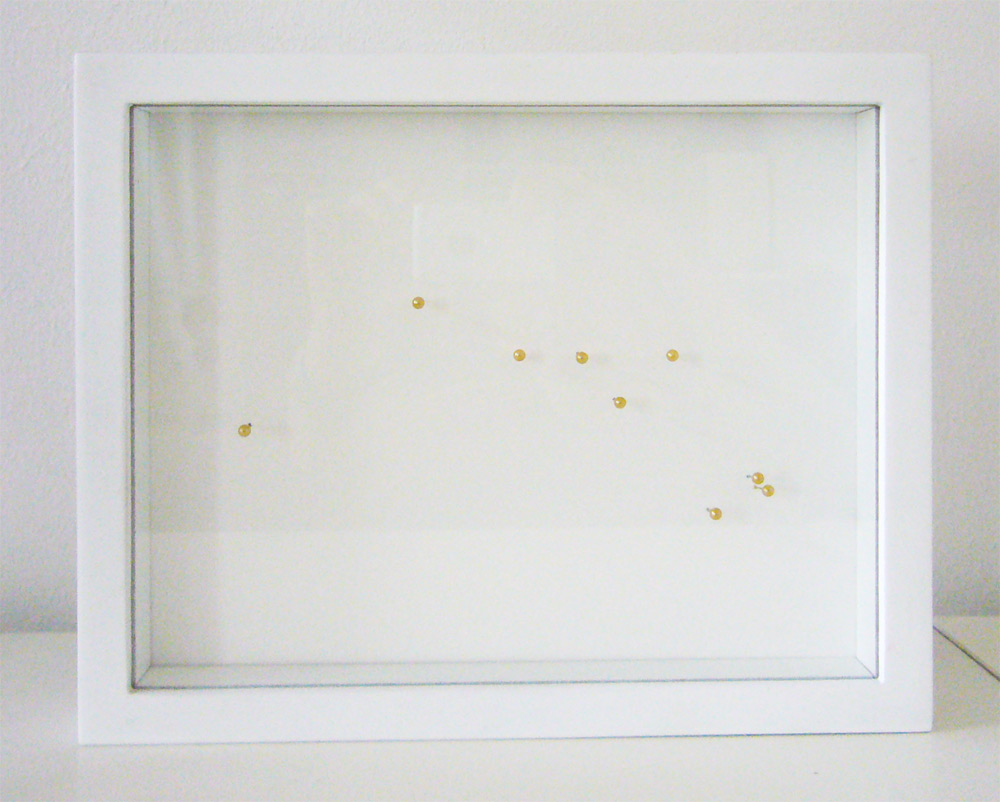
re-PARADISE /
It will all be differerent
2011 / Text on memo-cube, 11 cm x 11 cm
Error correction by repetition?
Or realisation by repetition?
Can a wish become true if you repeatedly
write it down some hundred times?
AFFENARBEIT, Area53, Vienna 2011
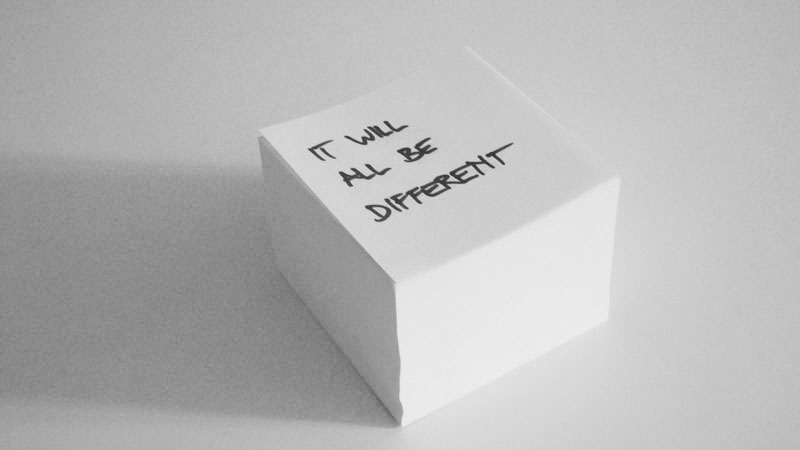
autoradio
2009 / Social plastic: sound performance + live radio broadcast / 30 min
Sound composition: Michaela Schwentner
Live radio broadcast of a sound performance in the frame of Reheat Festival at Kleylehof Nickelsdorf, Austria.
The situation of a drive-in cinema was converted into a drive-in radio broadcast.
The live sound performance was broadcast via local radio frequencies and received via radios in cars parked at the venue.
In German the pun makes more sense: the autokino is turned into an autoradio (which also means car radio).
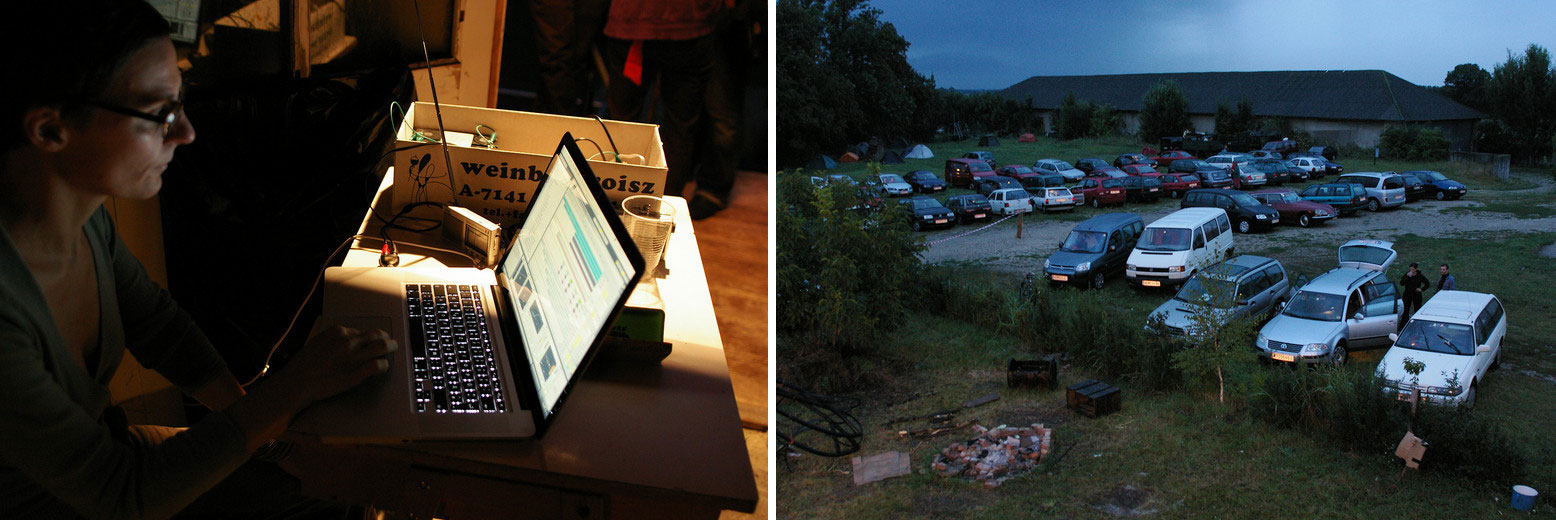
des souvenirs vagues
A 2009 / Multi-channel video installation / 16:9 / colour / sound / 8 min
Sound: Michaela Schwentner
Des souvenirs vagues is a film essay about visual memories and their repetitions, shifts and refractions and about desire.
Even the choice of the film material and aesthetics is an utterance of desire: the seemingly analog film aesthetics has
been created digitally. In this way it corresponds to desire as a longing for past times with the only existence of analog film.
It’s also a poetic reference, a blank which senses desire, which refers to an unknown, an unpronounceable desire.
The film's main elements are vaguely remembered, kind of stereotyped scenes en miniature – they could be from a film,
but also someone's personal memories or desires.
Like in many of my works this film negotiates (re)constructions of female role models, depictions and images of women which are formed
by the absence of the body and by almost pure reflection. In this way, only traces or fragments of actions or the body are perceptible.
Watch an excerpt
here
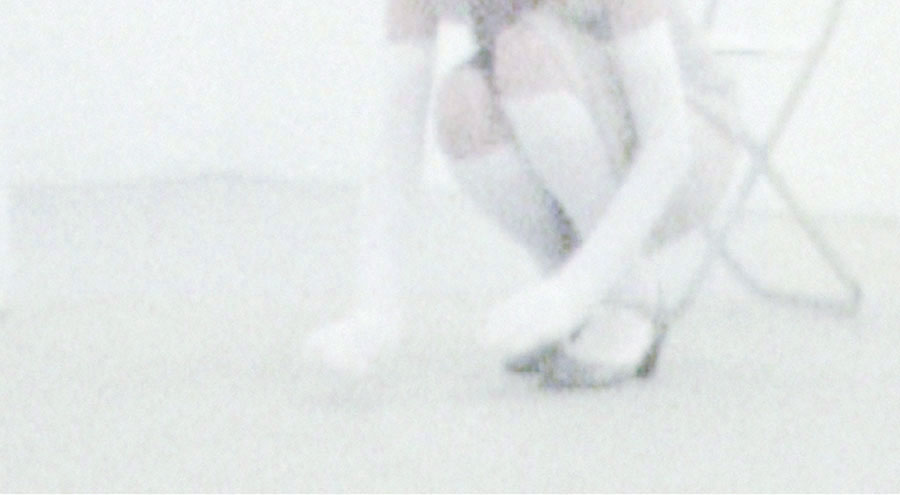
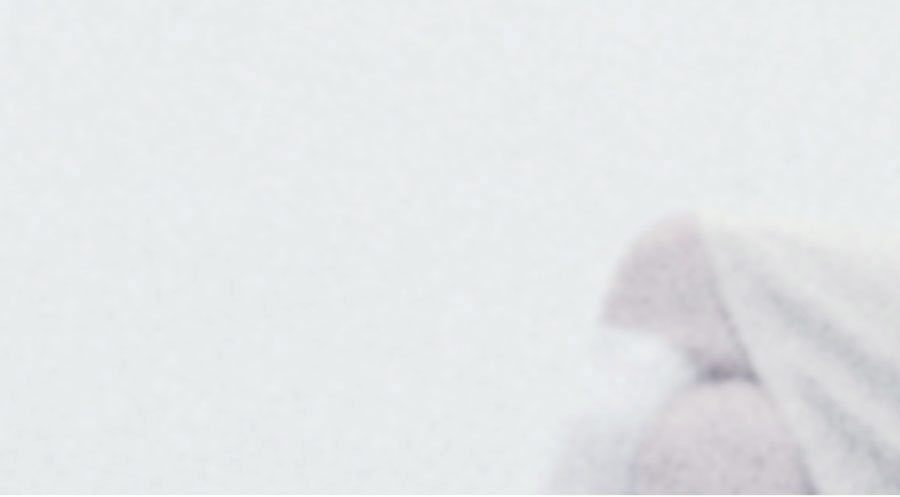 des souvenirs vagues, video stills
des souvenirs vagues, video stills
adapted relations
2013 / Installation / prepared table, projector, variable size / video 4:3 / Loop
A projection equipment which has been turned into a space-defining sculpture,
an adjustment with a new prefix. A miniature, adapted for a small sized exhibition space and its site-specific conditions.
The projected film itself is a demonstration of adapted relations: Images which were produced by webcams
and saved, collected, sorted, assembled and animated, are available via mouse-click.
The poetic moment is generated from the apparatus, the installation, the illusionist machine, is detected.
The apparatus is moved in its true light and therefore into the centre of perception.
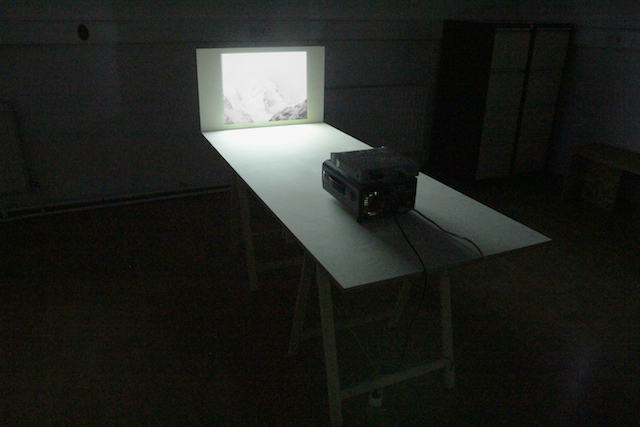 Installation view K48, Vienna 2013
Installation view K48, Vienna 2013
alpine passage
A 2008 / Multi-channel video installation / 4:3 / colour / sound / 6 min
Sound: Michaela Schwentner
Alpine Passage is a film comprising individual images about a journey across the
Swiss and Austrian Alps.
The mountains, impressive as a painting, and in front of them a sort of architecture that enables either a panoramic or a close view.
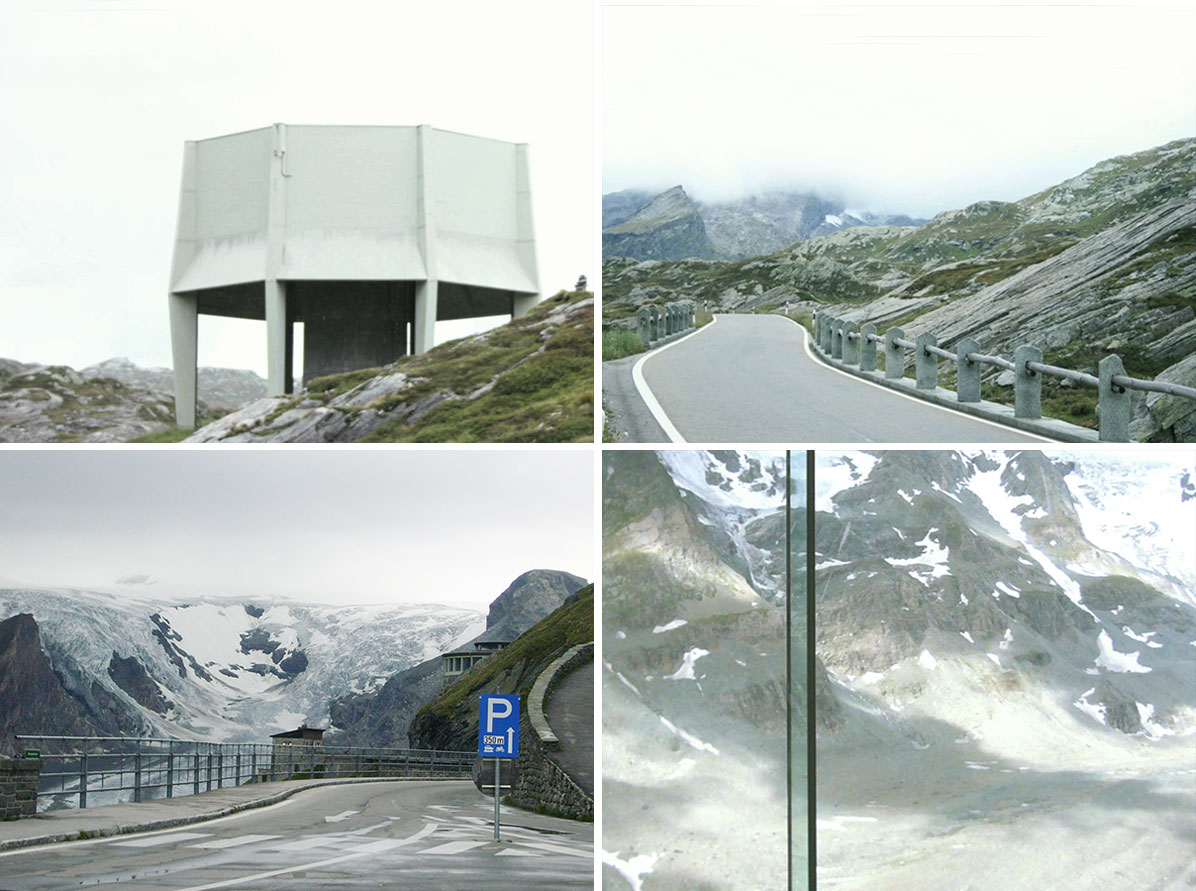 Alpine passage, video stills
Alpine passage, video stills
bellevue
A/CH 2007 / Video installation / 4:3 / colour / sound / 9 min
Sound: Michaela Schwentner
Snow, fog, clouds and in the midst of it all, a barely perceptible massif. Or, better yet, a white noise from which contours gradually emerge and just as steadily dissolve back into:
As though ghost lights in the digital image-fog that dominates the expanse of this composition. A mountain peak, only vaguely discernible
for the longest time, that halfway disappears again the moment it appears.
The starting material for
Bellevue are webcam recordings from Grossglockner that she collected for months and condensed into a nine-minute time image.
Schwentner's method benefits from the rigid takes, mainly because within them, the interplay of appearing and eluding, of revealing and concealing, can develop the greatest possible effect.
Thus, the figure of the mountain uncovers and covers itself in a constant,
modulating movement: ridges and slopes peel from the whiteness of the surroundings, to then immediately vanish again within it.
Accompanied by a subtle ambient-like rustle, which Schwentner gathered from the direct transformation of the image into sound data,
the vision continually clears up and becomes disarranged. As though the mountain, seen and photographed millions of times,
does not want to disclose its identity so simply; yes, as though the apparently banal weather panorama recordings harbor
a key of sorts to the disappearance of the supposedly most unchangeable natural things.
The beautiful view is fundamentally blurred as a result of Bellevue. Not by things incidentally blocking it, such as snow, fog, or clouds,
but by a basic instability in the process of (electronic) seeing itself. The more persistently it pursues the phenomena, the more they
keep themselves covered from time to time.
(Christian Höller)
Watch an excerpt
here
 Alpine passage, video stills
Alpine passage, video stills
Credits:
Concept | edit | sound design: Michaela Schwentner
Supported by: BKA / innovative film
noctiluca
2011 / 10-Channel audiovisual installation / 10-30 min
Commissioned audiovisual work for RML CineChamber [w/ Peter Rehberg].
Live presentation premiered at
musikprotokoll / steirischer herbst Graz 2011.
Watch excerpt on vimeo
 Adapted version at KLANGMANIFESTE 2014, k/haus passage Vienna, documentation images
Adapted version at KLANGMANIFESTE 2014, k/haus passage Vienna, documentation images
chanter toujours
2011 / Sound installation / Loop
The sound installation
Chanter toujours is an allegory: a special sound is extracted from its original
context and is transformed into an new one: the always singing cricket prolongs the summer and should be – as sound intervention – hopefully a
nice surprise in the cold season. At the same time
Chanter toujours is an infinitive invitation to sing or make sound - more and almost any time!
Installation: KRPYTOPHON, Hörstadt Linz 2011
composition set //
image transformed //
Mozart moved
A 2006 / Single channel video / 4:3 / colour / sound / 1 min
The idea was to transform a picture of Mozart on the basis of a new composition arranged with
the so-called musical dice game, sound-controlled manipulation and also a dismantling of the common clean
and kitschy Mozart image.
A bright frontal picture postcard view of a Mozart statue is turned into a rough, decaying picture.
This turnaround within an extremely short period of time also represents life's progress and decay.
The alteration is equivalent to a life cycle: The lush color from the beginning fades, the leaves shrivel,
the tree disappears, the postcard with Mozart's picture yellows and becomes a Mozart of stone.
The manipulation on the musical level was inspired by the musical dice game as played in Mozart's days.
The composer himself wrote short pieces and re-arranged the individual measures according to a roll
of the dice. For the film short samples of violin concerto #3 and symphony #38 have been used and processed.
Commissioned by Mozartjahr 2006.
Screenings (selection): Diagonale Graz 2007, Crossing Europe Linz 2007
 Composition set // image transformed // Mozart moved, video stills
Composition set // image transformed // Mozart moved, video stills
swinging
A 2006 / Video installation / 4:3 / colour / sound / 9 min
Sound: Michaela Schwentner
A bridge with an arched metal structure stretching over it is visible on a white field. The colours are subdued -
grey and black, various shades of brown, blue and green – though they seem quite intense on the light background. The places connected
by the bridge aren't visible; portrayed as an isolated structure, it becomes the focus of an analysis in the medium of film.
In contrast to some of the other videos made by Michaela Schwentner, the subject is easily recognisable in this case. At the same time the artist discovers an
individual life in the architecture, which lets the concrete form slip into abstract patterns. The perspective shifts repeatedly, and different views of the
structure appear. One shot fades into the next, and the movement of the pixels can literally be observed. This creates graphic and painterly moments, the play of
light and shadow, lines and planes turns into a hypnotic game of deception.
The camera's gaze is directed at the structure's details and unusual views so that individual portions of the bridge no longer seem to be
bound to a certain function, and other fields of association open up in its formal structures. The geometric shapes resemble sketches,
the cables between the bridge and its superstructure are like drawn lines, which lends the originally monumental structure of concrete and
steel something fragile, translucent and with that a buoyant lightness.
In contrast to a sketch, however, swinging also makes the three-dimensional character of its subject tangible, not least through the use of
the soundtrack which was also created by Michaela Schwentner. The shimmering of the dimensions and the materiality of the representation are
underlined by the audio level. Each kind of material seems to have its own characteristic sound, and after electronic alteration
it creates an acoustic landscape surrounding the bridge, which seems to «swing» from time to time. (Andrea Pollach)
Screenings (selection): Diagonale Graz 2007, Crossing Europe Film Festival Linz 2007
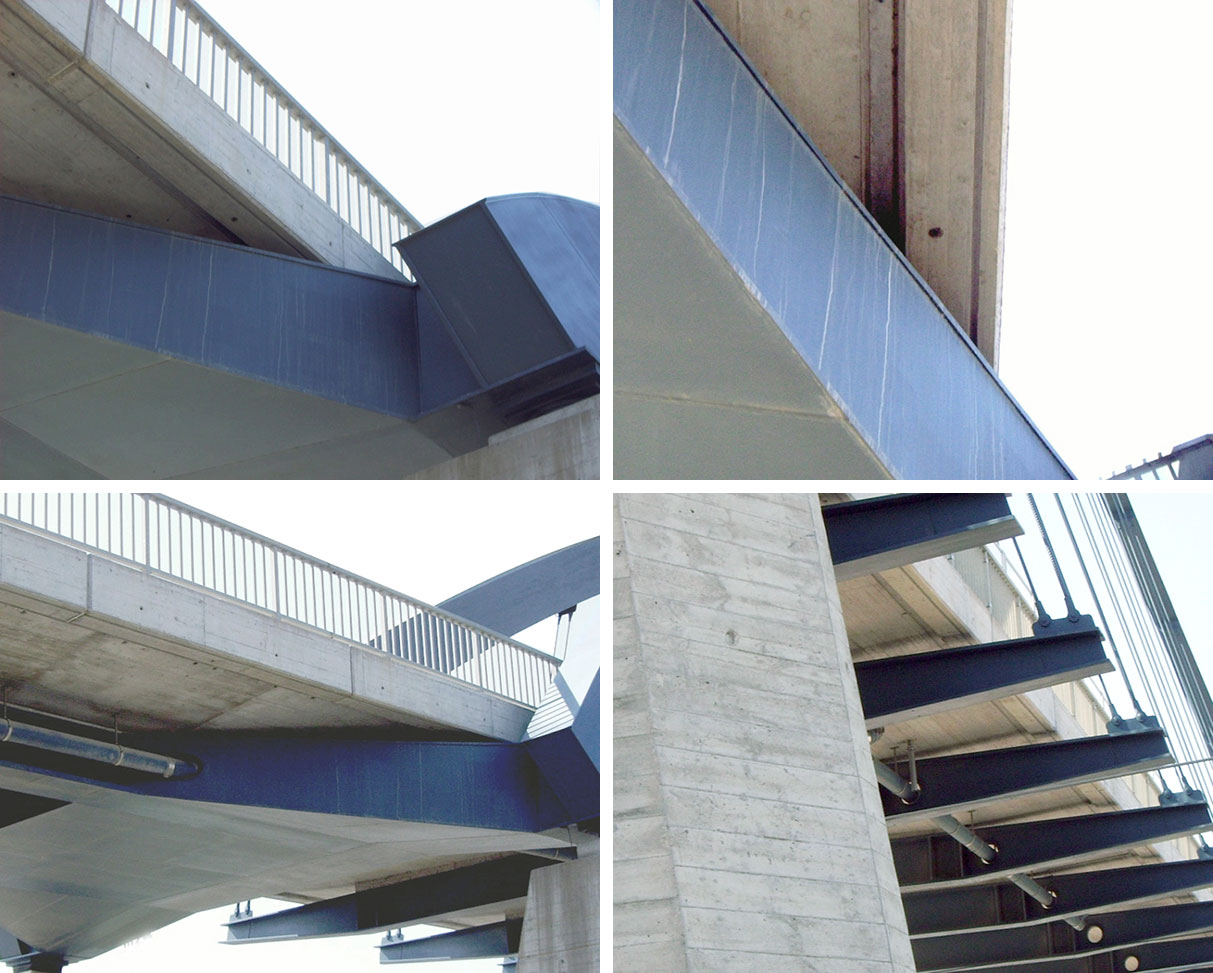 Swinging, video stills
Swinging, video stills
Credits:
Concept | edit | sound design: Michaela Schwentner
Supported by:
BKA / innovative film
la petite illusion
A 2006 / Video / 4:3 / colour / sound / 4 min
Sound: Michaela Schwentner
A little story of passions is told in
La petite illusion: heavy breathing garnished
by a jazzy bass line, a kiss, a woman falls into water at night.
While the work's title is an ironic reference to Jean Renoir's 1937
La grande illusion, the association is a dead end: Neither the images
nor the soundtrack contains a direct quotation of Renoir's pacifist fable, nor is a similar motif touched upon. The patina of early sound film which is
celebrated in
La petite illusion stands as the sole vague connection to the
La grande illusion - the sound and the look, the aesthetic
stereotypes of Francophone cinema made between the wars.
Schwentner's chromatically ascetic electronic manipulation of found sounds and images is a study of emotional images from the history of cinema which
is carefully kept in the air. The story told in
La petite illusion is itself a kind of little illusion: It has the mere suggestion of a plot, a kind of
mini-melodrama with built-in interference. While the narrative lines remain unresolved, irrationally linked as if in a dream, the film's images
themselves become unstable: They seem to melt, run into one another; just after coming together they fall apart, speed up, slow down, hammered with the artist's
omnipresent influence.
Animated Cubism is the term she gave to her work method: The flat film images are committed to a virtual digital space,
a different kind of illusion, and the material is released into a state of partial abstraction. In the referential space, filled with romantic ruins of images,
fragments of emotional declamation and salon conversation in French, with canned music and the bright singing of anonymous film divas, emotions are transformed
into signals, and the individual parts of trivial film tragedies are translated back into neutral cinematic symbols. (Stefan Grissemann)
Screenings (selection): VIENNALE 2006, Diagonale Graz 2006, Crossing Europe Linz 2006, VIENNALE 2020 (Recycled Cinema)
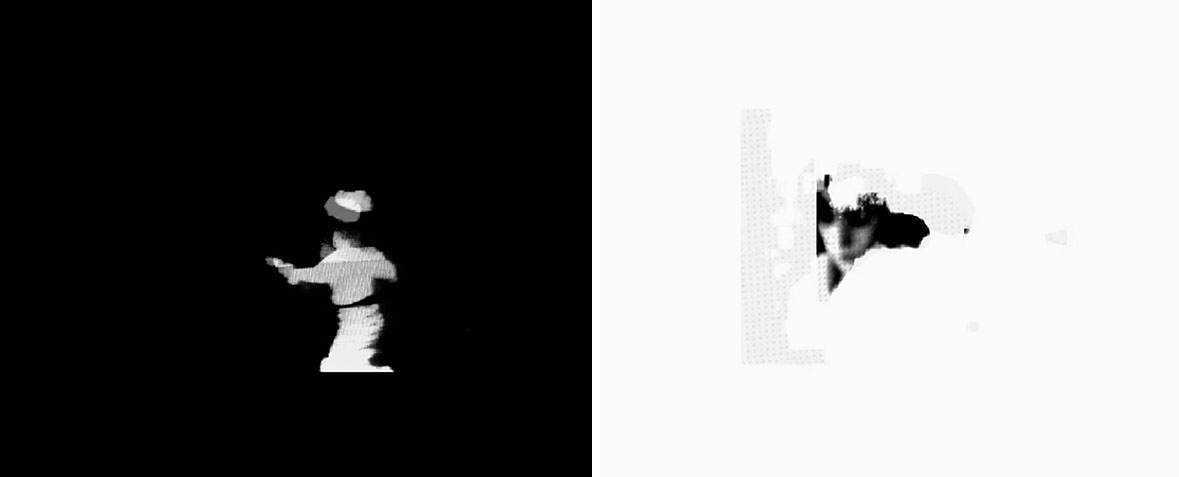 La petite illusion, video stills
La petite illusion, video stills
der kopf des vitus bering
A 2004 / Video / 4:3 / b/w / sound / 5 min
Sound: Wallner.Stotz.Remsing
When Vitus Bering completed his circumnavigation of northeast Asia on August 13, 1728 to prove that Asia and America are
two separate continents, the coast of America was covered in fog and remained largely invisible to the discoverer.
On the tracks of discovery and at the same time groping through the dark; a confusing state, the various levels of which are made
evident in Michaela Schwentner's video the head of Vitus Bering. The picture shows the black silhouette of a landscape emerging from a brilliant white.
The landscape is grouped on a horizontal and in some places also on a vertical axis. It changes, seems to oscillate between various aggregate states.
Forms become visible or invisible; colors fluctuate between white-gray-black. A type of fata morgana in a desert of ice.
Also the sound and the text make reference to a state of madness - or at least heightened sensibility; the violin bows are tense, the voices
entangle and distort.
Konrad Bayer's text
Der Kopf des Vitus Bering (1958 ff), which provides all of the quotations,
is Schwentner's immediate reference point. Bayer is interested in the figure of Bering as a location from which relations can be created
and quotes André Breton, according to whom reality is not the sum of the facts, but rather, the sum of possibilities.
Bayer's text is a mosaic of facts, thus on the one hand history – and on the other, thoughts and speculations, mounted according to
strict rules. He creates a dense atmosphere whose quality lies in the gaps that hold the knowledge of wealth, of reality.
Also Schwentner's video breathes this intensity; text, sound, and image combine to something greater than the sum of what happens and
what is heard. It presents the abundance in its emptiness. (Sylvia Szely)
 Der Kopf des Vitus Bering, video still
Der Kopf des Vitus Bering, video still
giuliana 64:03
A 2003 / Video / 4:3 / b/w / sound / 3 min
Sound: Michaela Schwentner
On a white background, black rectangles fall from the left upper edge of the picture. They amass to form larger surfaces,
to then immediately thereafter shrink or shift on top of one another, and from time to time be lifted off each other by thin white lines.
Similar to the cinema screen, the rectangular surfaces carry the schematic, digitally processed image of a woman, which is difficult to recognize as such.
Instead, its large-pixel outline merges with the abstract forms, which constantly form anew. Like in a puzzle, individual facial details show up in different places;
the various parts are continually put together, yet without ever revealing a completed picture.
The stark, reduced soundtrack, which stems from Antonioni's
Il deserto rosso, as does the initial visual material,
emphasises the clarity of the images and opens the gaze to the constantly changing forms.
The face – reduced to flickering black and white areas – takes its place in this strict composition. At one point, the picture becomes
almost completely black from the steady overlapping of different layers. Shortly thereafter, the schematic contours of the face push
into the field of vision. In the end it seems to have almost won out over the abstract forms. This impression is supported by the
replacement of the noise on the soundtrack with human voices. However, before the music (which begins suddenly), can spread out, and the
black and white contours become completely recognizable as the reproduction of a human form, they turn quickly to the side and the
picture disappears into the blackness. (Corinna Reicher)
Screenings (selection): Avanto Festival Helsinki 2003, Diagonale Graz 2004, Crossing Europe Linz 2004
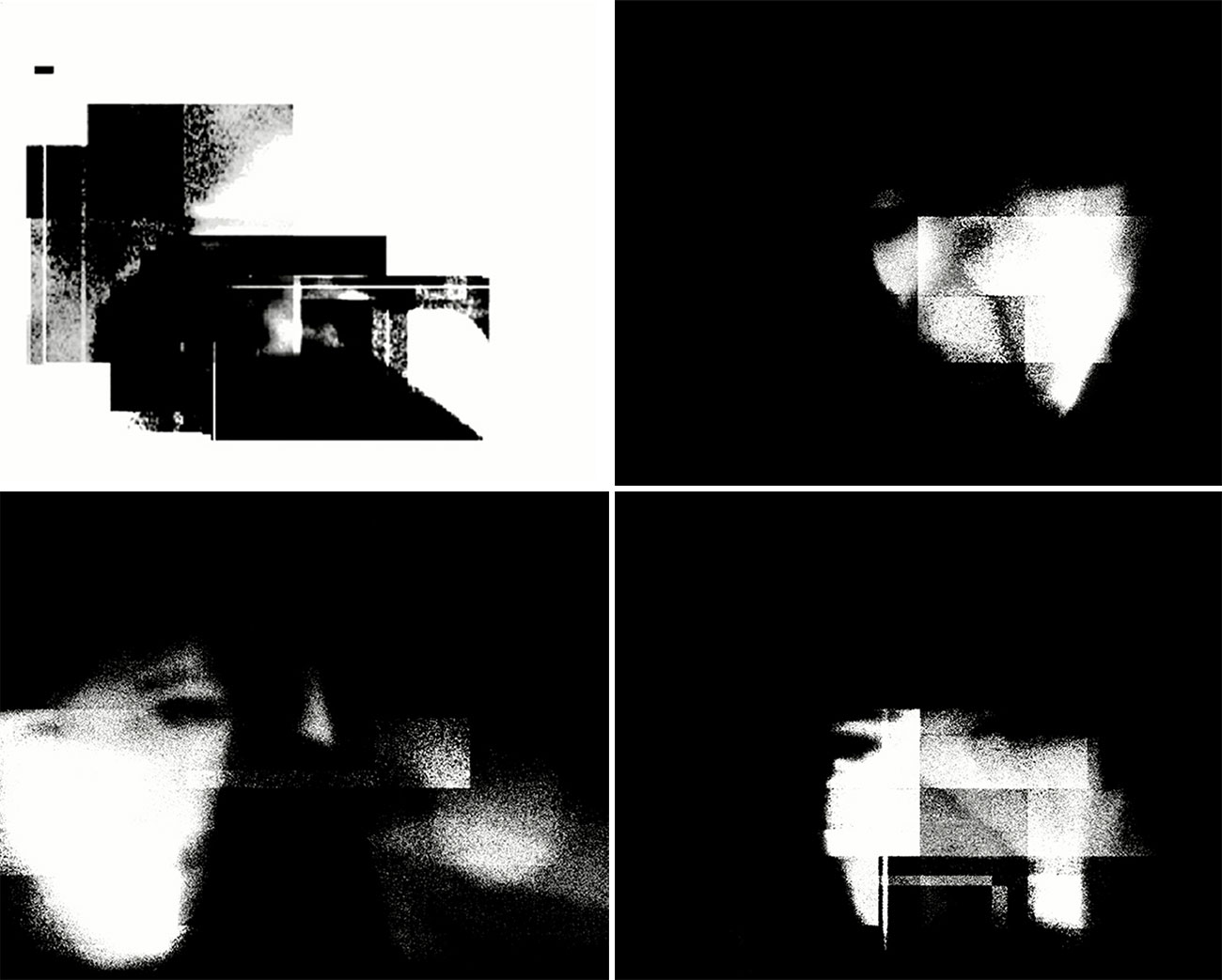 giuliana 64:03, video stills
giuliana 64:03, video stills
XX Y X –
a series that provides a platform for local
and international female and non-binary artists
and musicians who oscillate between musical
and artistic genres and explore the boundaries
of art, film and sound production. Within
this framework various forms of multimedia
performances are presented.
27 01 2026
Mysterious Signals
Live performance by
Hui Ye and
Ricarda Denzer
echoraum, Vienna
28 04 2026
Adina Camhy
Live performance
echoraum, Vienna
XX Y X Archive
07 10 2020
FRANZ STUTTGART (
Billy Roisz &
Anat Stainberg)
Highlights and Headaches
Live radio play
echoraum, Vienna
13 10 2020
Michaela Schwentner:
ASSEMBLY (black chair issue)
Durational performance and spatial intervention
dj set
Lumplecker, live set
Brigitta Bödenauer
echoraum, Vienna
20 10 2020
Electric Indigo,
CHRA
Solo shows
Grillx, Vienna
08 04 2021
Maja Osojnik:
Waiting it out
Solo show
08-29 04 2021
Follow me
Solo exhibition
partly closed due to extended covid lockdown
echoraeume online stream, Vienna
20 04 2021
A – B
Agnes Hvizdalek: 60°27'04.7"N 5°25'57.5"E
voice, violine
Billy Roisz: 47°50'31.1"N 16°53'06.3"E
electronics, double bass
Sound performance
echoraeume online stream, Vienna
25 05 2021
Cherry Sunkist/Karin Fisslthaler:
WOMEN*
A/V live performance
echoraum, Vienna
15 06 2021
Maiken Beer:
Bei mir
Solo show
Barbis Ruder:
Mundstücke v1
Performance
echoraum, Vienna
22 09 2021
Michaela Schwentner:
Le Banquet
Installation + performance
Martin Brandlmayr:
Vive les fantômes
Solo show
echoraum, Vienna
19 10 2021
DIE EX-GEWICHTSHEBERIN
(
Sabine Marte &
Oliver Stotz)
A/V live performance
echoraum, Vienna
26 01 2022
Rdeča Raketa + Patrick K.-H.
… and cannot reach the silence
Live show + video
echoraum, Vienna
18 03 2022
Nicole Six & Paul Petritsch:
ECHORAUM
Light installation
Lissie Rettenwander:
FÜR XX Y X IM ECHORAUM
Sound performance
echoraum, Vienna
05 04 2022
Anna Lerchbaumer:
SONIC SHRINE
Sound installation
Rojin Sharafi &
Iris Blauensteiner:
ATEMHAUT
Text & sound performance
echoraum, Vienna
03 05 2022
soundsongnoisesilence
Screening
Films by
karø goldt,
Annja Krautgasser,
Tatiana Lecomte, Michaela Schwentner
echoraum, Vienna
01-10 06 2022
Michaela Schwentner:
Reconstruct, she said
Installation
07 06 2022
Julia Purgina: sound performance
sehsaal, Vienna
08 06 2022
Gischt,
Innode
Live shows
Westbahnstudios, Vienna
21 06 2022
Billy Roisz & Karolina Preuschl
... maybe audience decide
An optophonic revue, sounds, voice, moving image, still and everything inbetween
echoraum, Vienna
25 10 2022
VOICES
Screening
Films by
Ana Hoffner,
Sabine Marte,
Iris Blauensteiner, Michaela Schwentner
dj set
Lumplecker/
school
echoraum, Vienna
31 01 2023
season opening
Iris Dittler: APNOE (Installation & Performance)
Daniela Palma Caetano Auer: Celestial Objects: Singularities (Graphiken)
echoraum
28 03 2023
SALON LIMUSIN
Aurora Hackl Timón, Tanja Fuchs, Theresia Emm, Tamara Imlinger
echoraum, Vienna
18 04 2023
RAUM FÜR NOTIZEN –
conceived for an ex-GDR border watchtower in Berlin Treptow, summer 2022
Karø Goldt (Berlin/ video, notes) & Otto Hashmi (London/ flute, composition)
echoraum, Vienna
21 04 2023
VOICES & SOUNDS
Sound performance & screening
Exposition 01.03 by Maja Osojnik
re-BIRDING by Michaela Schwentner
Sehsaal, Vienna
30 05 2023
Maria Peters & Vera Sebert
Wir fühlen uns bemüssigt – a multimedia performance
pt. 1
Fluid Features Of A Visual Apparatus
Software-based media montage by Vera Sebert
pt. 2
Please Consider Me A Budgie Today
Performance by Maria Peters
echoraum, Vienna
02 06 2023
XX Y X / ORF musikprotokoll im steirischen herbst / OE1 Kunstradio cooperation:
Presentation of 2 Shape+ Artists in Residence
Thea Soti – performative installation
w/ Christine Schörkhuber & Verena Dürr
in the frame of
Independent Space Index Festival
kluckyland, Vienna
Sonic Exegesis (Yara Mekawei, Ulla Rauter, Hui Ye)
on the occasion of 30 years of Zeit-Ton
Radiokulturhaus, Studio 3, Vienna
20 06 2023
Katharina Ernst
le temps_____
a solo for drums and metal objects in five states
Finissage of the exhibition
So Many Ways
echoraum, Vienna
12 09 2023
Karo Preuschl
FRAGMENTS
Solo performance
echoraum, Vienna
07 11 2023
Christina Ruf
Issues of Time, Space and Dreams
Solo show
Anna Katharina Laggner reads from
Bewunderung (Female Positions) and
Fremdlinge (Residenz Verlag)
echoraum, Vienna
05 12 2023
Motorherz (Christine Schörkhuber & Verena Dürr)
Sound sculpture & audio piece
echoraum, Vienna
09 01 2024
IMAfiction Portrait #10 Elisabeth Schimana
Screening
Elisabeth Schimana & Igor Gross
Virus #1.3 Mutation for percussion solo
Live performance
echoraum, Vienna
19 03 2024
Michaela Schwentner Wechselwirkung (2020-21)
Screening
Pia Palme & Sonja Leipold
Vanishing Shores
Live performance
echoraum, Vienna
09 04 2024
Hanna Schimek and Angelica Castello
SYRINX AND PAN
Live performance
echoraum, Vienna
21 05 2024
IMAfiction Portrait #08 Electric Indigo
Screening
Electric Indigo
Under Way Elastic
Live performance
echoraum, Vienna
08 06 2024
Sara Zlanabitnig & Anat Stainberg
A CHAT
Live performance
echoraum, Vienna
11 06 2024
IMAfiction Portrait #04 Maryanne Amacher
Screening
Merche Blasco
Fauna
Live performance
echoraum, Vienna
24 09 2024
IMAfiction #07 / #02
Anne la Berge + Rebekah Wilson
Screening + live performance
echoraum, Vienna
15 10 2024
IMAfiction #09
Beatrice Ferreyra
Screening
echoraum, Vienna
Live performance: Beatrice Ferreyra
Acousmatic Festival Vienna, Schauspielhaus, Vienna
12 11 2024
IMAfiction #03 / #05
Heidi Grundmann / Andrea Sodomka
Screening
Live performance: Andrea Sodomka
echoraum, Vienna
03 12 2024
IMAfiction #01
Liesl Ujvary
Screening
Live performance: bb
echoraum, Vienna
21 01 2025
IMAfiction #04
Eliane Radigue
Screening
Live performance: Pia Palme & Rhodri Davies play Eliane Radigue
echoraum, Vienna
29 04 2025
IMAfiction #09
Beatrice Ferreyra
Screening
Live performance: Marta Beauchamp
echoraum, Vienna
20 05 2025
2 films by Miriam Bajtala
Screening
Live performance: chra
echoraum, Vienna
21 10 2025
Cordula Daus
SEHR reading performance
Nina Bauer
NATURAL HYBRID live performance
echoraum, Vienna
25 11 2025
M.O.G. (MOTHERS OF GOD /
Katrin Plavčak & Ulrika Segerberg)
Screening of video works by
Ulrika Segerberg
Live electronics on sewing-machines
echoraum, Vienna
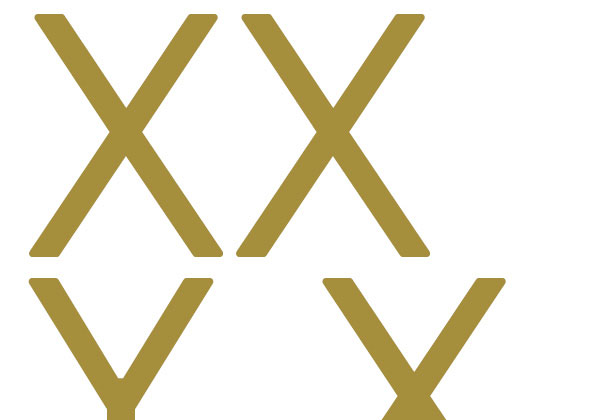
OFF_screen
Why not hold discussions about unfinished works? What would it be like to offer film and video makers the opportunity to discuss
their stagnating projects and the difficulties in the working process? How could a successful dialogue be created that benefits everyone present?
With OFF_screen, we want to install an open format for discursive conversations about unfinished works in the cinema context.
The presentation of the work and the discussion about it are intended as catalysts for a reflexive examination of that part of the work process
in the context of the moving image that usually remains invisible. This provides insights into the different artistic practices and approaches,
but also into the difficulties and challenges of artistic creation.
At the centre of the event is a decisive question about a problem that is blocking the work process, which the filmmakers pose to the invited
panel and the audience. An artist selects an unfinished video or film work that he or she would like to present for discussion, possibly an
excerpt that is perceived as particularly difficult. They then formulate an important question. The invited panellists receive the video and the
questions in advance and have enough time to prepare for the discussion. The semi-public discussion is ultimately about a debate at eye level,
i.e. giving moderated feedback, constructive criticism and not acting with regard to one's own positioning and possible hierarchies.
The relevant question is negotiated in a protected space. The discussion is then extended to include the audience present.
The guests/discussion participants should come from different fields: Artists, curators, critics, theorists as well as thematic experts and/or
representatives of the audience who are not professionally involved with film art.
After the respective discussion round on a film or video artist and the addition of further work steps, a selection of discussed and revised film
artworks could subsequently be presented to a larger audience in the cinema.
The event will be held online twice a year. This enables an extended radius with regard to the participants in the discussion.
A physical presentation event of selected and further developed works is supposed to take place once a year.
Our successful cooperation with
Blickle Kino Wien/Claudia Slanar continues with a new cooperation with
the
Academy of Fine Arts Vienna/IKW/Sabeth Buchmann.
Next event: December 10, 2024
Artist:
Heidrun Holzfeind
Panel:
Maia Gusberti,
Patricia Grzonka,
Rainer Komers
Organiser and moderator: Michaela Schwentner
Past events:
June, 2024:
Artist:
Guillaume Cailleau
Panel:
Marc Glöde,
Michaela Wünsch,
Florian Wüst
Organiser and moderator:
Karø Goldt
Sept, 2022
Artist:
Annja Krautgasser
Panel:
Sabine Bitter,
Sabeth Buchmann,
Ricarda Denzer,
Axel Stockburger
Organiser and moderator: Michaela Schwentner
June, 2022
Artist:
Corinna Belz
Panel:
Bettina Henkel,
Monika Preischl,
Andreas Spiegl
Organiser and moderator:
Amina Handke
Nov, 2021
Artist:
Sabine Reinfeld
Panel:
Sophie Thun,
Savannah Thümler,
Kerstin Cmelka, Andreas Schulz
Organiser and moderator:
Karø Goldt
VISUALISATION OF SOUND / COMPOSITIONS
w/ Paul Clouvel (Elektra Music)
Elements II
2013 / Video / 4:3 / bw / sound / 8 min
Canranc
2010 / Video / 4:3 / colour / sound / 12 min
Speech
2009 / Video / 4:3 / colour / sound / 8 min

w/ Radian
Tester
2004 / Video / 4:3 / colour / sound / 6 min
Jet
2003 / Video / 4:3 / colour / sound / 6 min
r4
2000 / Video / 4:3 / bw / sound / 5 min
Transistor
2000 / Video / 4:3 / bw / sound / 5 min
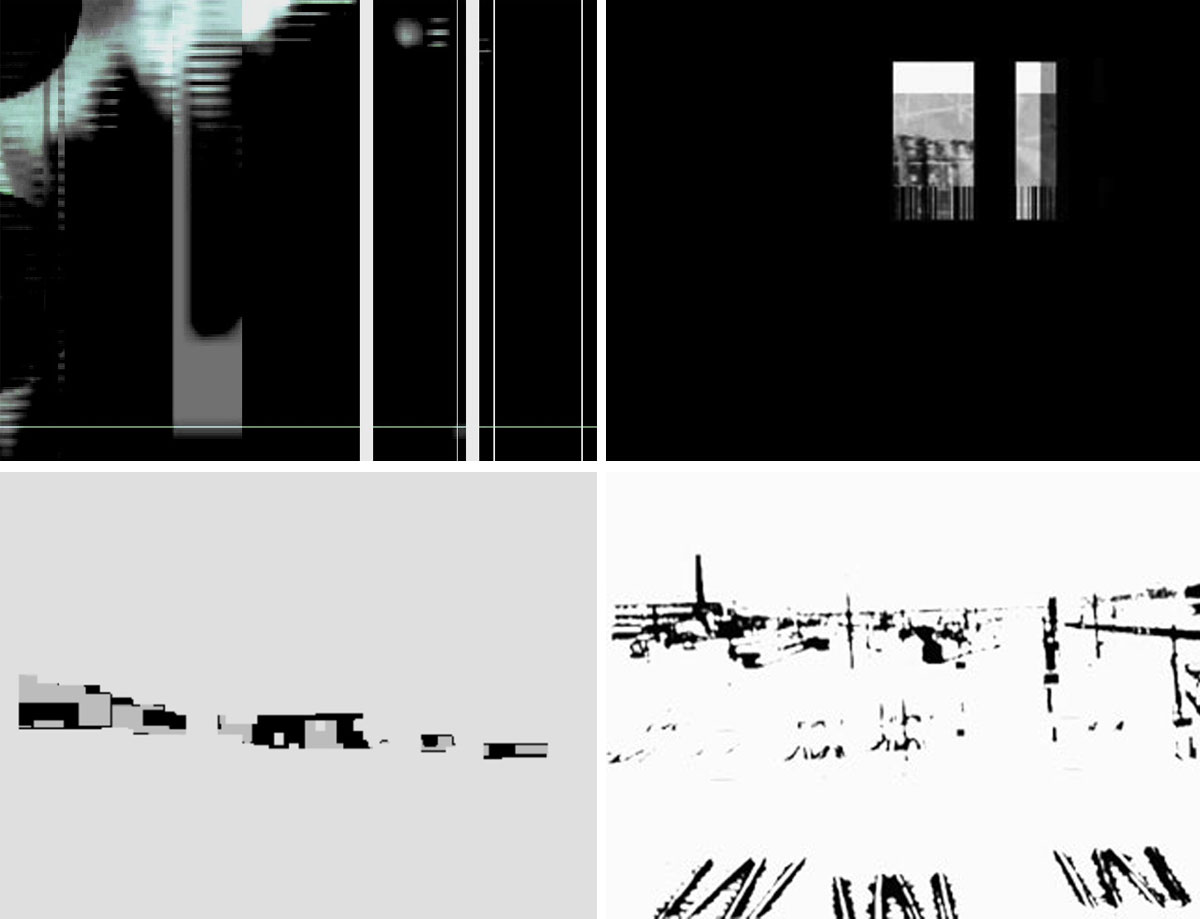 Watch an excerpt of Transistor on vimeo
Watch an excerpt of Transistor on vimeo
w/ various
the future of human containment
2001 / Video + 35mm / 4:3 / bw / sound / 4 min
Sound: Pure
Screening at Sundance Independent Film Festival /
Section New Frontiers 2003
Supported by: BKA / innovative film
tucker
2004 / Video / 4:3 / colour / sound / 6 min
Sound: Charmant Rouge
How do you want M.?
2003 / Video / 4:3 / colour / sound / 4 min
Sound: Heinz Dietsch
forests of the moon
2003 / Video / 4:3 / bw / sound / 3:30 min
Sound: Sluta Leta
take the bus
2002 / Video / 4:3 / bw / sound / 4 min
Sound: General Magic
#Z
2001 / Video / 4:3 / colour / sound / 6 min
Sound: Fennesz

Imprint



























































































